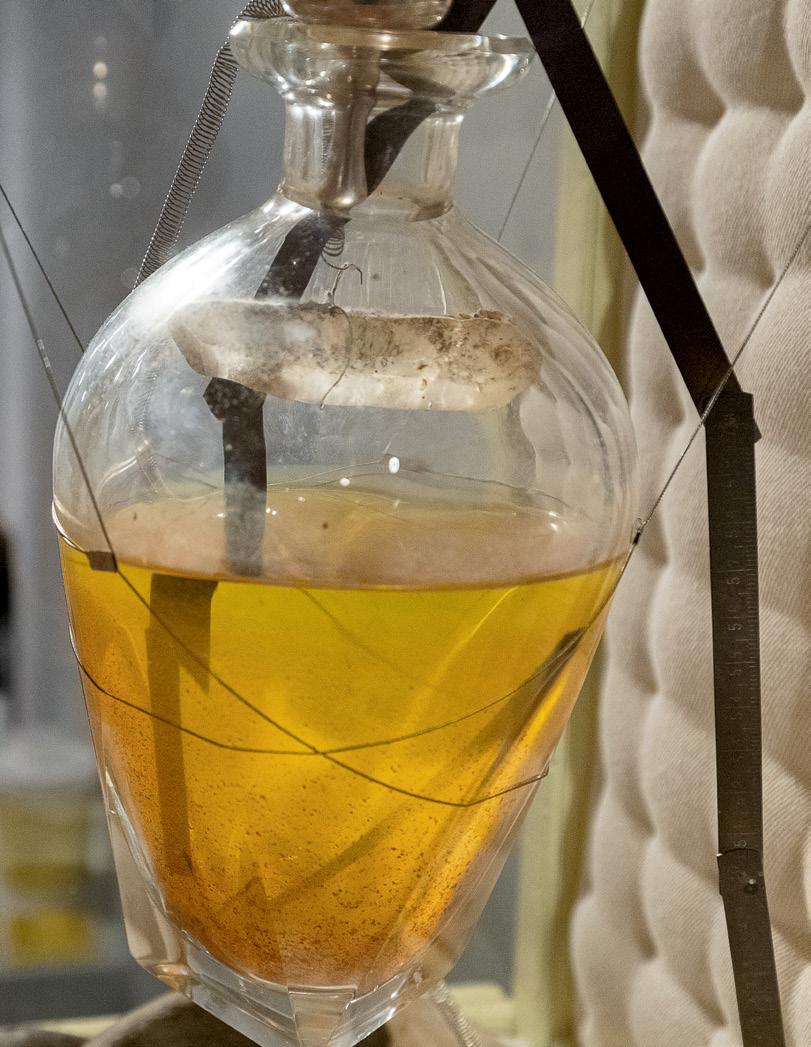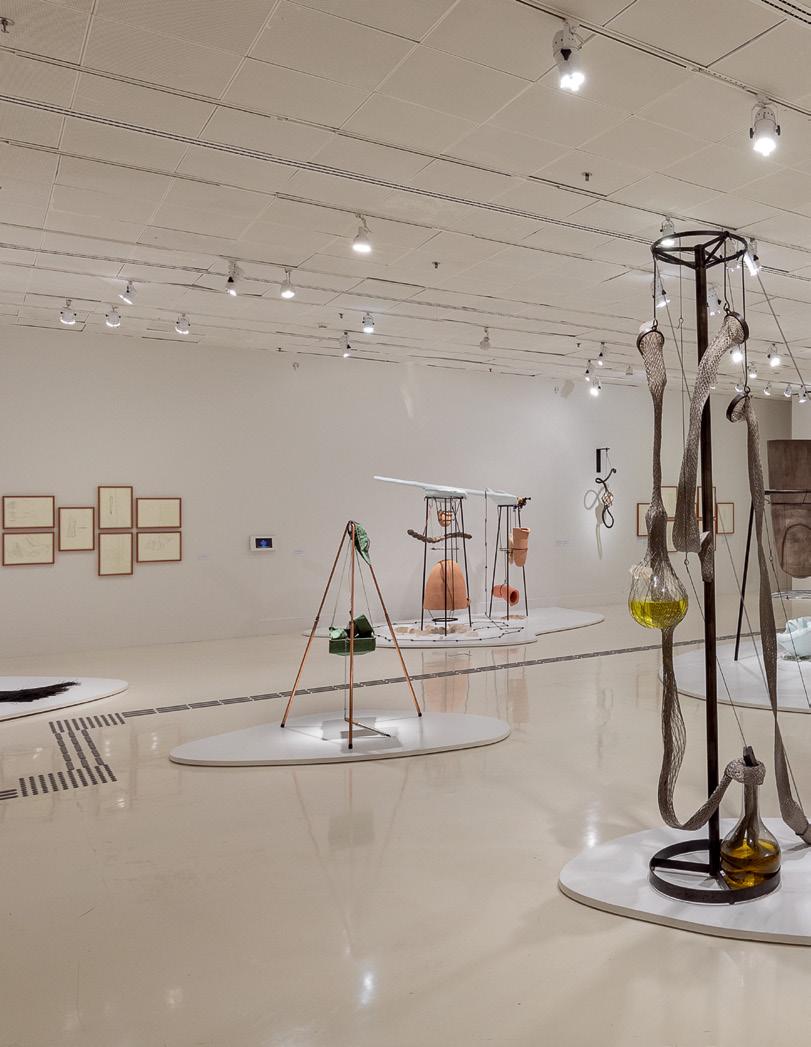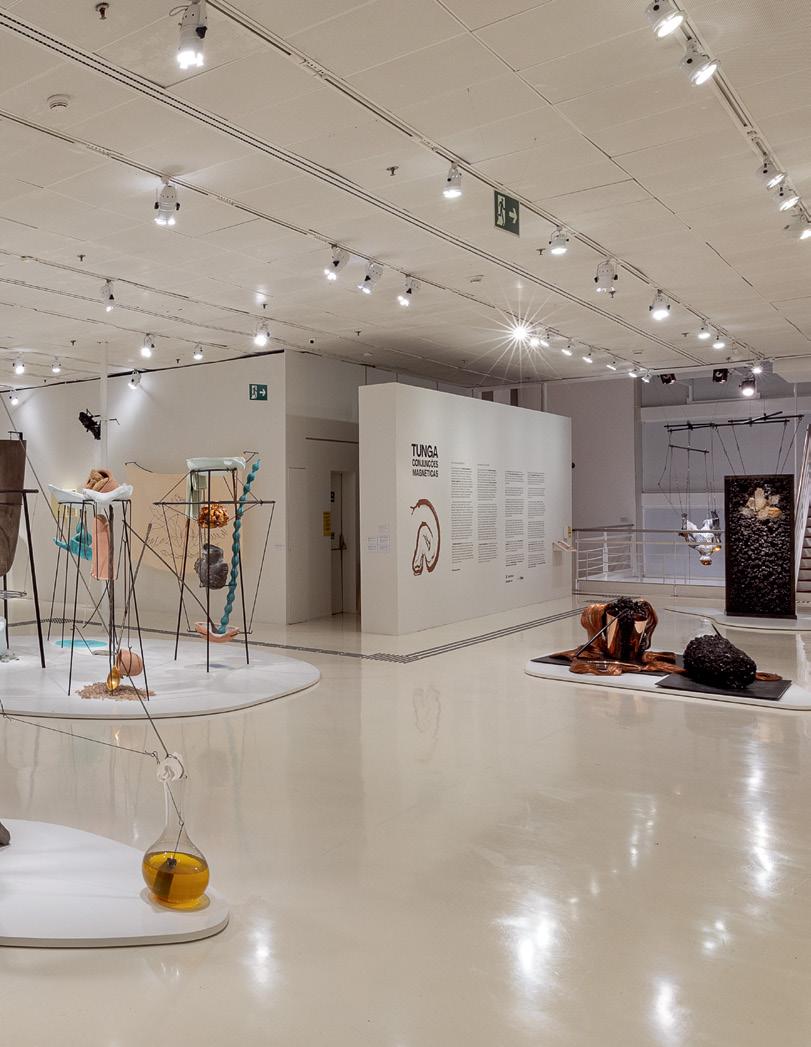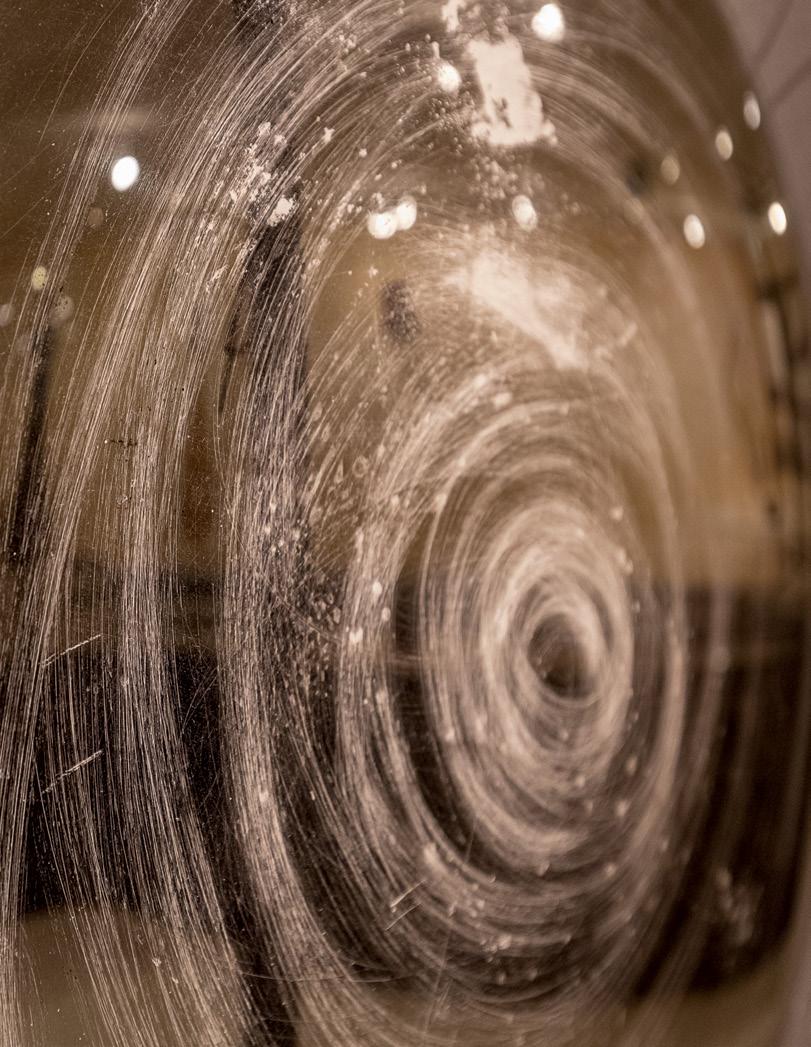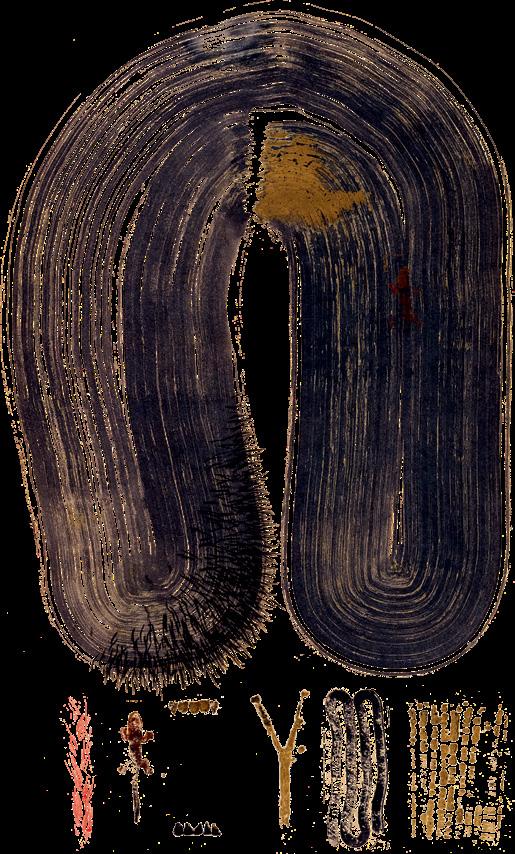














Com um universo imaginativo único e uma produção refinada, Antônio José de Barros Carvalho e Mello Mourão (1952-2016), o Tunga, é um artista emblemático e relevante das artes visuais do país. Para celebrar sua obra, o Itaú Cultural (IC), em parce ria com o Instituto Tunga e o Instituto Tomie Ohtake, realizou a exposição retrospectiva Tunga: conjunções magnéticas.
Tunga se formou em arquitetura e urbanismo em 1974, mesmo ano em que realizou sua primeira exposição indivi dual, no Museu de Arte Moderna do Rio de Janeiro (MAM Rio). No efervescente final dos anos 1970, conviveu e dialo gou intensamente com grandes nomes das artes contemporâ neas, como José Resende, Waltercio Caldas, Cildo Meireles, Sergio Camargo e Lygia Clark – os três últimos já tema de exposições no IC.
Desenhos, esculturas, objetos, instalações, vídeos e performan ces. A diversidade de suportes revela os múltiplos interesses de Tunga, que percorria diferentes áreas do conhecimento, como literatura, matemática, arte e filosofia. A pluralidade também se fez presente no uso de materiais. De maneira notável, Tunga explorou ímãs, vidro, feltro, borracha, dentes e ossos. Sua obra ganhou simbologia e presença, aproximando-o da produção artística em evidência no panorama internacional.
A partir da década de 1980, o artista participou da Bienal de Veneza, teve quatro passagens pela Bienal de São Paulo e expôs em mostras no Museu de Arte Moderna (MoMA), em Nova
York, e na Whitechapel Gallery, em Londres. No Instituto Inhotim, em Minas Gerais, dois espaços destacam sua obra, a Galeria True Rouge (2002) e a Galeria Psicoativa (2012). Tunga é o primeiro artista contemporâneo e o primeiro brasi leiro a expor no Museu do Louvre, em Paris – com a obra À la Lumière des Deux Mondes (2005).
Parte dessa extensa produção está em Tunga: conjunções magnéticas. Além do IC, a mostra estende-se para o espaço do Instituto Tomie Ohtake, que recebe a escultura Gravitação Magnética (1987) – cujos esboços ocupam ambos os espaços culturais – e o filme-instalação Ão (1981).

Este catálogo traz as obras em exposição e um texto que apresenta a mostra, assinado pelo diretor do Instituto Tunga, Antônio Mourão, e pelo curador, Paulo Venancio Filho, que também contribui com um ensaio propondo uma reflexão aprofundada sobre as obras do artista. O IC e o Banco Itaú apoiam o projeto de um catálogo raisonné, que está sendo organizado pelo Instituto Tunga e deve ser lançado em 2024.
Desde 2010, o IC revisita, em mostras individuais, o acervo de artistas fundamentais para as artes visuais brasileiras. Esse conteúdo se expande no site itaucultural.org.br e na Enciclopédia Itaú Cultural de Arte e Cultura Brasileira.
Conheça conteúdos exclusivos desenvolvidos para a exposição Tunga: conjunções magnéticas
Apresentar a obra de Tunga em sua extensão, profundidade e integridade foi o que norteou a realização de Tunga: conjunções magnéticas. Com mais de 300 trabalhos em exi bição, muitos deles inéditos, a exposição é uma retrospectiva com as relações e os desdobramentos que se metamorfo seiam desde a década de 1970 – sua primeira individual foi em 1974, no Museu de Arte Moderna do Rio de Janeiro (MAM Rio) – até pouco antes do seu falecimento, em 2016.
Além do desenho, a inquietude artística de Antônio José de Barros Carvalho e Mello Mourão (1952-2016) o levou a outras práticas: esculturas, objetos, instalações, vídeos e performances . Esse conjunto de trabalhos revela a dimensão de seus múltiplos interesses, que transitavam livremente por diversas áreas do conhecimento, como arte, litera tura, ciência e filosofia. Grande parte da obra do artista se encontra sob a guarda do Instituto Tunga, que tem a res ponsabilidade de manter, divulgar e resguardar seu legado.
O espaço expositivo traz de maneira abrangente os momen tos mais significativos da trajetória do artista, sem qualquer tipo de hierarquia ou cronologia, fiel ao seu pensamento contínuo e circular, sempre se ampliando mais e mais. Ao apresentar a amplitude da obra em consonância com sua poética plástica, inspirada no conceito de “instauração” por ele proposto para as suas “instalações performáticas”, Tunga: conjunções magnéticas é uma exposição que
fisicamente se “instaura”, se é possível dizer, como uma verdadeira “obra”.
Tunga, como poucos artistas contemporâneos, explorou as mais diversas mídias e materiais como ímãs, vidro, feltro, borracha, dentes e ossos, impregnando-os de uma estranheza poética, não familiar. Por meio de sua peculiar prática metamórfica, propunha experiências artístico -poéticas díspares, heterogêneas e heterodoxas. Suas “instaurações”, instalações, esculturas e objetos buscam explorar tanto o apelo simbólico e físico dos materiais quanto sua articulação plástica e poética, e se encontram lado a lado com sua intensa obsessão pelo desenho. Esse, para Tunga, nunca foi apenas um esquema ou projeto, mas uma realização em si, indissociável e fundamental para a produção e a compreensão da totalidade do trabalho. Sendo assim, a prática do desenho como raciocínio e realização está presente na mostra em toda a sua extensão e relação com os trabalhos tridimensionais.
Tunga: conjunções magnéticas enfatiza a interação meta bólica, em constante dinâmica e mutação, entre mídias e materiais que se apresentam ao longo de quase meio século, característica fundamental de Tunga. E percorre sua exten são num conjunto de trabalhos que vão do início ao fim de sua obra e vice-versa, dobrando-se sobre si mesmo em cada um e em todos os seus momentos.
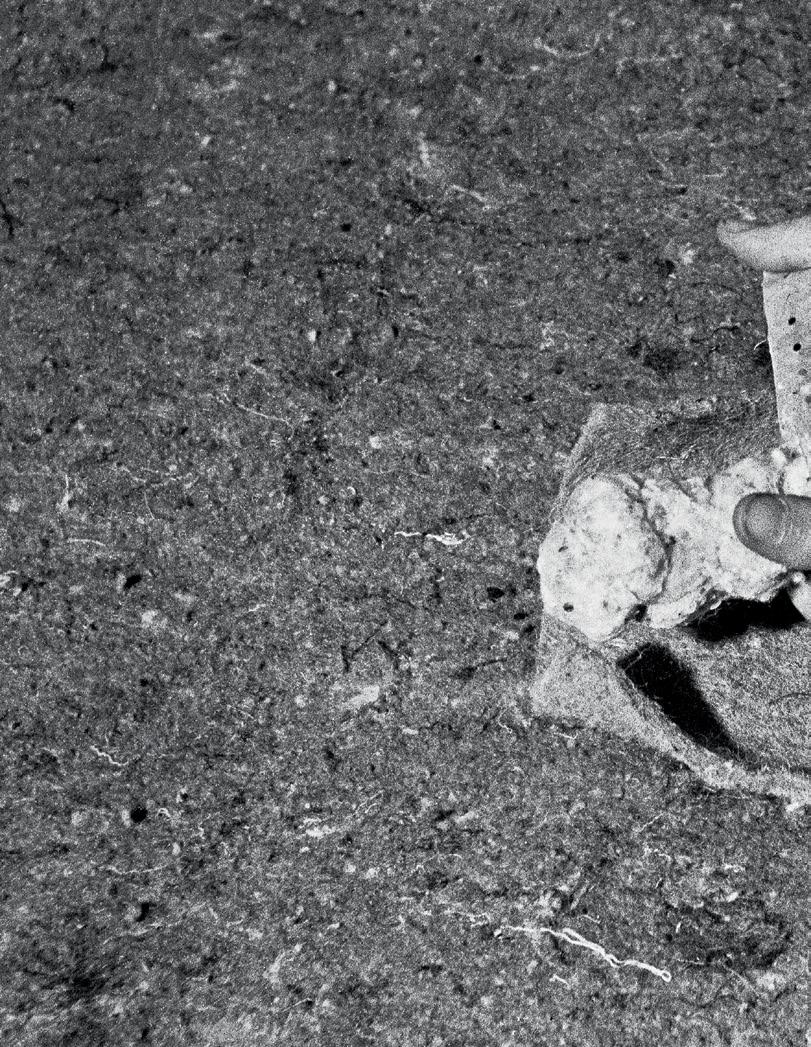
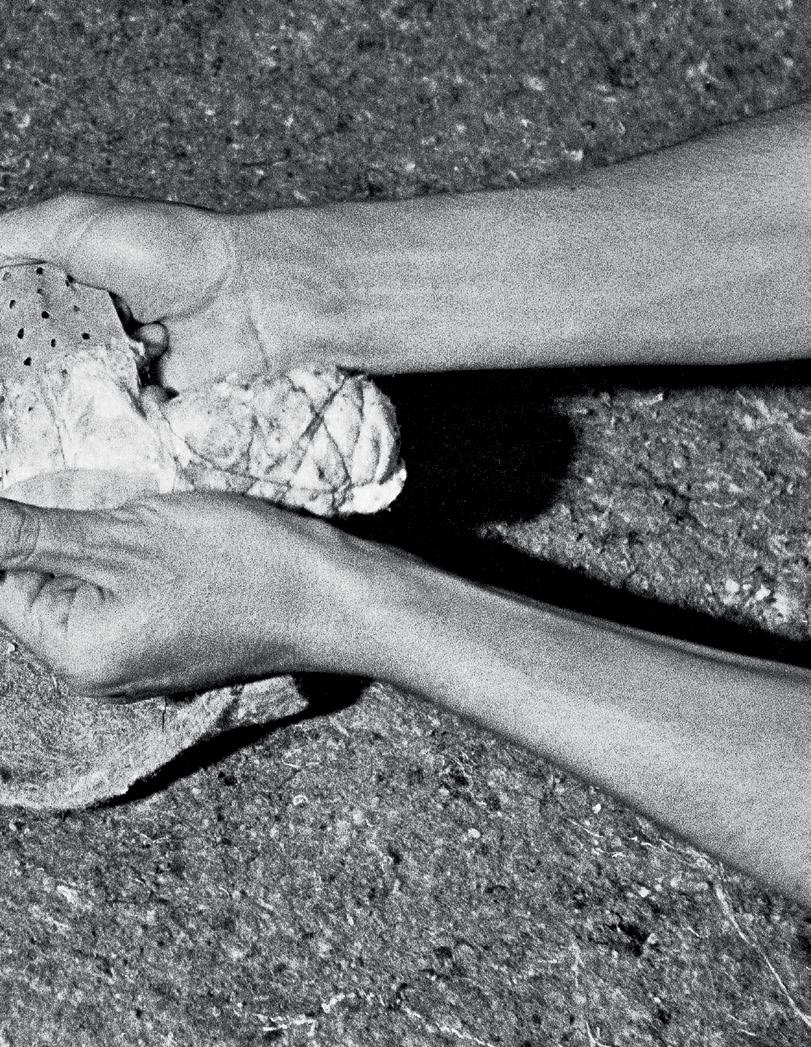

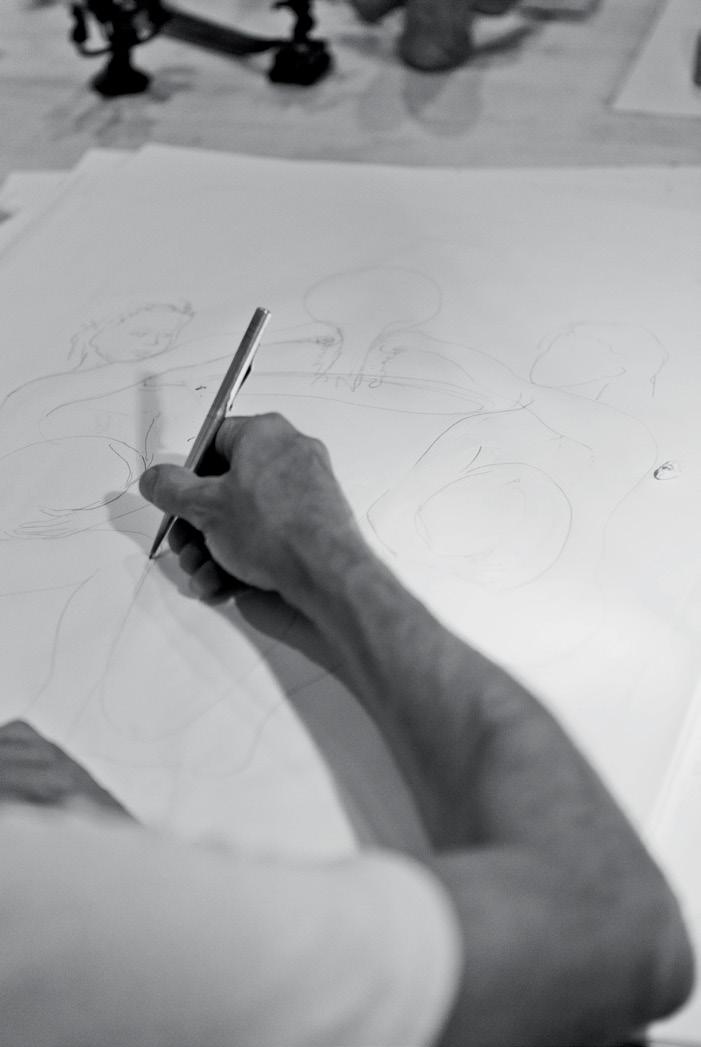
* As palavras em destaque ao longo do texto fazem parte de um glossário que agrega referências, termos e expressões próprias do artista. Confira nas páginas 45 a 54.
1. Tunga produzindo um desenho da série “From ‘La Voie Humide’” | Tunga producing a drawing of the series “From ‘La Voie Humide.’” Foto | photo: Gabi Carrera
A obra toda de Tunga se desdobra em torno do corpo nu. Reversível, o corpo é, simultaneamente, o gerador e o gerado. É uma duplicidade que se multiplica, atrai tudo para si e repõe num plano mais elevado, refinado, magnificado. Desenhos, objetos, instalações, escul turas, “instaurações”* são os diversos resultados desse processo – o desenho em primeiro lugar.
Nota 1. Le grand verre, ou La mariée mise à nu par ses celibataires, même (O grande vidro, ou A noiva despida por seus celibatários, mesmo), pintura em vidro de Marcel Duchamp, é dividida em duas partes. Na metade superior, a Noiva e, na parte inferior, a Máquina celibatária, em que se encontram os Malic Moulds, ou Moldes machos, impossibilitados de entrar em contato direto com a Noiva. A cena se concentra nas atribulações eróticas entre a Noiva e os Moldes machos e representa a summa visual duchampiana que se estende por uma complexa e extensa narrativa.
São eles que marcam o início da obra; inúmeros, resultado de uma prática constante, intensa, obsessiva, que vai prosseguir e determinar toda ela do começo ao fim. Sua primeira exposi ção – só de desenhos – ocorre em 1974, no Museu de Arte Moderna do Rio de Janeiro (MAM Rio), com o provo cante título de Museu da Masturbação Infantil . Ali se percebia claramente um desenhista em ação e uma vocação. Nos desenhos, que nada tinham de infantil ou de infantilizante, menos ainda de uma possível ingenuidade, aparecia, sobretudo, a manifesta ção de uma energia libidinal solta,
desinibida, indicada no sugestivo título da exposição – audacioso, provocante, intrigante para uma mostra de dese nhos abstratos tão intimistas, quase esboços inacabados do que propria mente desenhos. Alguns minúsculos, tendendo mais à invisibilidade do que a se dar a ver, como se nos obrigassem a nos aproximarmos com uma lupa para dar conta da sua frágil e delicada aparência, apenas imersa e diluída no papel, vindos de um fluxo ainda inominado, primeiras emanações de uma energia vital transbordante. Tão intrigantes figuras que recordam, por afinidade, La mariée da cena erótica de Le grand verre , ou La mariée mise à nu par ses célibataires, même 1, de Marcel Duchamp (1887-1968), tão admirada por Tunga. É para aí que se sentia atraído, para o “outro” Duchamp, aquele da imagérie erótica não literal, insinuada por figuras desprovidas de um apelo sensual do senso comum – cosa mentale , poderia se dizer. Portanto, são desenhos já informados de uma distinta genealogia
visual heterodoxa. Na mesma exposi ção, outro ritmo gestual diferenciava uma série de desenhos que se distin guiam enérgicos, nos quais o preto do nanquim predominava em rastros ejaculatórios de um movimento rápido dando vazão ao líquido e sua expansão livre pelo papel. Desenhos abstratos, sim, mas antes pulsações que encon tram seu termo último na afirmação da descarga gestual que percorre início e fim, sem adições ou correções, minuciosamente. Figuras ainda sem nome, embora exibidas sob títulos, não menos intrigantes: O Perverso, Pensamentos, Máquinas , Charles Fourier e Paisagens do Desejo . Entre eles, esse extravagantemente anacrônico, o que se refere a Charles Fourier (17721887), o socialista utópico das socieda des eróticas do século XVIII. Um nome que, como outros, indicava já o enre damento que a obra de Tunga manteria em toda a sua trajetória com aspectos radicais da cultura francesa, seja nas artes plásticas, na literatura ou na filo sofia. Fourier comparecia para nomear uma série de desenhos eminentemente contemporâneos e, naquele início, indicava uma afinidade eletiva que se reuniria a outras companhias ao longo de toda a sua obra.
Fourier era apenas um que o trabalho de Tunga trazia para si e, assim, expunha francamente aquilo cuja amplitude iria expandir incessantemente fazendo associações cada vez mais audaciosas e imaginativas, aproximando distâncias no tempo e no espaço. A vocação definida – desenhista em primeiro lugar e em toda a sua trajetória artística – colocava Tunga na geração dos artistas que emer giram nos anos 1970, quando o desenho
predominava, e que ascenderam a outro degrau de importância artística no Brasil. Entretanto, nessa geração ocupa um lugar bastante singular, singularís simo – é preciso aqui usar o superlativo. Seus primeiros desenhos abstratos levam a crer num anacronismo, quiçá deliberadamente deslocado do seu tempo e da sua geração. A gestualidade delicada, lenta ou rápida, econômica nas cores qualificava essas pequenas imagens sutilmente expressivas. O negro do nanquim, homogêneo e maleável, visualmente pesado, como que anteci pava a matéria escultórica que viria a seguir.
A exata indefinição conduzia ao informe ou disforme do improviso gestual, ora se aproximando, ora se afastando de uma improvável figura – entre mancha e figura –, oposições que teriam vida longa em toda a obra. Nessa dimensão reduzida de sua abstração, percebia-se que transitava por Henri Michaux (1899-1984), grande poeta, artista um tanto inclassificável, cujos desenhos mais famosos tinham sido feitos sob o efeito da mescalina; por André Masson (1896-1987), surrealista heterodoxo ligado a outro também um tanto à margem e eventual dissidente do movimento, o escritor Georges Bataille (1897-1962), leitura frequente de Tunga e a admiração de seus tempos de juven tude; por Roberto Magalhães (1940), que revitalizou o desenho no final dos anos 1960; e, por fim, pelo Duchamp desenhista eventual. De tais artistas veio, mais tarde, a possuir trabalhos, em reconhecimento à sua admiração e à sua dívida juvenil.
Nesses nomes percebem-se a escolha e o valor que ele dá a certa lateralidade
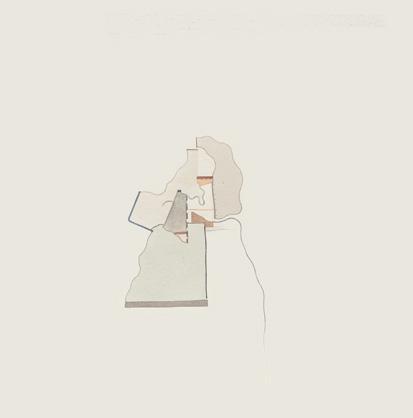
The Bride (Noiva),
1965-1966 gravura | print 26,7 × 11,9 cm Doação de | gift from Milton e | and Rosemary Okun Foto | photo: ©2022. Imagem digital do | digital image of Whitney Museum of American Art, licenciada por | licensed by Scala ©Association Marcel Duchamp/AUTVIS, Brasil, 2022
3. Sem título | Untitled, ca. 1970 aquarela sobre papel | watercolor on paper 34,5 x 34,8 cm Acervo | collection Instituto Tunga Foto | photo: Gabi Carrera
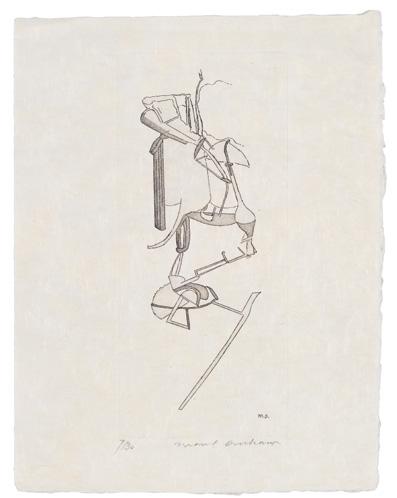
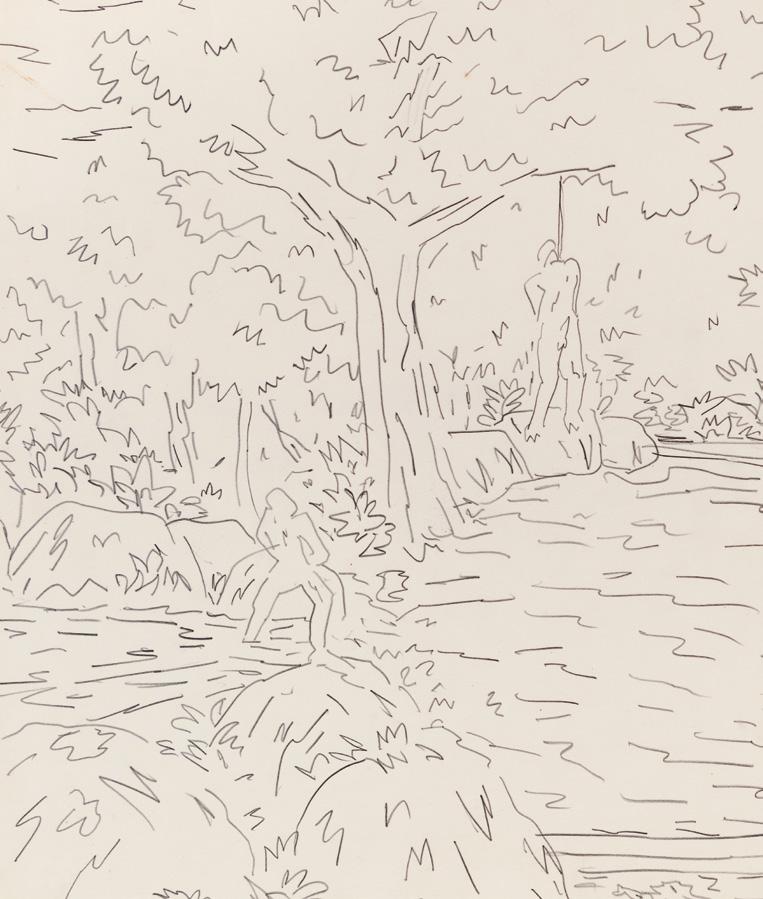
4.
Sem título | Untitled, 1979-1983 grafite sobre papel | graphite on paper 48,5 x 66 cm Acervo | collection Instituto Tunga Foto | photo: Gabi Carrera Acervo Instituto Tunga
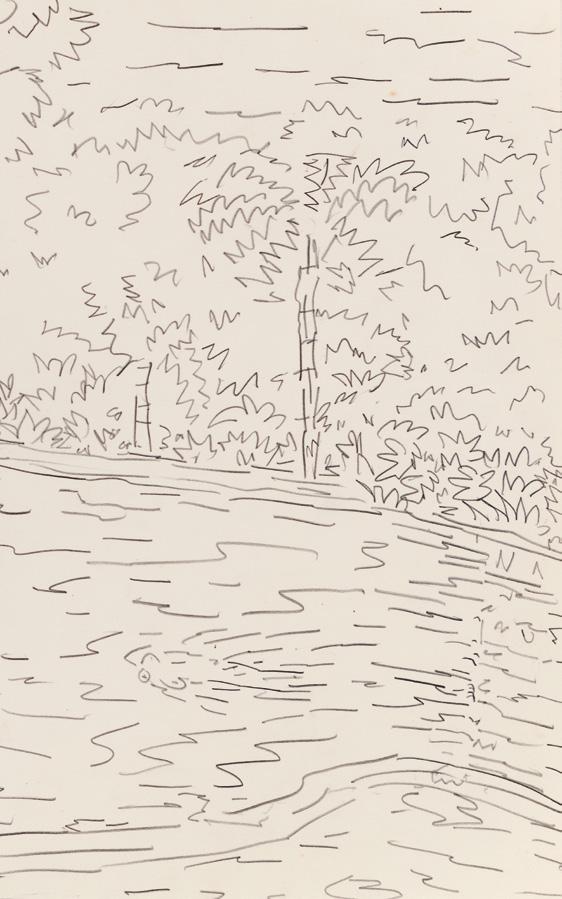
6
5. André Masson Massacre, 1933
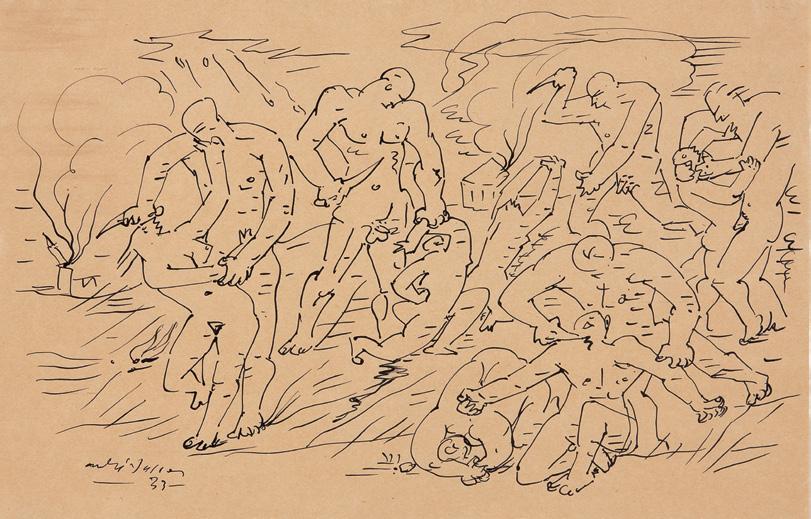
nanquim sobre papel | Indian ink on paper
31 x 45 cm
Coleção | collection Museo Nacional Centro de Arte Reina Sofía (depósito temporal coleção particular, Paris, 2012)
Foto | photo: Arquivo Fotográfico | photographic archive Museo Nacional Centro de Arte Reina Sofía ©MASSON, ANDRE/AUTVIS, Brasil, 2022
6. Da Pele, 1975
madeira, esponja natural, arame, aço inoxidável e termômetro | wood, natural sponge, wire, stainless steel, and thermometer
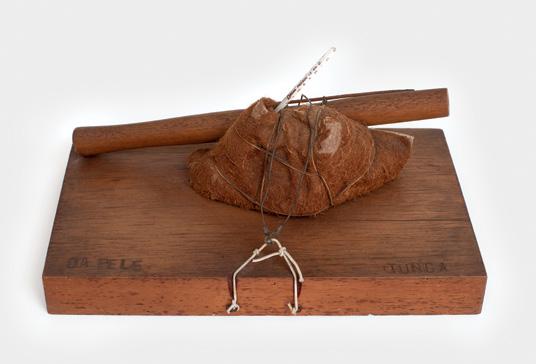
18 x 34 x 21,5 cm
Coleção | collection Thiago Gomide
Foto | photo: Renato Parada/Itaú Cultural
artística; opta por artistas que não ocupavam a centralidade da influência daqueles anos, o que é uma marca das admirações de Tunga, que viu proximi dade naqueles que o atraíam pela estra nheza e pela afinidade com seu mundo visual. Nessas escolhas, improváveis combinações, especialíssimas, encon tram-se os indícios que influenciaram a formação do jovem, ainda adoles cente, artista. Transcorriam nesses anos de 1970 a transição e mesmo a superposição entre a Pop art e a Arte Conceitual, da qual, estranhamente ou deliberadamente, não participava. Sua ligação transversal e idiossincrática com as margens do Surrealismo estru turava a poética que caracterizaria seu trabalho dali em diante.
Não foi o Duchamp conceitual tão evidente na arte contemporânea que o atraiu, e sim aqueles trabalhos que constituem a “mitologia” ducham piana. A sua inclinação surrealista também se manifestaria em uma série de desenhos claramente inspirados em André Masson, da série Massacres .
Ali estava figurada a cena que cor respondia às suas obsessões: a com pulsão erótica e a presença da morte, essa última como o estágio final da primeira – cena que vai se repetir de formas diferentes em outros trabalhos. A figura enforcada aparecia só e camu flada, indistinta na natureza; tão invisí vel quanto “A carta roubada” do conto de Edgar Allan Poe (1809-1849). Outra obra, Pintura Sedativa (1984), iria exemplificar o método que se iniciava; a contaminação metabólica entre matéria e título; para ser sedativa, a pintura tinha que ser na seda. Logo, seda/sedativa resume a transposição
poética da matéria para um estado mental – quem olha a seda é sedado por ela. A sedação se “cola” na seda e, por extensão, leva ao sono e ao sonho.
Não lhe interessava, ou interessava pouco, o tão influente na época ready -made , mas, sim, os trabalhos menores de Duchamp. Aqueles menos conheci dos, pequenos objetos “surrealistas” dos quais Tunga se aproximava e que, provavelmente, sugeririam a transição para a tridimensionalidade das obras apresentadas na sua segunda exposição individual, Ar do Corpo (no MAM Rio), na qual o título de uma delas, Objeto do Conhecimento Infantil (1974), poderia bem servir para todas as outras. Nessa exposição estamos um passo além dos fluxos inconscientes da primeira, no estágio posterior da apreensão da tridi mensionalidade dos objetos, que mais tarde o levaria à escultura. Agora a ação é tátil, da ordem da descoberta do objeto (do desejo); dos desenhos para esses insólitos “brinquedos” perversos – é o que sugere o título de um deles, Eros e o Pensamento Positivo (1974) –, estamos um grau acima e exterior da imaginação visual infantil. Objetos um tanto excêntricos, enigmáticos, plenos de possíveis descobertas reveladoras do mundo do erotismo polimórfico que, de agora em diante, vai se mani festar na escolha e no uso dos mate riais; inicialmente feltro e chumbo, ambos com uma decisiva importância ao longo da obra.
Uma ansiedade ambiciosa já se encon trava mesmo nas menores obras; uma grandiosidade íntima que, em alguns momentos mais tarde, atingiria a sun tuosidade – o grande e o pequeno são
variações homotéticas indistintas na obra de Tunga. Na seleção criteriosa dos materiais, brutos e refinados, na esme rada e meticulosa execução, acentua-se um programa deliberado que dá à obra autoridade, relevância material e o desejo de restaurar certa magnificência à arte contemporânea. Daí a recusa à unilateralidade conceitual e à banalidade decorrentes muitas vezes do ready-made; e, por outro lado, a busca de uma mitolo gia afim e da grandeza do Le grand verre duchampiano; a mesma vasta e intrin cada narrativa que vai ligar um trabalho ao outro, acrescentando a cada um deles uma nova e ampliada versão.
Sade, Fourier, Rimbaud, Baudelaire, Lautréamont; a lista de nomes da litera tura francesa, e não só desta, comparece ao espírito do artista, como se fosse ele, e a partir deles, um revitalizador e trans formador dessas poéticas tão radicais, íntimas e precisamente escolhidas. Um peculiar caso mais de intoxicação do que de inspiração; delirante, mas consciente, rigorosamente operativo e calculado. Não se trata de meras apropriações, citações, transcrições; a validade desses nomes só se justifica quando mobilizam e penetram na obra, na sua mitologia poética, espécie de reencarnação da mística da soberania romântica própria do artista, que aqui se revela como poucas na arte contemporânea.
Exemplo de uma afinidade é o pequeno múltiplo de Jean Arp2 (1886-1966) adquirido num marché aux puces em Paris nos anos 1970, o qual revela não só uma escolha oportuna, mas uma proximidade não circunstancial. Frente e verso reversíveis, os dois buracos dos olhos da Masque Oiseaux podem ser
vistos como um indício germinal de elaborações posteriores que iriam com plexificar a simplicidade do objeto que é máscara e pássaro, ora um, ora outro, e também os dois simultaneamente. A reversibilidade implícita nessa dimi nuta escultura vai revigorar os impulsos já existentes no sentido de aproximar realidades distantes. Ocultas nessa máscara havia possibilidades que Tunga desvendou e retomou como se este fosse um objet trouvé particular, desti nado única e exclusivamente para ele.
Se a diversidade de seus interesses o levava para áreas remotas, divergentes, incongruentes – ciência, filosofia, lite ratura, ocultismo, religião –, todas eram reconduzidas como fontes de energia que se unificavam no trabalho e nele se metabolizavam. Essa erudição produtiva, fluida, inclassificável se expandia e se fixava em cada ideia a cada momento da transmutação plástica, imersa no fluxo de obra a obra. Esse domínio refinado de interesses deu à sua obra esse ar inconfundível de preciosidade longamente elaborada, destinada a durar e permanecer. Faltasse esse refinamento específico, seria falsa, inconsequente, artificial, insuficiente, sem a densidade do efeito que busca provocar, muitas vezes até em excesso; como é o caso das longas, exaustivas, encantatórias e exal tantes “instaurações”.
A ideia que perseguiu e da qual nunca se desvinculou estava já expressa em seu texto publicado no exemplar de número 3 da revista Malasartes , em 1976, intitulado “Prática de Claridade sobre o Nu” 3: lançar uma nova luz sobre um corpo e explorá-lo de todas as maneiras até a sua reaparição
Nota 2. Jean ou Hans Arp, um dos grandes artistas abstratos do século XX; iconoclasta, circulou pelo Dadaísmo e pelo Surrealismo. Foi um dos primeiros a privilegiar a participação do acaso em sua prática artística, mais especificamente nas colagens. Também poeta, suas esculturas representam um dos momentos altos da abstração moderna.
Nota 3. NE: “Os exemplos de objetos aqui apresentados são da classe do clássico tema do nu” é a primeira frase de “Prática de Claridade sobre o Nu”. Para ter acesso ao texto completo, acesse: https://issuu.com/tungaagnut/ docs/revista_malasarte
7. Lygia Clark
Almofada leve-pesada, 1976 areia, isopor e tecido de algodão | sand, Styrofoam, and cotton fabric
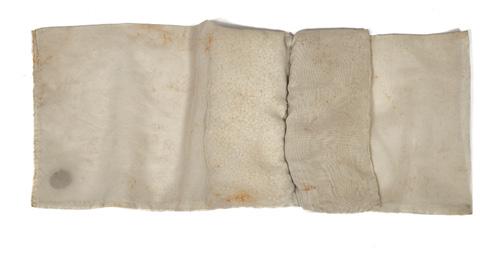
Fase | phase: Objetos Relacionais Número de edição: única | limited edition of one Coleção | collection Antônio Mourão
Foto | photo: Rafael Salim Agradecimento | Acknowledgement Associação Cultural “O Mundo de Lygia Clark”
8.
Sem título, da série |
Untitled, from the series Morfológicas, 2014 borracha | rubber edição 1/3 | edition 1/3 100 x 33 x 55 cm Acervo | collection
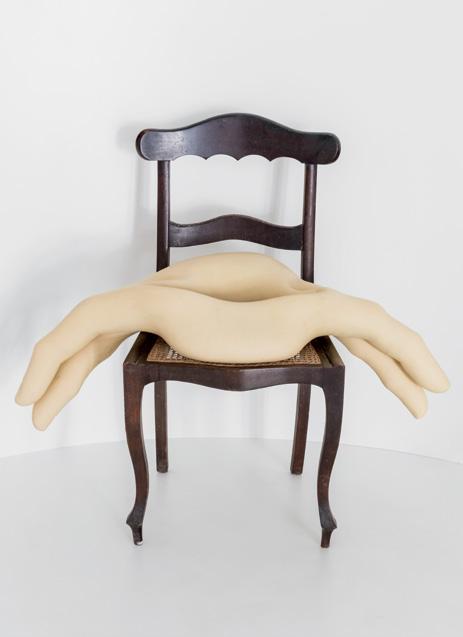
Instituto Tunga
Foto | photo: Gabi Carrera
reinventada; reinstaurar o corpo na escultura – o corpo é a escultura e vice-versa. Toda obra persegue a ideia obsessiva do nu, desdobrando-se a cada momento, a cada trabalho. Trata-se da cena erótica primordial de Tunga, resumida na frase de Georges Bataille: “A ação decisiva é o desnudamento”.
Suas primeiras esculturas já indica vam uma prática divergente, hete rodoxa, mas ainda assim próxima a outras da arte contemporânea. Não foi, por exemplo, o único a usar o feltro. Joseph Beuys (1921-1986) e Robert Morris (1931-2018), entre outros artis tas, também exploraram, de maneira diversa, o caráter tátil, flexível, anties cultural e orgânico desse material. Diferentemente deles, articulando a matéria mole do feltro a esquemas geométricos “duros”, Tunga realizou suas primeiras esculturas, os Albinos (1982) (p. 130 | img. 120 a 122), corpos recortados no feltro e remontados por meio de parafusos e cordões em diver sas variações. Neles a oposição entre a geometria estruturada das formas e a matéria flexível do feltro sugeria uma possível tensão e reação do inanimado em reivindicar-se como coisa viva –fenômeno semelhante aos Bichos de Lygia Clark (1920-1988). Era como se os cordões tensionassem a pureza geomé trica e o plano retorcido sugerisse um volume aprisionado em uma posição na qual o “corpo” tomava forma. Não é sugestivo que o branco do feltro recor dasse os nus das esculturas clássicas gregas? Aí se iniciava uma profunda ligação de Tunga com a matéria, ou as matérias; serão muitas aquelas que vão identificar, de agora em diante e à primeira vista, um trabalho seu.
9. Jacqueline Silva e seu Eixo Exógeno, 1986 | Jacqueline Silva and her Eixo Exógeno, 1986. Foto realizada durante as filmagens de O Nervo de Prata, de Arthur Omar | photo taken during the filming of O Nervo de Prata, by Arthur Omar. Foto | photo: ©Wilton Montenegro
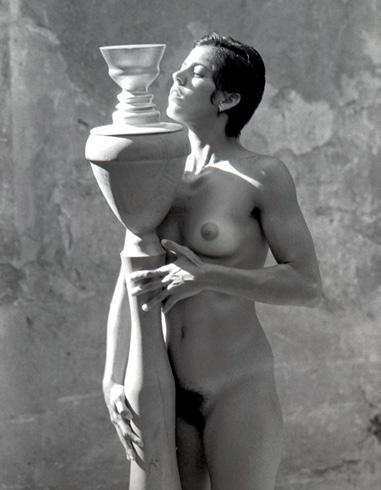
10. Performance Xifópagas Capilares entre Nós, 1986. Foto realizada durante as filmagens de O Nervo de Prata, de Arthur Omar. | Performance Xifópagas Capilares entre Nós, 1986. Photo taken during the filming of O Nervo de Prata, directed by Arthur Omar.
Foto | photo: ©Wilton Montenegro
A Vênus que surge pela primeira vez na pré-história do trabalho de Tunga tinha que ser pré-histórica: a Vênus de Laussel , estatueta paleolítica desco berta na França em 1909, aparece na fotografia que faz parte de uma obra, hoje perdida, Piscina (1975), publicada na revista Malasartes junto com o texto “Prática de Claridade sobre o Nu”. Nota-se que essa Vênus já é o “nu”, um dos primeiros da história. A Vênus vai se tornar Vê-Nus (1976); ao separar e ligar a sua nudez ao voyeur por um hífen, Tunga indica que sem um não há o outro. Algo semelhante ocorre com os Eixos Exógenos . Eixos x Exógenos – o “x” que se repete nas duas palavras é como a representação gráfica de um eixo –, há uma proximidade entre esses termos, um está ligado ao outro, umbi licalmente, como as Xifópagas Capilares entre Nós (1984), por um “x”, incógnita que nos fascina e desconhecemos. Cariátides contemporâneas – assim poderíamos denominar os Exógenos, corpos eretos e hieráticos gerados pela circunvolução de um corpo de mulher em torno de um eixo; o “x” que lhe dá corpo ao se retirar quando a ausência se torna presença. Portanto, cariátides negativas; simultaneamente clássicas e contemporâneas. Essa volubilidade do imaginário da obra leva o corpo às intermináveis aventuras da forma; aliás, aqui, forma deve ser compreen dida apenas como um estágio, um momento de passagem que se presen tifica em um e noutro trabalho. Forma é um fluido entre mental e material, ideado e materializado, portanto indis tinto, uno; a “substância” da poética. Ora é a corporificação de uma expe riência planar, como nos Albinos , ora o corpo se materializa como “vazio”
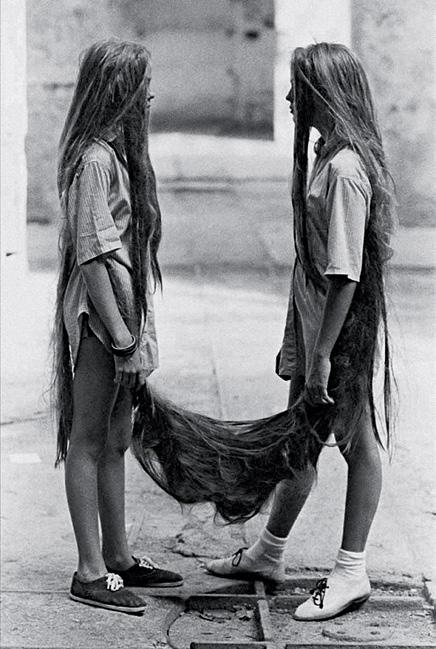
11
e perfaz uma ocupação que é também uma “desocupação do espaço”, para usar o conceito escultórico de Jorge de Oteiza 4 (1908-2003).
Fixações peculiares vão estabelecer uma família de fetiches; cabelos, por exemplo, são um dos mais notáveis. Ao torná-los matéria escultórica, o que em certa medida já o são poten cialmente, o trabalho entrelaça, como sempre, corpo e escultura. Portanto, as gêmeas xifópagas só poderiam estar unidas pelos cabelos, sendo os fios os condutores da “energia de conjunção” que as envolve numa atmosfera lírica, musical, encantatória, tal uma mesma melodia repetida e repetida. Uma ode à puberdade, pois se supõe que só nessa idade os cabelos manifestam sua pura sensualidade nascente. E aí o “x”, a incógnita, é um palíndromo capilar:
os cabelos crescem em uma e terminam na outra ou vice-versa? Nessa cabe leira- “palíndromo” , assim como as gêmeas, é tão indiferente quanto igual o sentido que as une. Ambas se encon tram envoltas num halo de liberdade e fraternidade que só a elas é dado e só elas conhecem e vivenciam – seria a revisitação da infância que as fanta siaria unidas pelos cabelos, sua mãe e tia, irmãs gêmeas?5 Estaria Tunga aí ressignificando na sua imaginação, num mito pessoal ou fábula imemo rial? Essa, entre outras, é uma de suas construções míticas; o horizonte que elas buscam articular abrange origens desde as mais arcaicas até as mani festações contemporâneas, tempo e espaço se confundem. Essa dualidade estranha, heterodoxa, não familiar, vai percorrer toda a sua obra, assumindo formas variadas em seus fascinantes
11. Alberto da Veiga Guignard
Léa e Maura, ca. 1940
óleo sobre tela | oil on canvas 86 x 104 cm
Coleção | collection Museu Nacional de Belas Artes/ IBRAM / MINC Foto | photo: Vicente de Mello
Nota 4. Jorge de Oteiza, escultor basco, recebeu o Prêmio para Escultor Estrangeiro na V bienal de São Paulo, em 1957. Intitulou sua participação na mostra de “propósito experimental”. Seu construtivismo idiossincrático o levou a indagar sobre a presença do vazio na escultura e àquilo que chamou “desocupação do espaço”.
Nota 5. Léa, mãe, e Maura, tia de Tunga, irmãs gêmeas, foram retratadas, lado a lado, vestidas idênticas, em um famoso quadro de Alberto da Veiga Guignard (1896-1962) pintado em 1940.
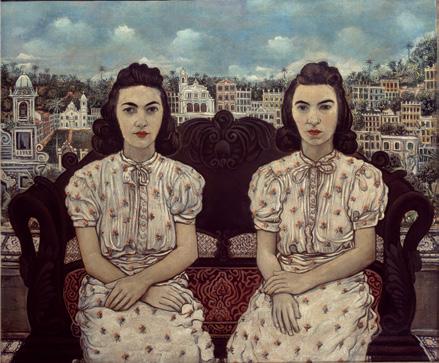
12. Esquema da construção de São João Batista | plans for the construction of São João Batista Acervo | collection Instituto Tunga Foto | photo: Rafael Adorján/Itaú Cultural
amálgamas heteróclitos. Tal é a cele bração da “monstruosidade” juvenil purificada das gêmeas. Exalam uma verdadeira joie de vivre , esculturas vivas da liberdade, vivacidade e luminosi dade que só vão reaparecer na série “From ‘La Voie Humide’” , mais de 30 anos depois.
Os cabelos continuam, perseguem o imaginário, pressionam com a força e a insistência do fetiche. Tal processo intrincado de comunicação entre as coisas, o trabalho apresenta literal mente muitas vezes e, em primeiro lugar, como Trança (1981). O entrelaça mento se repete de tranças em tranças, de dimensões e formatos diferentes, tal como a variação dos penteados, estes também – e por que não – escul turas. Tranças que supõem um escalpo, o corte violento do objeto-fetiche.
Uma escultura metálica, mas flexível, sinuosa, muitas vezes amarrada – num toque final – com um irônico, gracioso e perverso laço de seda colorido.
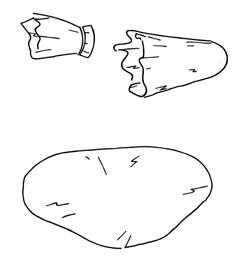
Já Troféu (1981) (p. 120 | img. 108), enorme cabeleira, assume, pela dimen são, a condição de objeto de sacrifício, subjugação e veneração, significados possíveis que as tranças encerram. Despojo de um corte que tantas vezes vai reaparecer no trabalho de Tunga como um gesto material e simbólico de uma separação radical e irremediá vel – e também a ser rearticulada. O corte dá origem a algo que é parte e se soma ao todo e, se ele se refere à decapitação, invoca o desígnio de um santo que lhe dá o nome: São João Batista (2 a.C.-27). Uma parte no chão, outra na parede, como uma espécie de troféu à vista de todos; a
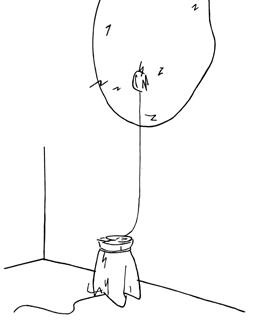

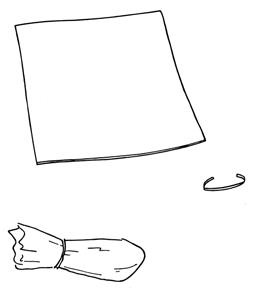
13.
A Vanguarda Viperina, 1985 fotografia em papel metalizado | photograph on metalized paper 102 x 76 cm
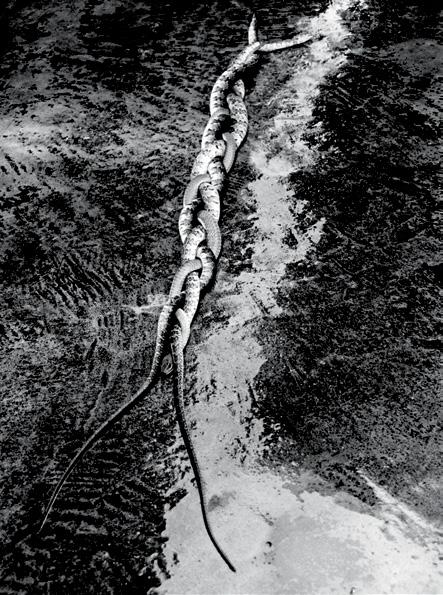
Foto | photo: Lucia Helena Zaremba
14, 15.
Tunga segura as cobras que fazem parte de A Vanguarda Viperina, 1985, no Instituto Vital Brasil, em Niterói, Rio de Janeiro. |
Tunga holding snakes that are part of A Vanguarda Viperina, 1985, at Instituto Vital Brasil, in Niterói, Rio de Janeiro.
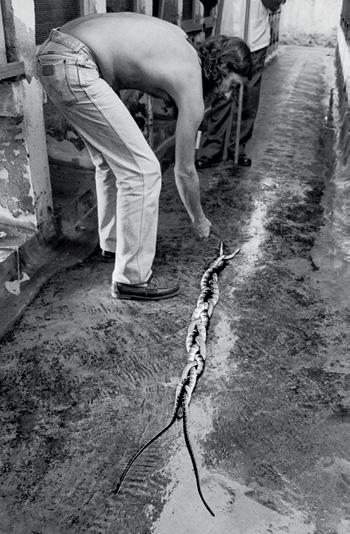
Foto | photo: Lucia Helena Zaremba
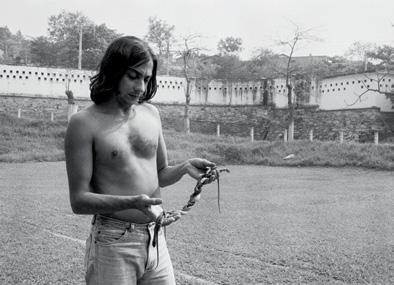
Nota
O
cabeça decapitada do santo apresen tada em uma bandeja. Em Vênus, ou Vê-Nus (p. 121 | img. 109), também se entrelaçam, como em São João Batista (1977) (p. 132| img. 123), o arcaico e o contemporâneo. O jogo de pala vras Vênus e/ou Vê-Nus expressa as múltiplas implicações que ampliam e abrem novas dimensões a um sentido inicial, aparentemente fechado. Os nomes, palavras e conceitos deslizam em direções diferentes, como por um impulso insatisfeito, inquieto, gerador e ampliador – o desejo permanente de trazer para si, não importa o que estiver próximo ou distante. Tal é o espírito daquilo que Tunga chamava de “energia de conjunção”, aproximar realidades distantes, físicas e mentais e amalgamá -las na matéria e substância dos traba lhos. Como revela Georges Bataille, “o sentido último do erotismo é a fusão, a supressão dos limites”6 .
metabolizada, embora ainda “clássica”. Vê-Nus é um trabalho de borracha, flexível e pesado, maciçamente negro, recorte de um plano ao qual perma nece atado, o “outro”, o rejeitado fica abaixo, suspenso no jogo visual vazio e cheio, dentro e fora, como peça de um quebra-cabeça que antes se comuni cava pelas bordas. Limites, fronteiras, tudo a ultrapassar, afinal nada mais do que a pele que nos separa do mundo exterior e esconde o que somos por dentro. A fluência da continuidade/des continuidade entre os materiais desfaz a fronteira – a borda – entre orgânico e inorgânico, liga o chumbo das tranças às cobras de A Vanguarda Viperina (1985).
Editores,
A Vê-Nus, antes Vênus, se inscreve na “Prática de Claridade sobre o Nu”. Estamos, então, dentro de uma linha gem histórica que o trabalho quer inter rogar ou nela se inscrever. De tal modo que aquilo a que Tunga se propõe vai sugerir outra dimensão do nu físico; da mera aparência externa. O nu, a Vênus, primeiramente, se manifesta nos dese nhos como uma figura negra, mancha com pequenas ondulações na borda inferior. Um nu em repouso, clássico, poderíamos dizer. Não o clima ligei ramente sádico da Vê-Nus. Esse corpo recém-operado, destacado, separado ou talvez recém-nascido – nascimento (ou morte) da Vênus –, preso às cor rentes, jaz sem forças sob a tênue iluminação das lâmpadas. A Vênus está aí contemporaneamente transmutada,
Tunga faz o ateliê se transmutar em laboratório; um e outro contaminam-se, experimentando e sedimentando a volatilidade dos impulsos e das ideias. Nele a figura topológica do toro pode ser tanto um objeto de metal, um túnel, como um círculo de fumaça expirada de um cigarro. E a infini tude da circularidade em Ão (1981) é também o infinito entrelaçamento de uma trança escultórica e verticali zada modernamente por Constantin Brâncusi (1876-1957) na sua Coluna infinita (1937). Já o desejo de Tunga é incorporar à Trança a sinuosidade orgânica e corpórea da serpente e estendê-la como algo simplesmente jogado ao chão, o oposto de Lezart (1989), vertical, sua primeira grande escultura de ímãs.
Antes a matéria era cortada, trançada, amarrada, e então ocorre a “descoberta” do ímã, a matéria por excelência da prática de Tunga. Nenhum outro mate rial resume tão bem o fundamento
de seu trabalho; unir, conectar, ligar, transmitir, conjugar etc.; o ímã como a matéria última, o próprio pensamento materializado, a pedra filosofal da sua prática artística. Deve-se conceder a Tunga o título de “inventor” do ímã na escultura contemporânea – pela des coberta, pela constância e pela intensi dade do uso. Só esse material “avesso” à escultura poderia chamar sua atenção, magnetizá-lo; a matéria ready-made que “in-corpora” à sua escultura. Com ele torna-se desnecessário qualquer ele mento que ligue as partes, o ímã já é a parte e o todo; ele próprio a “cola” que dispensa qualquer intermediário.
É o elemento material da “energia de conjunção”, da “cola poética” –o ímã como metáfora, assim podería mos chamar o processo escultórico de Tunga. E é esse fenômeno magnético
que vai dar “corpo” e tudo colar. Tal descoberta surge pela primeira vez em TaCaPe (1986). Tunga dividiu a palavra, separando cada sílaba por uma maiús cula, que também é ligação; ímã. TaCaPe é feito de ímãs “tacados”, um a um, numa haste metálica vertical, formando a figura de um tacape, cuja aspereza rugosa ressoa uma escultura de Alberto Giacometti (1901-1966) às avessas.

TaCaPe (p. 137 | img. 130) é uma nova escultura; não por adição nem por subtra ção, como a escultura clássica; tampouco o “desenhar no espaço” moderno inau gurado por Julio González7 (1876-1942), mas uma escultura por “magnetização”. A introdução do ímã pode muito bem representar um passo além da construção da escultura moderna; não mais a solda ou qualquer outro artifício, mas a energia da própria matéria como agregador das
16.
Tunga montando TaCaPe para o filme O Nervo de Prata, dirigido por Arthur Omar, 1986. | Tunga setting up TaCaPe for the video O Nervo de Prata, directed by Arthur Omar, 1986.

Foto | photo:
©Wilton Montenegro
Nota 7. Julio González é um dos pioneiros da escultura moderna, junto com Pablo Picasso (1881-1973). Desenvolveu sua prática de escultura em ferro por meio da solda, método inédito na época, ao qual chamou de “desenhar no espaço”.
partes e da fluência incongruente da construção. A presença dos ímãs como elemento da “energia de conjunção” expressa fisicamente o processo mental. Uma matéria que produz “energia” que se metaboliza, por assim dizer, teria que ter vida longa na obra e, como tal, é uma manifestação poética da natureza; está em tudo e todos, por ela estamos indis sociavelmente ligados, unidos, em troca constante, dando e recebendo.
Enquanto os artistas da arte minimalista estavam presos à geometria clássica, Tunga enveredou pela topologia, daí o Toro (p. 104 | img. 86) e suas variações. E não apenas isso; toda a exuberância que daí resulta transcende o ascetismo minimalista. Ainda assim, o trabalho não poderia se limitar a uma só determina ção; sua tendência é sempre transbordar para outras associações, afinidades, relações; ultrapassar as bordas; “trans -bordar”. Só assim poderia surgir Ão –o toro é uma figura que por definição não tem bordas –, como uma penetração sob a pele do toro; o rompimento imagi nário de uma borda.
Os elementos da escultura – uma cate goria um tanto limitada para definir essa obra, como a de outros, a de Beuys, por exemplo – eram já entendidos como relíquias, troféus, fetiches. Dentes, ossos, cabelos são elevados ao grau mais alto da preciosidade; o de verda deiras joias. Uma delas, diz o título, é de uma possuidora particular, Madame de Sade – uma invenção de Tunga ou ela teria existido? Como o próprio nome indica, introduz uma figura da literatura afim da obra e merecedora de uma homenagem envolta em um véu de sugestões possíveis – esposa do
famoso marquês? Les Bijoux de Madame de Sade (1983) (p. 109 | img. 95) é criado como uma relíquia contemporânea – uma joia atual do século XVIII? –, outro de muitos paradoxos que a obra postula. Essas joias, os bijoux, são ossos curvados como um círculo, anel ou tiara, e não são os ossos a matéria real mente escultural do corpo?
Os materiais “duros” irão entrar em cena; a escultura se volta para a solidez metálica. O chumbo, metal “mole”, maleável, pesado, em fios, retorna após longo tempo, desde O Objeto do Conhecimento Infantil. Retorna como tranças, a parte do corpo feminino ostensivamente nua, que só o pudor implícito na trança pode dissimular. As tranças trazem rememorações do conhe cimento infantil, contêm sua possível reinstauração imaginária, e ocorrem em diversos formatos e tamanhos. As qua lidades metálicas são exploradas como poucas vezes antes. É como se ressur gissem com a potência de uma matéria única em sua dureza, brilho, peso, maleabilidade, volume, formas.
A sinuosidade plástica do metal desliza para sua tradução e extensão biológica em A Vanguarda Viperina, nada menos que uma escultura viva, que não é senão a simulação da cópula ofídica, o abraço sensual de duas cobras, uma refletida na outra como gêmeas incestuosas –Palíndromo Incesto (1990) (p. 71 | img. 32) não é o título de outro trabalho? Está aí uma entre outras analogias, metáforas, alegorias e paradoxos que transitam incessantemente de um trabalho para outro, seguindo uma lógica voraz e sem limites, cuja ação, em última instân cia, é “des-bordar”; ir além das bordas,
romper com os limites da lógica e da razão. Amante dos paradoxos, Tunga certamente assinaria o paradoxo de Epimênides, poeta e filósofo grego que viveu no século VI ou VII a.C.: “Todos os cretenses são mentirosos” e que foi parafraseada assim: “A frase a seguir é falsa. A frase anterior é verdadeira”. E a traduziria assim: “O trabalho a seguir é falso. O trabalho anterior é verdadeiro”.
Lezart (p. 138 | img. 131 e 132) é o primeiro indício de uma aspiração à monumentalidade, a uma expan são da escala que não só é física, mas também insiste na construção de uma mitologia, uma narrativa que se desenvolve como o movimento de uma espiral envolvendo elementos anterio res, etapas autofágicas da obra que se desdobram. Trabalhos anteriores são resgatados em outro plano, rearticu lados e ampliados, conectando-se uns ao outros, formando um todo do que antes estava separado, desmembrado, e que se volta a reunir em observação à seletividade intrínseca da obra – não seria descabido aqui usar o termo hegeliano aufheben (superação dialé tica). A cada etapa, o corpo – o corpo é escultura e escultura é corpo – retorna como uma unidade final e provisória; à espera de uma nova realização adiante. Diríamos que o verbo “imantar” é aquele que designa e simboliza a junção dos elementos dispersos, o processo da energia agregadora da qual o ímã é apenas a matéria física, uma das partes – a outra é a “cola poética” da livre imaginação. Uma se enreda na outra, penetrando, desdobrando-se na outra, obedecendo à lógica da magnetização que, como exemplo, faz de Lezart um
complexo escultural sustentado por placas metálicas verticais fixadas por ímãs e atravessadas por fios, lembrando um gigantesco e anacrônico arcaico gerador de energia ou, combinação tão frequente, a plena nudez de uma mons truosa máquina erótica.
Bordas (1983) é um desenho impor tante não só pelo título, mas pelas implicações que sugere; limites, fron teiras, passagens de uma coisa para outra; via de transmutação entre con tinuidade e descontinuidade. Bordas se manifesta na ordem do palíndromo, de um lado um significado, de outro lado, outro, ultrapassamos de uma coisa para outra imediatamente ao transbordar. Nesse desenho transicio nal, primeiro surgimento de figuras, a cabeleira se metaboliza em tacape.
A borda é o limite e também a junção de uma coisa e outra. Explica bem o processo do trabalho e exige o plural; bordas que se desdobram e fazem, por exemplo, de um dente uma escultura.
O mesmo fenômeno ocorre, em outro plano, quando os pequenos Objetos do Conhecimento Infantil assumem uma condição escultórica, mais uma revi ravolta, transbordamento em direção a uma monumentalidade, a uma nova escala, em que a presença do corpo se insinua insistente mais uma vez. A obra se impõe na nossa escala, altiva, frente a frente, exibindo sua extrava gante majestade. Mais uma etapa do intrincado raciocínio de Tunga em que as associações se ampliam como uma espiral sem fim.
Com Gravitação Magnética (1987), o trabalho atinge uma dimensão ambi ciosa e inédita. Gravitação Magnética ,
17.
Sem título, da série | Untitled, from the series Bordas, 1983 impressão dourada e serigrafia sobre papel | golden print and silkscreen on paper 63 x 63 cm Acervo | collection Instituto Tunga Foto | photo: Gabi Carrera

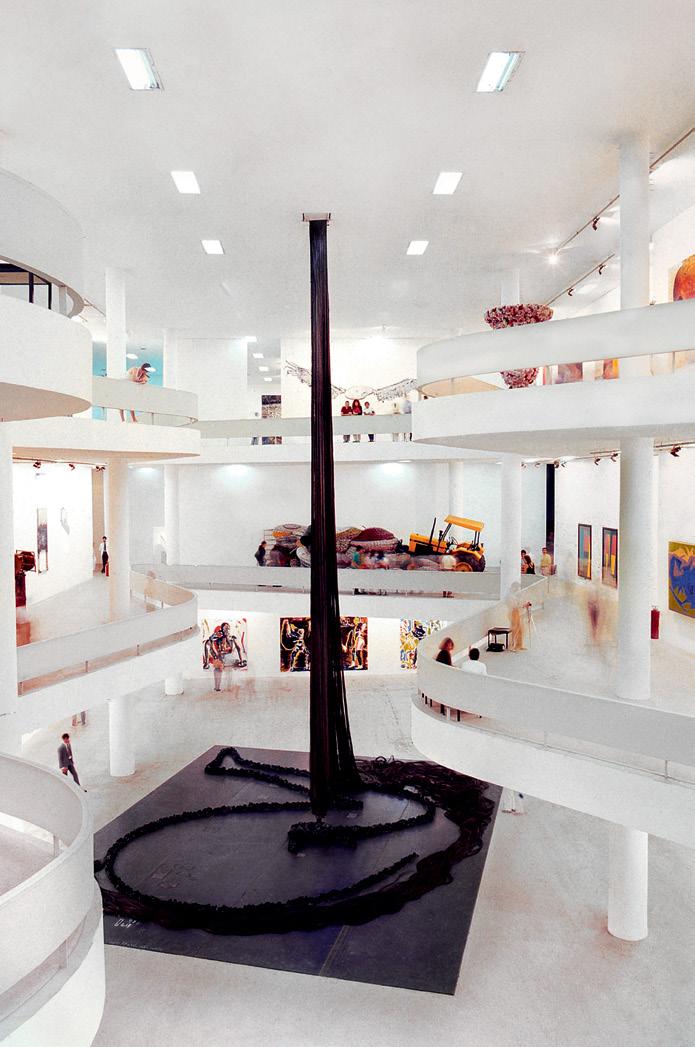
Magnética na 19a bienal de São Paulo, 1987. | The work Gravitação Magnética at the 19th Bienal de São Paulo, 1987. Foto | photo: Romulo Fialdini/Tempo Composto
19.
Sem título, da série | Untitled, from the series Gravitação Magnética, ca. 1980

aguada sobre papel | ink wash on paper 32,9 x 47,9 cm Acervo | collection Instituto Tunga Foto | photo: Renato Parada/ Itaú Cultural
Nota 8. NE: A obra ganha nova montagem em 2021 –em virtude da exposição Tunga: conjunções magnéticas – no espaço do Instituto Tomie Ohtake (pp. 144 e 145).
ou Enquanto Flora a Borda Tomba Magnética de Acúleos Zumbidos a Trilha Atapetara Aérea Ataraxia Pendular Arrepio Marsupial que Mesmo Hominídeo Cabia Fenoso Pêlos ao Lóbulo Rastreara Assistência Fractal Hesita-o Animal de Níquel Vêm o Vôo Entomológico Fêmea Asculta Cabeça Genomas Penetrarás ; aí está um título proporcional à grandeza do trabalho; desenho gigantesco que se transmuta em escultura e a escultura em desenho, reversão tão característica de toda a obra de Tunga. É o primeiro grande salto de escala; a ocupação, do teto ao chão, do vão central do prédio da Bienal de São Paulo em sua 19 a edição. Como num único gesto, o desenho de fios metálicos se eleva, desce do teto do edifício e se espar rama pelo chão; a monstruosa cabeleira termina na cabeça decepada do artista – novamente o “corte” reaparece – e
se une a um corpo desenhado por ímãs no chão. Só a dimensão espacial da Bienal possibilitou esse acontecimento único. Totem imprevisto, surpreen dente, Gravitação Magnética 8 impunha ao ambiente sua presença imponente, intimidante, quase ameaçadora.
Com À la Lumière des Deux Mondes (2005), Tunga elevou o “balangandã” à monumentalidade ao instalar a obra sob a pirâmide do Museu do Louvre, como anos antes tinha feito com Gravitação Magnética no vão central da Bienal de São Paulo . À la Lumière des Deux Mondes é o retorno antropofágico do nativo ao seu locus de admiração; o provocante totem da reverência e da emancipação; regresso audacioso do filho pródigo. Tal efeito só poderia ser consequente na França, em Paris, no Louvre, nada menos que no primeiro
grande museu da cultura do Ocidente. Toda arte ali acumulada estava pre sente, revirada e reposta naquele magnificado objeto originário da escra vidão colonial, no tipiti e na rede da cultura indígena. Tal como Gravitação Magnética , a obra surge como um monumento estranho, irônico e lúgubre, majestoso e decadente, con temporâneo e anacrônico, luminoso e subterrâneo – todos os antípodas que a obra unifica. Certamente o trabalho mais “intencional” de Tunga; apoiado, apenas, na coluna originariamente projetada para sustentar a Vitória de Samotrácia 9. E ali parece interro gar exatamente esse lugar “vazio”, e preenchê-lo. Com suas caveiras e seu esqueleto, À la Lumière des Deux Mondes é, por assim dizer, a summa e o cadáver da escultura em metal de Tunga. A partir daí, sua obra vai se voltar cada vez mais para a incorpora ção de outros materiais e elementos e para a expansão cada vez maior das suas “instaurações”.
As “instaurações” derivam de uma genealogia artística contemporânea, das modalidades efêmeras de arte, abertas à intervenção do acaso e à participação do público; os happe nings e as performances configuravam a radical desmaterialização do objeto artístico e buscavam erradicar as fronteiras entre arte e vida, na intera ção efêmera, ocasional, sem espaço ou temporalidade próprios. À improvisa ção do happening e ao “programa” da performance os acionistas vienenses 10 acrescentaram a ritualística de suas ações de sanguinolência “teatral” junto aos participantes, numa exalta ção da corporeidade como sujeito da
experiência; exaltação que é modulada, por outro lado, nas ações “aristocráti cas” 11 de Yves Klein (1928-1962) e nas “proposições” coletivas de Lygia Clark. São esses os precedentes parciais das “instaurações” – a Gesamtkunstwerke de Tunga –, a “obra total” tantas vezes perseguida encontra nelas um possível exemplar. Evento por vezes íntimo, mas também público, de exposição e contato corpóreos, em que as ações se desenvolvem na imersão dos elemen tos na obra, para celebrar a vivência sensorial e sensual.
Quanto mais se intensificam as “instau rações”, mais os desenhos se tornam explicitamente figurativos. A cena agora é outra, dominada pela ampla presença de corpos nus, que se introduzem mais e mais na apresentação do trabalho; é a matéria viva do “nu” que se impõe de forma explícita, comunal, orgástica. Aí também o corpo se manifesta como ímã, catalisador magnético de outros corpos, multiplicando e expandindo sua energia para o todo e para todos.
É notável como a palavra “poética” aparece tão frequente e insistente na ideação, descrição e qualificação que Tunga faz de seus trabalhos. As “ins taurações”, mais que todos, propõem a “cola poética” como prática artística. É a colagem moderna elevada a outro plano plástico, discursivo, espacial e simbólico. Tudo, a princípio, pode ser “colado”. Em tudo há “cola”, e a “poesia” é o agente universal dessa “cola”. Nota-se então novamente uma atitude anticonceitual, antiminimalista, mais próxima das articulações da arte povera12, porém de um requinte e refinamento peculiares, retornando
Nota 9. Vitória de Samotrácia é uma escultura do período helenístico que representa uma mulher alada, a deusa grega Nice, sem cabeça e braços, de pé na proa de um navio; provavelmente ligada à comemoração de uma vitória naval. Criada por volta de 190 a.C. em mármore branco, com 3,28 metros de altura, a obra teria sido construída para o Santuário dos Grandes Deuses, na ilha de Samotrácia, na Grécia, onde foi descoberta em 1863. Está hoje localizada no Museu do Louvre.
Nota 10. Os acionistas vienenses eram um grupo de artistas austríacos, entre eles Otto Müehl (1925-2013), Günther Brus (1938-) e Hermann Nitsch (1938-), que, na década de 1960, ficaram conhecidos por suas performances ritualísticas, escatológicas, sanguinolentas e obscenas, realizadas muitas vezes com a participação do público.
Nota 11. Na mais famosa de suas ações aristocráticas, Anthropométrie de l’époque bleue, realizada em 1960, Yves Klein, vestido de fraque e gravata-borboleta, rege músicos que tocam sua peça, Symphonie monotone, e comanda três mulheres nuas cobertas de tinta azul que esfregam o corpo em telas em branco.
Nota 12. Cunhado pelo historiador da arte italiano Germano Celant (19402020), o termo arte povera se refere ao movimento de vanguarda que surgiu na Itália em meados dos anos 1960. Também chamada de “arte pobre”, sobretudo como crítica ao consumismo e à comercialização da arte, foi desenvolvida na pintura, escultura, instalação e performance com obras compostas de materiais orgânicos, efêmeros e diversos, como madeira, terra, folhas de árvores, areia, tecidos e sucata.
20
e ampliando as intenções plurais do Surrealismo; tudo que determina, como poucas, a prática heterodoxa de Tunga no ambiente artístico contemporâneo.
20.
Vista da obra Pálpebras, 1979, primeira instalação de Tunga | view of the work Pálpebras, 1979, the first installation by Tunga Acervo | collection Instituto Tunga Foto | photo: Pedro Oswaldo Cruz
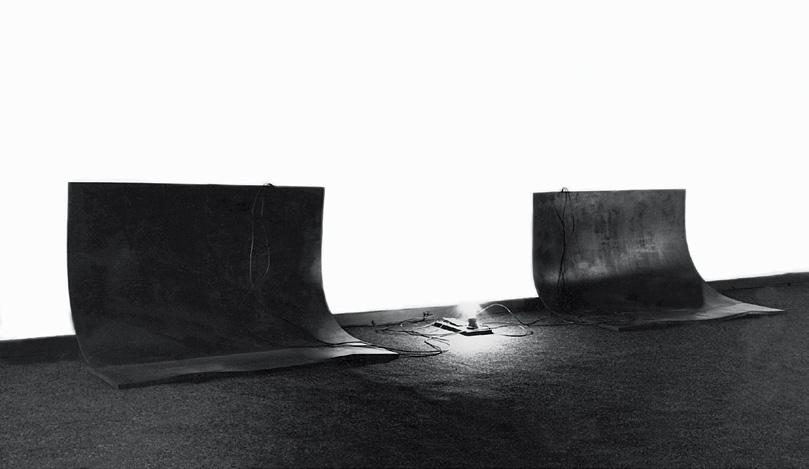
Lembremos então de Pálpebras (1979), a primeira “instauração” – embora o termo ainda não fosse usado – de Tunga: uma caixinha de música – distra ção infantil – toca sem parar a canção “Smoke Gets in Your Eyes” na semiobs curidade de uma sala, enquanto uma aranha sobe e desce entre duas placas de borracha, num movimento intermi nável, hipnótico, misterioso. Aqui, pela primeira vez, o trabalho quer provocar a situação indutora do estado de indis tinção entre sonho e realidade, fazer sentir o cansaço do peso das pálpebras, dormir e sonhar, e que vai ter continui dade anos mais tarde na circularidade infinita de Ão.
Em Ão, noite e dia, simultâneos, “gêmeos xifópagos”; na fusão de um pelo outro se encontra o infindável e inescapável trajeto pelo interior de um toro. Deveria conter um aviso: sem saída! Ouve-se “Night and Day” na voz moderna por excelência de Frank Sinatra, e ela se torna uma espécie de canção de ninar, sedativa, embalando uma viagem que não tem fim nem começo e que só existe em um túnel no qual também só se pode entrar sonhando; sedado pela canção – a viagem por dentro de uma escultura, uma escultura “nua”. Em Ão, “escultura visual”, dois movimentos se interpene tram; o da película que circula inces santemente pela sala e o da imagem na tela – um a tradução do outro. Nesses dois movimentos que se cruzam encon tramos mais uma vez, e não será a última, o método da “trança” em ação;
a peculiar versão espacial de Tunga da fita de Möbius13.
Ão é a infindável diuturna circulação dentro de um túnel; “Night and Day”, onde não se sabe se é dia ou noite. O movimento incessante que parece levar a algum lugar e leva a lugar nenhum. Voltas e voltas, incalculáveis, inumeráveis, mesméricas, intoxicantes. Percurso estranhamente monótono e excitante. Nesse experimento fílmico, delirante, só a película que circula pela galeria dá a dimensão da reali dade. Somos lançados no interior de um carrossel fantástico vindo de um laboratório de outros tempos. Ão é um palíndromo espaçovisual, sem letras, palavras, vazio, nu – o toro despido. Um “outro” Nu descendo uma escada, no 2 (1912), de Duchamp, vertido em um processador topológico.
A aventura do corpo persiste ainda na série Morfológicas e no parentesco que possuem com os Objetos relacionais, de Lygia Clark – não é por acaso que Tunga possuía um deles, presenteado por Lygia. Os Objetos relacionais eram aqueles que Lygia colocava no corpo do paciente nas suas sessões de terapia e que, segundo ela, compensavam e preen chiam um “buraco”, vazio corpóreo imaginário. A origem das Morfológicas é semelhante, moldam-se a partir do corpo, provocando fantasias táteis como se este fosse submetido a uma sessão de distor ção da imagem corporal, partes do corpo diminuem, outras se agigantam, outras desaparecem, formando uma sequência de figuras inquietantes, uma verdadeira família contaminada pela anamorfose. Assim, as Morfológicas devolvem, de uma maneira alucinada a carnalidade aos Bichos, a organicidade do plano ao corpo.
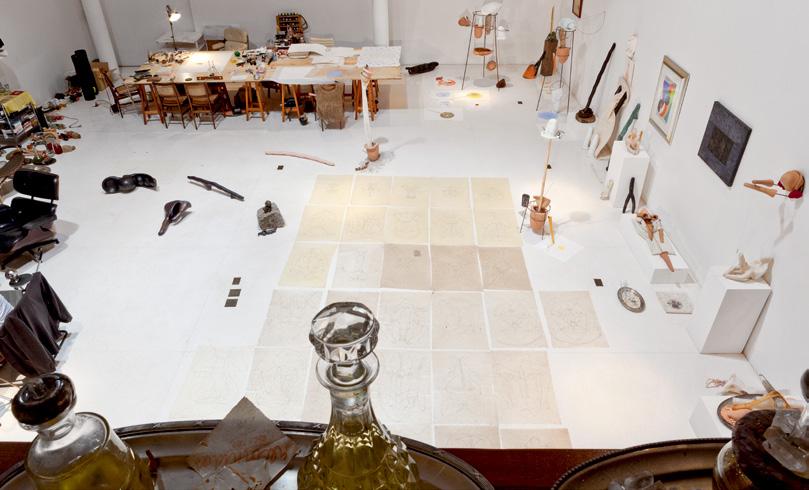
“From ‘La Voie Humide’” no espaço de trabalho que Tunga chamava de Pensatorium. | Drawings from the series “From ‘La Voie Humide’” in the workspace that Tunga referred to as his Pensatorium.
Foto | photo: Gabi Carrera Acervo | collection Instituto Tunga
Nota 13. Criada pelo matemático e astrônomo alemão August Ferdinand Möbius, em 1858, a fita de Möbius consiste em um espaço topológico onde uma linha perpendicular ao plano não possui a mesma direção em todos os pontos da superfície. É uma forma não orientável, na qual não é possível determinar a parte superior ou inferior, interna ou externa.
Nota 14. Mathesis universalis é a ciência do conhecimento em geral voltada para todos os objetos passíveis de conhecimento, inclusive metafísicos, a partir da ordem e da medida. Desenvolvida ao longo dos séculos, por exemplo, pelos filósofos e matemáticos Pitágoras, Descartes e Husserl, sua universalidade consiste em sua aplicabilidade em toda e qualquer problematização das naturezas, em que a razão humana e a matemática provêm um caminho universal para o conhecimento.
Na série “From ‘La Voie Humide’”, voltam a se revelar as tonalidades dos primeiros desenhos, azuis, verdes, laranja; cores que engendram uma deli cada ordenação espacial, quase em sus pensão, obras no ar; líricas, luminosas, totens contemporâneos. Neles o tripé, também pertencente a um trabalho do início, Piscina, sugere o trípode oracular da antiguidade pagã, consagrando não mais aos deuses, mas aos olhos contem porâneos ávidos e carentes, uma beleza autêntica e verdadeira. Variante vertical e gigante dos balangandãs, de materiais e formas e cores diferentes, em que o tripé é o sustentáculo dos elementos conectados a ele; suporte e ligação – a “brutalidade” do ímã dá lugar a uma delicada justaposição das partes. São corpos abertos com seus diversos órgãos à mostra, ou ainda órgãos sem corpo; restos de um massacre, esquar tejamento; o exemplo último de uma escultura por “conjunção”; nenhuma outra antes continha tamanha varie dade de elementos na sua ficha técnica – um mix de cerâmica, resina, metal, cristais, pérolas... A “conjunção” na sua maior extensão.
Já os desenhos de “From ‘La Voie Humide’” são resultado do percurso de uma só linha, cujo fim volta a se encon trar com o começo não sabemos onde; assim como em Ão, desconhecemos onde começa e onde termina, e seguimos seu percurso como que hipnotizados pelo mesmo efeito sedativo, espécie de calma interior, de um exercício espiri tual vindo de alguma inspiração medi tativa do Oriente. O desenho contínuo produz aquele efeito mesmerizante, hipnótico, ficamos seguindo a linha e nos desligamos da figura para um infinito,
interminável sedação pacificadora do olhar; desenhos que parecem também nos fixar, nos atrair pela avidez de um olhar convidativo, extático e enigmá tico. A transversalidade de referências e materiais na obra de Tunga manifesta esse contágio metamórfico, toda matéria contém uma simbologia, toda simbolo gia se manifesta nas matérias. Nenhum material se esgota nele mesmo, no seu silêncio e na imobilidade. Cada um deles é evocado para outro plano e se revela, renovado e ampliado, a cada trabalho. Tal é a natureza deslizante da obra, do desenho para o objeto, do objeto para a escultura, da escultura para as instala ções, das instalações para as instaurações, das instaurações para o desenho... Nada menos do que fazer da arte uma rigorosa e delirante mathesis universalis14 poética.
Ao final, toda a obra são “tranças”, “palíndromos”, “xifópagas” “bordas”, imantadas pela “energia de conjunção” –o “ímã” universal da obra que tudo atrai, reúne e articula. É a energia que faz a conjunção do estranho, do incongruente, do improvável, e os reverte para uni-los no trabalho, o qual Tunga reivindicava chamar, legitimamente, de “poesia”.
Paulo Venancio Filho é professor titular na Escola de Belas Artes da Universidade Federal do Rio de Janeiro (UFRJ), curador e crítico de arte. Publicou A pre sença da arte (2013), pela editora Cosac & Naify. Realizou curadorias em diver sas instituições, como Tate Modern, Pinacoteca de São Paulo, Moderna Museet, Kunsthaus Zürich, Museu de Arte Moderna de São Paulo (MAM/SP), Wexner Center for the Arts e Centro Cultural Banco do Brasil (CCBB).
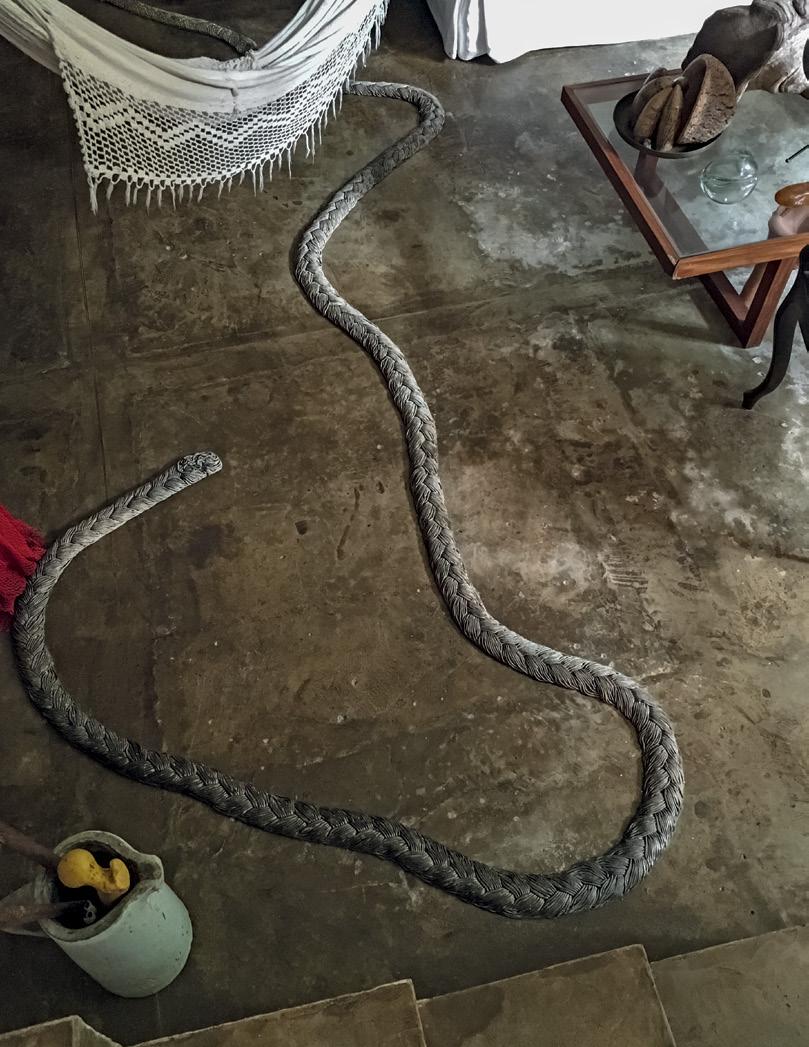
Ato de instaurar, de dar início a algo que não existia; processo ou consequência da ação de criar alguma coisa. Associado ao filósofo norte-americano Nelson Goodman (1906-1998), o termo inseriu-se em dis cussões sobre estética, teoria e filosofia da arte, difundindo-se nesse campo. Atribui-se a Tunga a introdução de “instauração” no contexto artístico, já desde o seu trabalho Xifópagas Capilares entre Nós (1984). A partir dos anos 1990, por meio de Tunga, a palavra tornou-se um dos conceitos seminais para a arte contemporânea.
Tunga atribui à “instauração” o instante em que um objeto se torna trabalho de arte, ou seja, o momento de implementação e ativação da obra, que, por sua vez, ocorre a partir das conexões de significados em determinado contexto. Nas suas palavras, “o trabalho é um conjunto de trabalhos; um sempre leva ao outro, como se entre eles existisse um ímã [...] trata-se de repotencia lizar uma obra em relação às outras”.
Artista francês, Marcel Duchamp (18871968) iniciou ainda jovem sua carreira como pintor e escultor, tornando-se posteriormente um antecipador da arte conceitual, sobretudo por introduzir o conceito de ready-made , a apropriação de objetos de uso cotidiano e sua elevação à categoria de obra de arte. Sua pintura Nu descendo uma escada nº 2 (1912) é, por sua proposta irônica, mal recebida e recu sada pelo Salão dos Independentes . Nos anos seguintes, Duchamp produz seus primei ros ready-mades , Roda de bicicleta (1913) e Porta-garrafas (1914).
Em 1915, inicia sua obra O grande vidro, ou A noiva despida por seus celibatários, mesmo (1915-1923). Em 1917, cria A fonte – nada mais do que um mictório assinado com o pseudônimo “R. Mutt” –, que se torna sua obra mais polêmica, responsável pela repercussão de seu nome. Dois anos depois, produz a também provocativa L.H.O.O.Q. (1919), em que manipula uma cópia da obra Mona Lisa, acrescentando-lhe bigode e cava nhaque. Nos anos 1920 e 1930, dedica-se ao jogo de xadrez, cria o alter ego feminino Rrose Sélavy e une-se ao movimento sur realista. Por meio dos seus trabalhos e da noção de ready-made, Duchamp tornou-se um dos artistas mais influentes do século XX e da arte contemporânea.
Representante da tradição hedonista, Charles Fourier (1772-1837) foi um filó sofo francês do século XIX famoso por suas teses sobre libertação sexual. Com duras críticas à religião e à moral cristã, à hierarquia social, à burguesia, à família tradicional, à monogamia, ao matrimônio, às estruturas econômicas do capitalismo e a muitos outros aspectos da sociedade, Fourier identificava na restrição do desejo e do prazer a origem da dor e dos conflitos que assolam a humanidade.
Segundo o filósofo, a sociedade pauta-se pela hipocrisia, uma vez que, ao mesmo tempo que busca a realização de seus desejos, os reprime recorrendo à moral.
A saída dessa contradição se daria com a satisfação dos desejos e o livre exercício das paixões, princípios divinos e partes fun damentais da natureza humana. Somente por meios desses a sociedade alcança ria um estado de equilíbrio e harmonia.
Para Fourier, a vivência com as mesmas pessoas durante toda a vida, seja em relações amorosas e sexuais ou não, traz uma condenação à monotonia e ao tédio, o que, por sua vez, impede o desenvolvi mento da personalidade. Relações diversas e por períodos diversos são necessárias ao desenvolvimento da personalidade e toda atividade criativa surge, imprescindivel mente, da libertação da paixão.
Escritor e pintor belga, em 1920, Henri Michaux (1899-1984) dá início a inúmeras viagens e passa, ao longo de sua vida, por diversos países da América do Norte, da América do Sul, da Europa, da África e da Ásia. Nesse período começa seu processo de escrita, sobretudo de textos poéticos e de cadernos de viagens. Ecuador (1929) foi seu primeiro livro a obter sucesso, resultado de uma viagem que ele definiu como fracassada e precária. Nos anos 1930 muda-se para Paris, começa a pintar e a participar de exposições, influenciado principalmente pelas obras surrealistas, mantendo assíduo contato com artistas e escritores.
Próximo da antropologia, em suas narra tivas, cria culturas e países imaginários, projeções etnográficas que se desdobram em mitos, lendas, ficções e fábulas. Sua escrita é marcada por fúria, angústia, desespero, ansiedade e descontentamento do mundo e do humano, de maneira que sua atenção se direciona para o interior de si mesmo.
Com a morte de sua esposa, em 1948, Michaux concentra-se em sua pintura e escrita a partir de outro nível de evasão, explorando os efeitos da mescalina e do haxixe. As experiências alucinógenas, com a alteração dos estados de consciência e da percepção do tempo, deram início a uma série de livros e desenhos. Em uma de suas entrevistas, Tunga cita a seguinte frase de Henri Michaux: “Même si c’est vrai c’est faux” [Mesmo se for verdadeiro, é falso]. Complementa dizendo que o inverso também é válido: mesmo se for falso, é verdadeiro.
Pintor francês, André Masson (1896-1987) começa bastante jovem seus estudos na Academia Real de Belas-Artes de Bruxelas, dando continuidade a eles em Paris. Com interesse inicial pelo Cubismo, mais tarde associou-se ao Surrealismo e, em suas obras, explorou uma questão fundamental para os surrealistas: o inconsciente. Entre as várias técnicas de libertação do incons ciente, o desenho automático, também conhecido como automatismo, apontava um modo de minimizar o controle consciente no processo artístico. Masson foi um dos surrealistas que mais explorou a técnica, em seus dessins automatiques. Realizados a partir de atos independentes da vontade do sujeito, com aleatoriedade dos movi mentos e espontaneidade do gesto, revelam ou sugerem aspectos do subconsciente; ausente o controle racional, o resultado são desenhos eróticos, sonhos e combinações inesperadas próprias do Surrealismo, em que atua a mente inconsciente.
Com vínculos de parentesco com o escritor Georges Bataille (1897-1962) e com o psica nalista Jacques Lacan (1901-1981), Masson estava imerso em um meio proveniente da acentuada relação entre a arte e a psica nálise, de modo que seu trabalho buscou o que vem diretamente do inconsciente, sem intermédio da razão, da moral ou das convenções estabelecidas, exprimindo o desconhecido do humano.
Escritor francês, Georges Bataille (18971962) é autor de poemas, ensaios, romances e conferências; sua obra abrange filosofia, antropologia, sociologia, economia, arte, erotismo e misticismo. Foi convertido ao catolicismo em 1914 e frequentou o semi nário em Reims, no entanto, renunciou ao cristianismo na década de 1920 e, dois anos depois, graduou-se na École Nationale des Chartes, em Paris. Durante sua juventude, foi influenciado pelas leituras de Marcel Mauss (1872-1950), Friedrich Nietzsche (1844-1900) e Marquês de Sade (1740-1814), estudou psicanálise, aproximou-se do movimento surrealista e fundou grupos lite rários, como o Acéphale (1936), com André Masson (1896-1987), Michel Leiris (19011990) e Roger Caillois (1913-1978).
Bataille trabalhou a vida toda como arqui vista da Biblioteca Nacional da França e fundou importantes jornais e revistas, como o influente Critique (1951). Com uma obra permeada por profundidade filosófica, sugestões autobiográficas e uso de pseudô nimos, estão entre os principais aspectos de seu trabalho: a ruptura com a morali dade e a racionalidade burguesa, conflitos íntimos, o sagrado, transgressões, a morte, o inumano, o mal, o sacrifício, a sexuali dade, a transcendência e o erotismo. Entre suas últimas produções estão os ensaios “O erotismo” e “A literatura e o mal”, ambos de 1957.
Artista plástico brasileiro, Roberto Magalhães (1940), ao longo de sua carreira, sob inspira ção de seus estudos de alquimia, ocultismo e esoterismo e de experiências místicas, desenvolveu em seus desenhos, pinturas e gravuras sobretudo deformações e antro pomorfizações, que levaram a um universo temático próprio. Em 1961, frequentou cursos na Escola Nacional de Belas-Artes (Enba), no Rio de Janeiro, e, em 1965, tornou-se um dos principais integrantes do grupo de jovens pintores da exposição Opinião 65, no Museu de Arte Moderna do Rio de Janeiro (MAM Rio). Nessa fase, recebeu prêmios por seus trabalhos e mudou-se para Paris, onde permaneceu por dois anos. A partir de 1969, com seus estudos sobre ocultismo e teosofia e sua aproximação com o budismo, interrom peu suas atividades artísticas, retomando-as somente em 1975, quando participa de expo sições individuais e coletivas.
Do latim venus, a palavra é atribuída ao segundo planeta do sistema solar, com órbita entre Mercúrio e a Terra, também chamado de estrela vespertina; à deusa do amor e da beleza na mitologia romana; e à deusa Afrodite na mitologia grega. Inúmeras foram as representações de Vênus ao longo da história da arte, desde as estatuetas de mulheres com corpos avan tajados esculpidas no período Paleolítico em pedras, ossos ou marfim, associadas à fertilidade – sendo a mais famosa a Vênus de Willendorf –, até inúmeras representações de jovens nuas com medidas equilibradas a partir da Antiguidade, representando ideais de beleza – sendo a mais conhecida pintada por Sandro Botticelli (1445-1510).
Seja na Pré-História, na Antiguidade, na Idade Média, nos séculos XVIII e XIX, na arte moderna ou na contemporânea, Vênus sempre esteve presente. Das estatuetas pré -históricas às esculturas em mármore e às incontáveis pinturas, emergindo das águas a partir de uma concha ou em situa ções diversas, a nudez de Vênus atravessa os séculos, refletindo as transformações e as mudanças próprias da sociedade que a representa e caracteriza. É, a cada momento, reformulada e adaptada de acordo com as novas questões que se apresentam.
Os Eixos Exógenos de Tunga geram a per cepção visual do antagonismo simultâneo entre figura e fundo. Neste processo em que o aspecto ilusório interfere na apreensão do objeto observado, ocorre uma espécie de desorientação na percepção da figura e do fundo, de modo que há mais de uma interpretação para o que é visto e ambas as formas observadas se destacam conjunta mente. Assim, ao se tentar observar figura e fundo simultaneamente, a percepção é organizada de maneira a uma impedir a outra: figura torna-se fundo; fundo torna-se figura, ininterruptamente.
Conceitualmente, os Eixos se aproximam da noção proposta por Edgar Rubin (18861951) na imagem conhecida como vaso de Rubin. Se observados em comparação com ela ou como variações dela, formal mente, os Eixos Exógenos se assemelham a uma espécie de distensão ou alongamento vertical do vaso, com adaptações em suas formas. Se no vaso de Rubin há a percep ção da silhueta de um vaso ou do perfil de duas faces humanas, nos Eixos Exógenos percebe-se a silhueta de um eixo ou o perfil de dois corpos femininos. Em ambos os casos, a duplicação das formas laterais parte da forma e de reentrâncias do seu eixo central. Ora se percebe vaso, ora se percebem faces; ora se percebe eixo, ora se percebem corpos. Assim, a analogia do eixo e do vaso se dá pelas premissas gestálticas presentes em ambos.
Criada por Tunga, a ideia de energia de con junção surgiu a partir da vontade de trazer um conceito que fosse capaz de explicar o que ele fazia. Definiu como “[...] a capacidade de colocar o heterogêneo junto e achar no heterogêneo duas coisas que não têm nada a ver uma com a outra: uma terceira coisa que é produzida por esse encontro”. E acrescen tou: “Energia de conjunção é, por excelência, a energia do amor” – ou seja, Eros. Assim, com base na fala de Tunga, o conceito pode ser analisado a partir de três sentidos que, juntos, definem sua ideia central: a conjunção de heterogêneos; o novo gerado a partir da conjunção; a energia como Eros.
Em diversas entrevistas, o artista refere-se à energia de conjunção como sua “cola poética”. Segundo ele, significa a ligação de duas coisas que não seriam comumente ligadas, isto é, a conexão de coisas diversas para a criação de sentidos – e, nesse processo, ter como resul tado o desconhecido. Desvelar, revelar, tornar presente, fazer aparecer, fazer surgir, ou, ligar coisas que nunca foram ligadas antes para trazer à presença o que não está presente.
Uma das principais definições do conceito de “instauração” – a construção de mundos a partir das conexões de significados em determinado contexto – possui bastante apro ximação com a noção de energia de conjunção explorada por Tunga, no sentido de trazer em si o estabelecimento de relações e as pos sibilidades de criação e revelação que delas provêm, assim instaurando mundos. Isso o faz afirmar que “talvez a vocação da arte seja o uso da energia de conjunção”. Esta é imedia tamente relacionada à “cola poética” que liga dois elementos díspares, criando um terceiro. Tunga acreditava que essa cola era única e exclusiva de cada artista. Cada poeta, músico etc. cria a sua própria cola poética e, portanto, produz arte.
Do grego palíndromos, a palavra é com posta da junção dos termos palin (de novo, de volta) e dromos (corrida), remetendo a “repetição, volta, de novo, novamente”. Assim, palíndromo está associado a palavras, números (capicua) e frases (anacíclica) que podem ser lidos da esquerda para a direita e vice-versa mantendo o mesmo significado.
O uso e a retomada do palíndromo ao longo da história sugerem um aspecto próprio dele, sua volta e repetição constantes, desde as incisões de letras em colunas de pedra no período do Império Romano. De certo modo, individualmente, cada palín dromo traz em si um aspecto topológico, no sentido de que, mesmo na mudança, permanece algo que não se altera – a orien tação e a direção da leitura não interferem no seu significado –, não importa sua forma, o significado é preservado.
Pregador judeu, João Batista (2 a.C.-27) nasceu em Aim Karim, cidade de Israel, filho de Santa Isabel (prima de Maria, que viria a ser mãe de Jesus) e do sacerdote Zacarias, que ficou mudo após duvidar do que o anjo Gabriel lhe disse: que Isabel, idosa e estéril, teria um filho e ele deveria se chamar João. Pouco tempo depois, ela deu à luz, como Gabriel havia anunciado.
Adulto, João Batista foi viver como um nômade no deserto da Judeia, em uma vida de penitência e pregação, anunciando a chegada do Messias. Passa, então, a ser chamado de profeta. Em sua missão, pregava a conversão e o arrependimento dos pecados por meio do batismo, por isso o seu nome, que significa “aquele que batiza”. Entre tantos outros, João foi responsável pelo batismo também de Jesus, seu primo. Nas pregações, denunciava injustiças, abusos de poder, imoralida des e, sobretudo, a vida adúltera do rei Herodes, que tinha se unido a Herodíades, sua própria cunhada. A oposição acabou levando à prisão de João. São Marcos, em seu Evangelho, narra que Salomé, filha de Herodíades, dançou para Herodes, que ficou deslumbrado e disse que daria a ela tudo o que pedisse. Salomé então pede a cabeça de João Batista numa bandeja, ao que o rei atende, ordenando a decapitação do profeta.
Do latim torus, toro é um espaço topoló gico, homeomorfo e não euclidiano gerado a partir da rotação de um círculo em torno de uma reta do mesmo plano, sem ponto de contato entre reta e círculo. Em sua mor fologia, por meio do diagrama plano, seu formato circular e seus atributos curvilíneos surgem, no entanto, de um retângulo. Isto é, é uma forma simples, porém de construção complexa pela perspectiva matemática.
O toro é uma das figuras topológicas mais básicas na qual uma deformação é homeo morfa; semelhante a um cilindro, fechado e orientável, construído a partir de uma dupla rotação, horizontal e vertical, assim como outras figuras topológicas, preserva pro priedades qualitativas intrínsecas mesmo sob deformações.
Das palavras gregas topos (lugar) e logos (estudo), a topologia volta-se às proprieda des geométricas de um corpo, as quais não se alteram em função de sua deformação. É oriunda de uma geometria não euclidiana. Um espaço topológico, seja um objeto, um corpo, uma figura ou uma forma, quando manipulado de modo semelhante a uma borracha em um processo de deformação, mantém suas propriedades qualitativas inalteradas; ou seja, não há diferença entre uma esfera e um cubo, ambos podem se transformar um no outro, mantendo suas propriedades topológicas.
O nó de Borromeu, como aparece em Les Bijoux de Madame de Sade (1983), possui uma topologia constituída por três anéis entrelaçados de modo que a remoção de qualquer um deles desata todos. Essas propriedades foram utilizadas também na teoria psicanalítica de Lacan, que propõe uma topologia de três registros presentes em todo sujeito: o real, o simbólico e o ima ginário, sendo que o nó de cada indivíduo, em analogia ao nó de Borromeu, representa a consistência de sua realidade.
A palavra surge do som que objetos pendura dos fazem ao ser movimentados, tratando-se de uma onomatopeia cuja raiz advém de “balançar” ou “um pedaço pendurado”. De origem africana – possivelmente bantu –, surgida por volta dos séculos XVIII e XIX, a palavra balangandã está relacionada às primeiras manifestações artísticas afrodes cendentes; mais diretamente, a acessórios de metal de variados tipos e formatos, como figas, frutos e animais, presos em pencas para decoração ou uso devocional.
O termo possui variações, como baran gandãs (atribuídos a objetos de devoção particular), balangandãs, balangangãs e berenguendéns (referentes a joias, enfeites ou decoração). Assim, como objetos votivos ou de adorno, amuletos ou ornamentos, dispostos como penduricalhos ou em pencas, os balangandãs carregam inúmeros sentidos, significados e aspectos simbóli cos associados a quem os produz ou à sua origem, de modo que, por suas inúmeras possibilidades simbólicas, têm seu uso continuamente retomado na contempora neidade para finalidades distintas.
Do tupi tepití, a palavra define um artefato indígena destinado à prensagem de man dioca ralada para a extração de seu líquido e, em certos casos, também do veneno. Elaborado em bambu ou palha trançada e de diferentes formas e tamanhos, o tipiti é um tubo esguio composto de um orifício em cada extremidade; uma espécie de cesto no qual um dos orifícios é pendurado a uma árvore e o outro é segurado por uma pessoa para o processo de torção. Cilindro elaborado a partir de tranças e nós, topolo gicamente, o tipiti aproxima-se do formato de um bitoro distendido, cuja conforma ção é ideal à torção. Assim, seu formato alongado e sua confecção a partir da trança não só propiciam a maleabilidade e a flexibilidade necessárias à torcedura pelas mãos como também tornam sua aparência semelhante a uma cobra ou a um tacape.
Das palavras gregas morphe (forma) e logos (estudo), a morfologia volta-se ao aspecto, à forma e à aparência externa da matéria. É aplicada em diversas áreas, como a lin guagem e a biologia, no estudo da forma e da estrutura do objeto que lhes diz respeito. No campo da matemática, a morfologia está relacionada mais diretamente a estruturas espaciais presentes na ordenação geomé trica das imagens e, por sua vez, à análise das formas nela identificáveis.
Inicialmente estudada nos anos 1960, a partir da teoria dos conjuntos, e original mente desenvolvida para imagens binárias, a morfologia concentra-se na extração de características, componentes e informações em imagens digitais relativos à geometria e à topologia de um conjunto desconhecido, em busca da representação e da descrição das formas que delas advêm. Ou seja, as propriedades geométricas identificadas na imagem indicam as características e a aparência da forma, possibilitando, a partir do seu processamento em imagem, a com preensão de sua estrutura espacial. Desse modo, a morfologia amplia, por exemplo, as possibilidades de estudo da topologia, iden tificando por meio da imagem os processos de seus homeomorfismos e demais caracte rísticas e aspectos dos espaços topológicos.
Do grego anamórfosis, cujo significado remete a “nova formação, transformação”, o termo está associado à imagem deformada de um objeto dada por um espelho curvo ou por um sistema óptico não esférico. Essa representação ou imagem aparentemente irreconhecível se apresenta mais regular ou perceptível a partir de determinado ângulo ou posição, assim como por meio de lente ou espelho não plano, tornando-se, dessa forma, uma imagem reconhecível, não mais deformada. Assim, anamorfose é um efeito óptico criado a partir de uma modificação intencional da imagem que consiste em deformar aquilo que, visto sob certo ângulo, retoma seu aspecto verdadeiro.
O exemplo mais conhecido é a caveira pre sente no quadro Os embaixadores (1533), de Hans Holbein (1497-1543). Quando observada frontalmente, é uma imagem imprecisa e desconectada do restante da obra; no entanto, quando observada late ralmente, torna-se precisa, sendo possível reconhecê-la como caveira. Portanto, diante de uma anamorfose, a perspectiva, o ângulo, a distância, a orientação e a direção do olhar devem estar sob um exato ponto de vista, o único a partir do qual o elemento recu pera uma forma proporcionada e clara em que o irreconhecível e deformado pode ser identificado; caso o observador se coloque em qualquer outra posição, a imagem se torna novamente incompreensível.
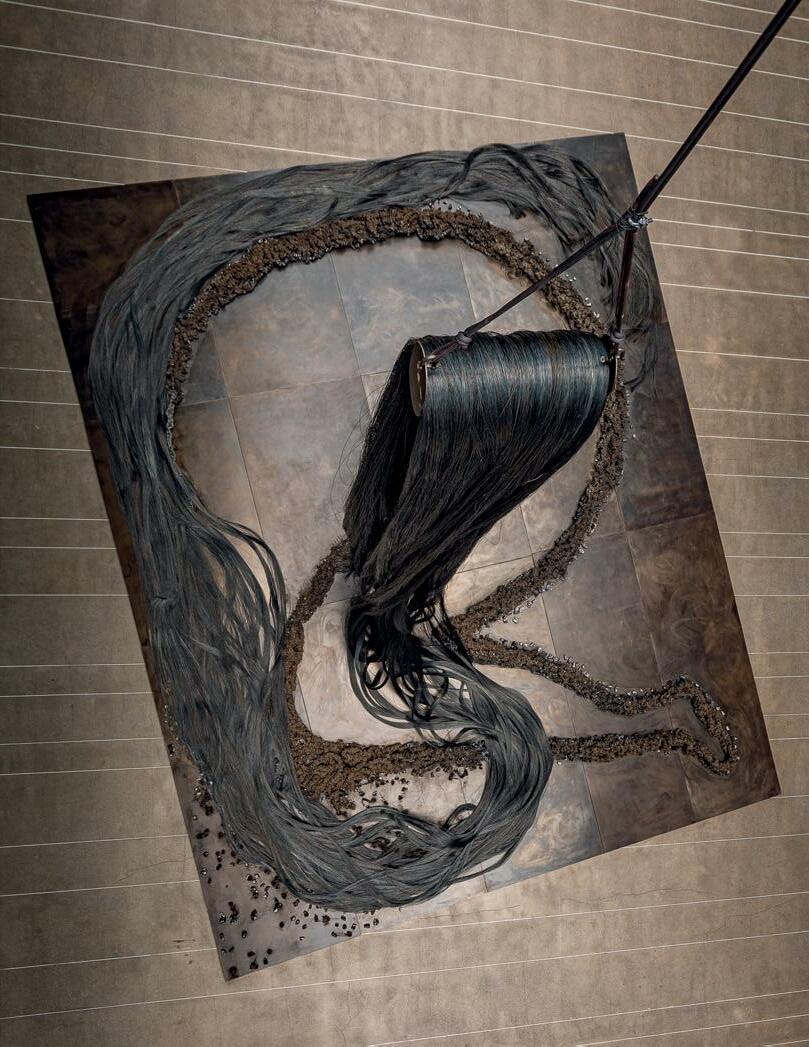
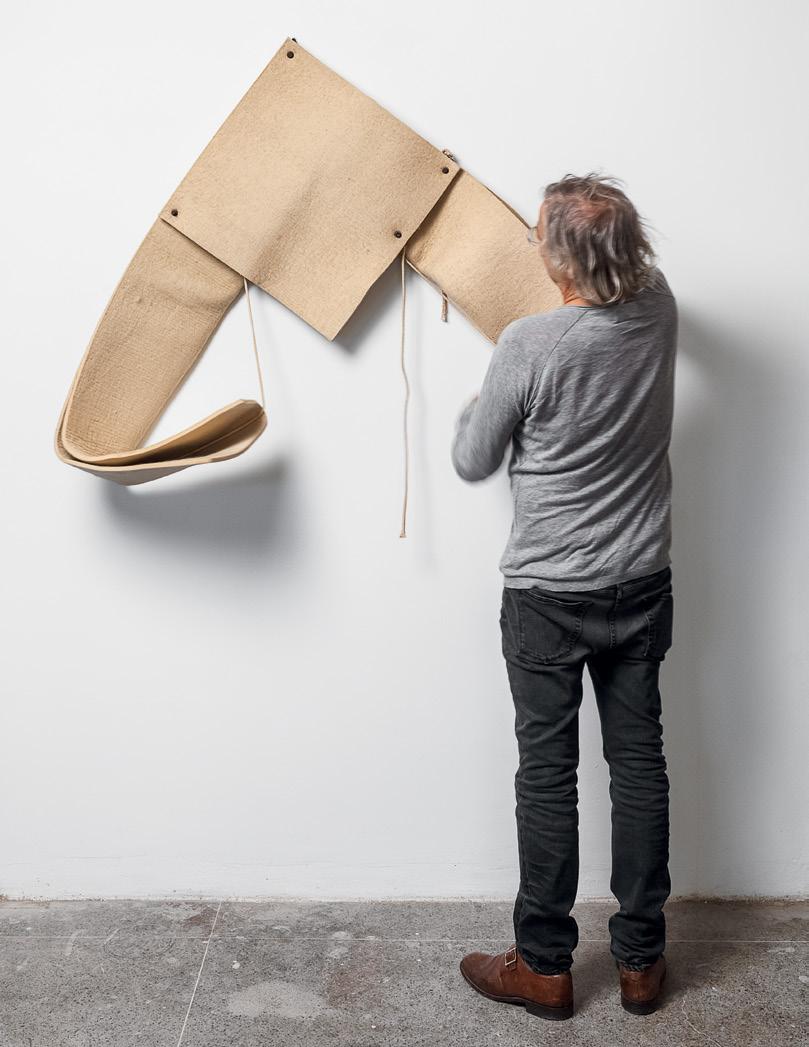
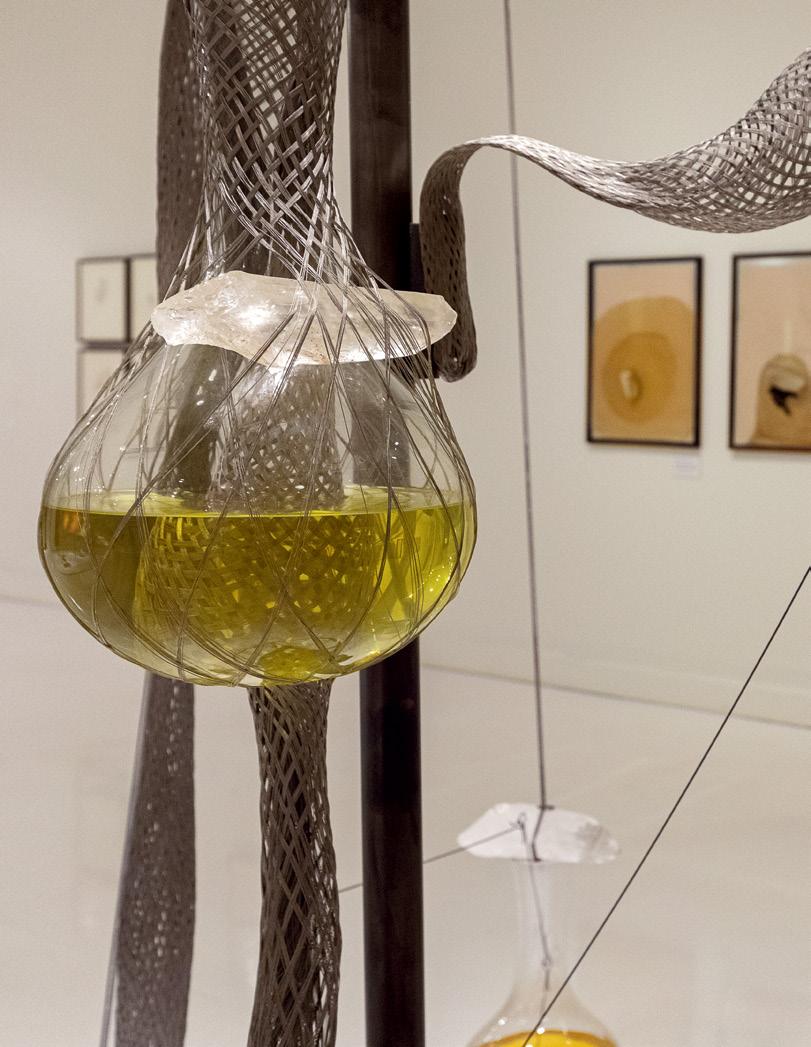
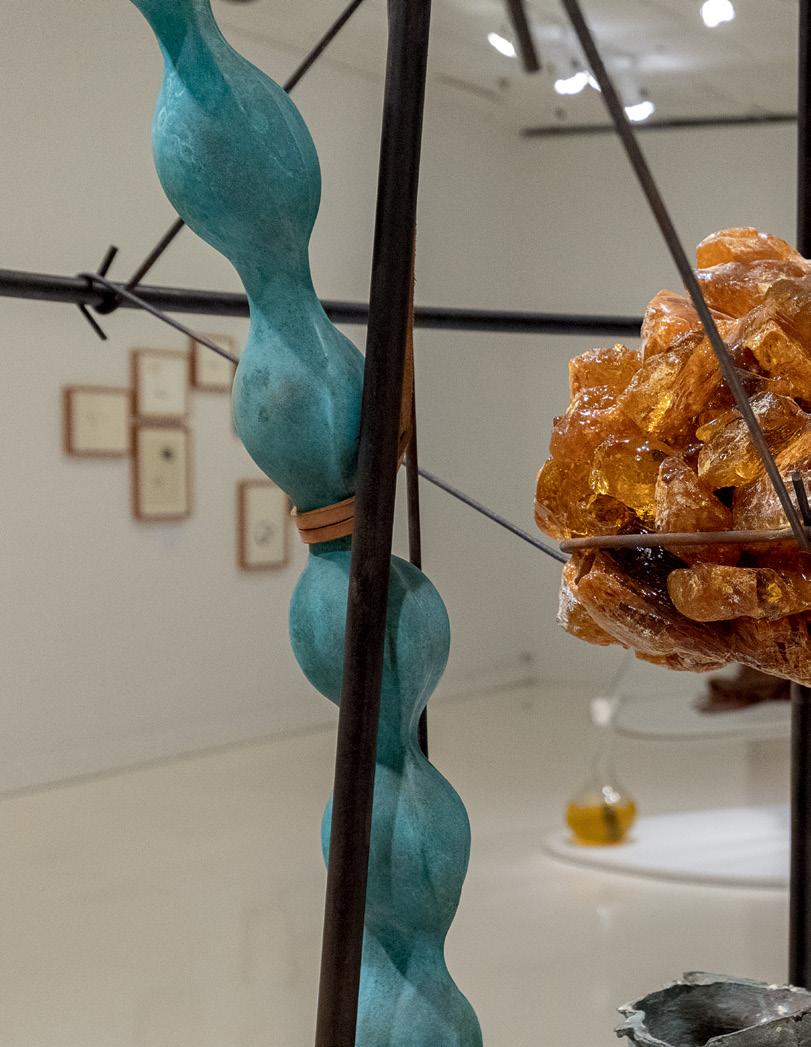
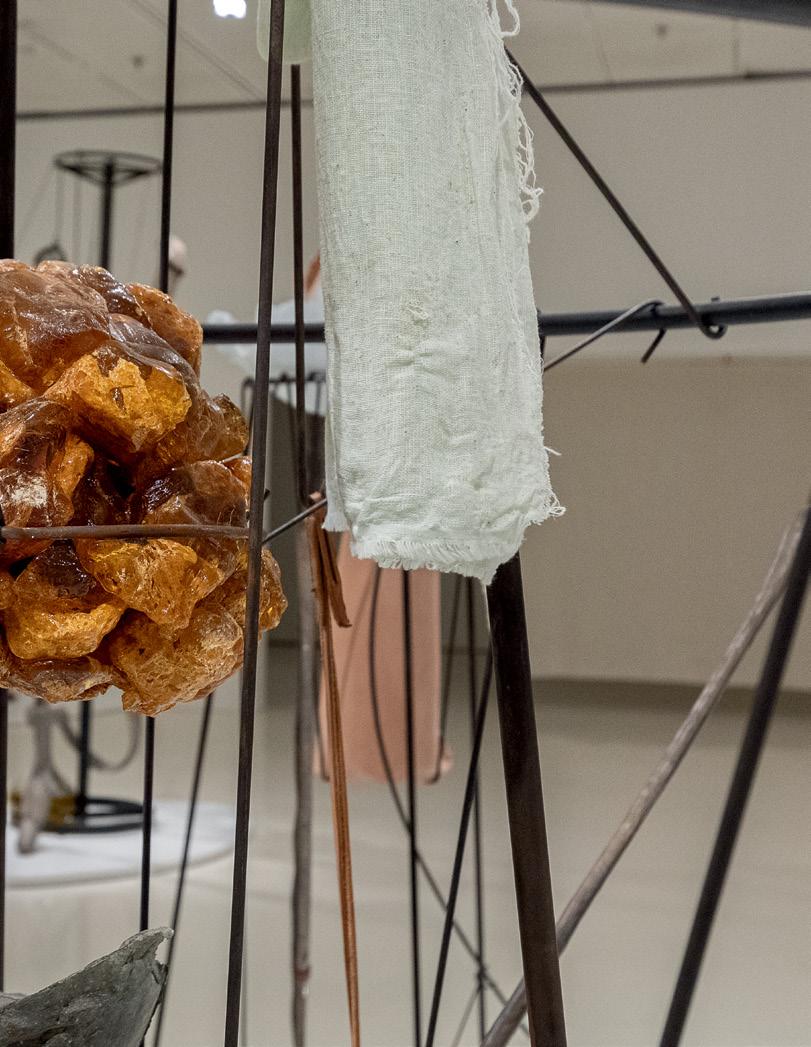
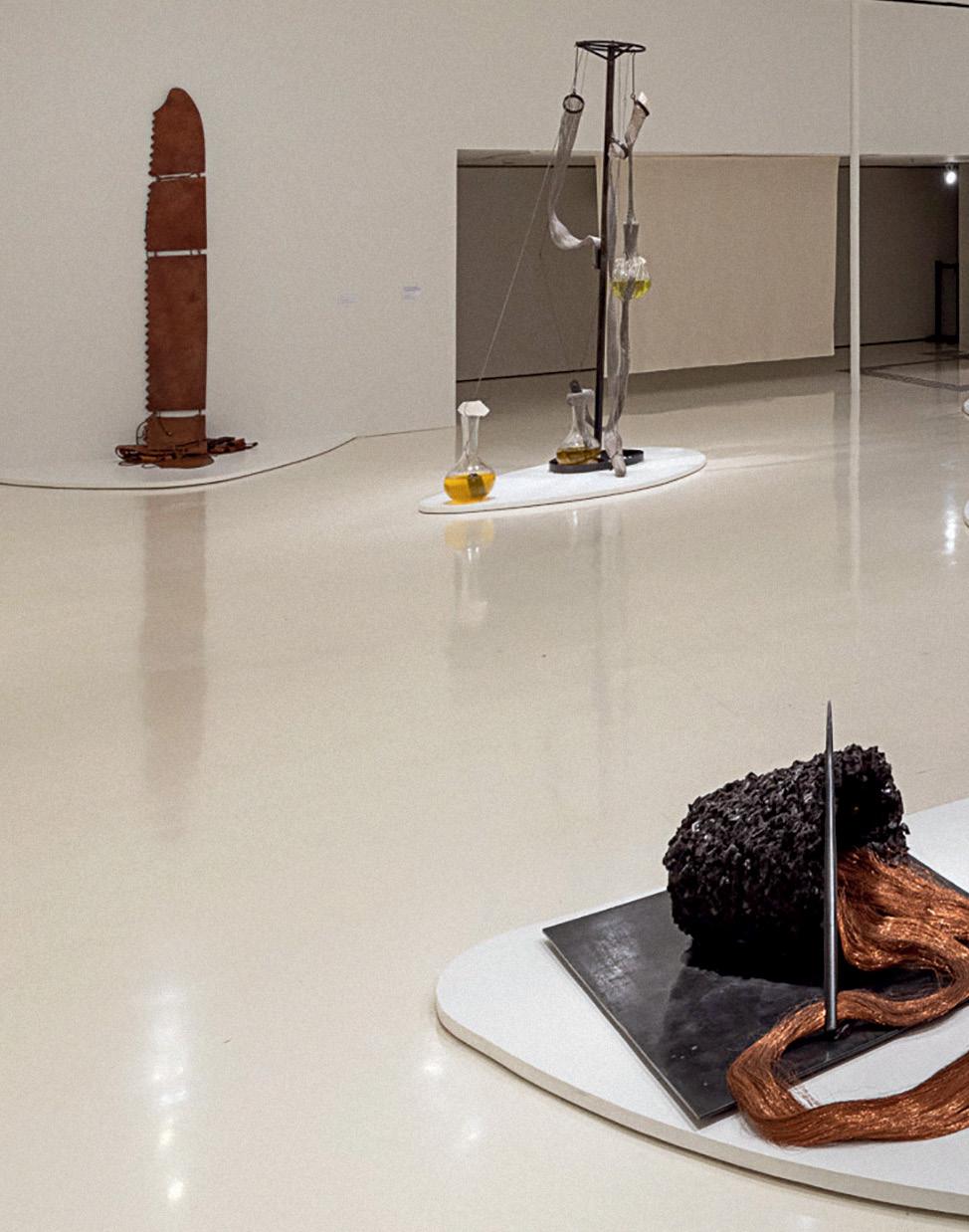
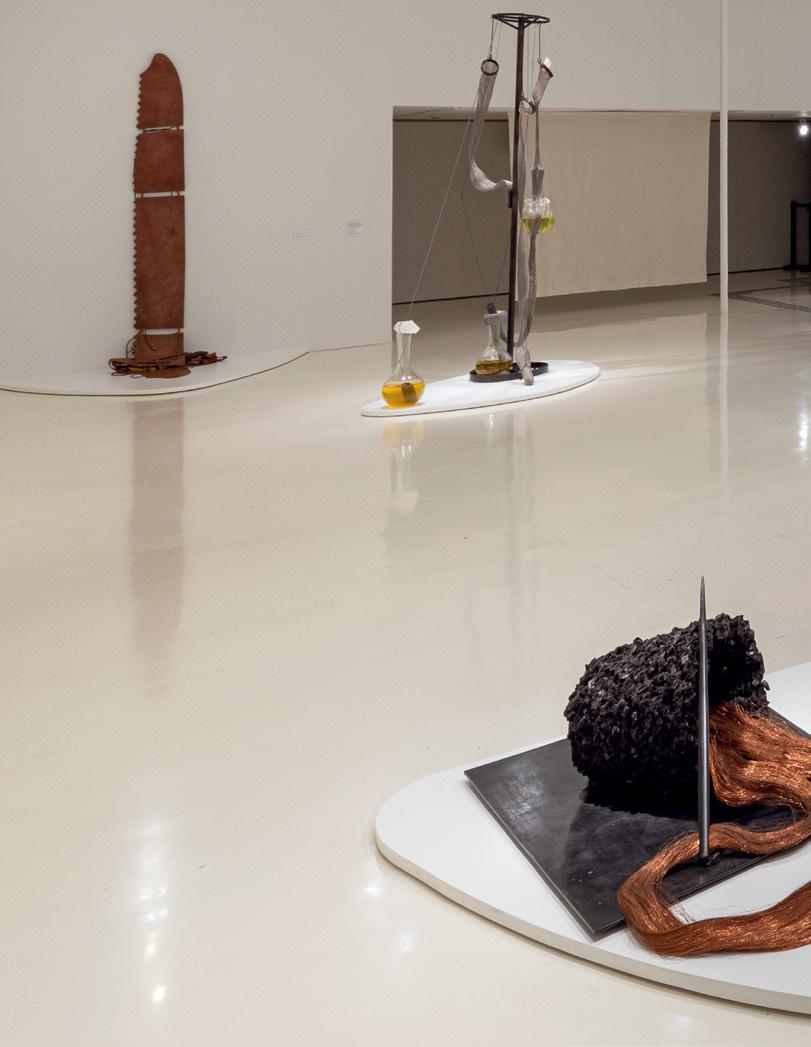
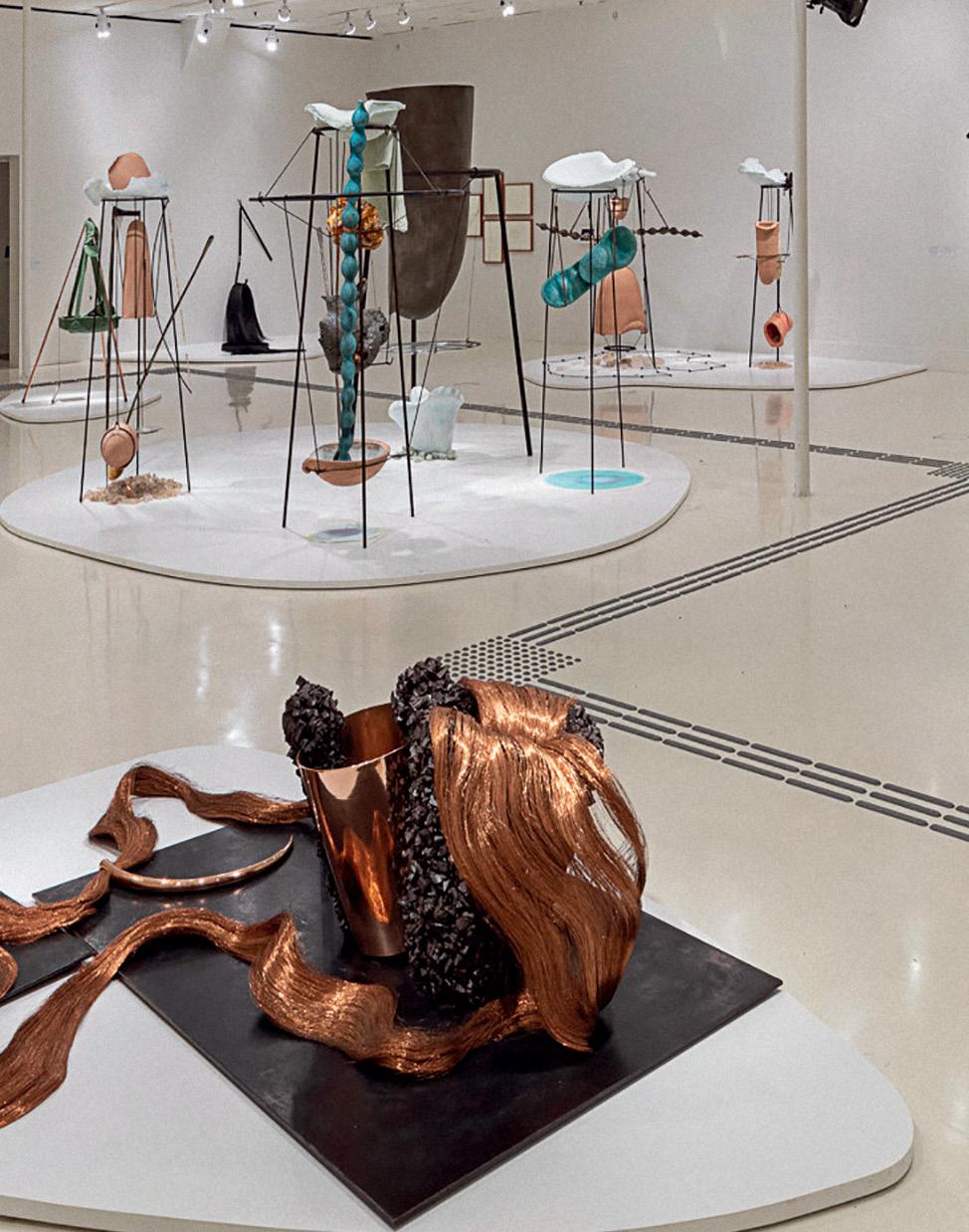
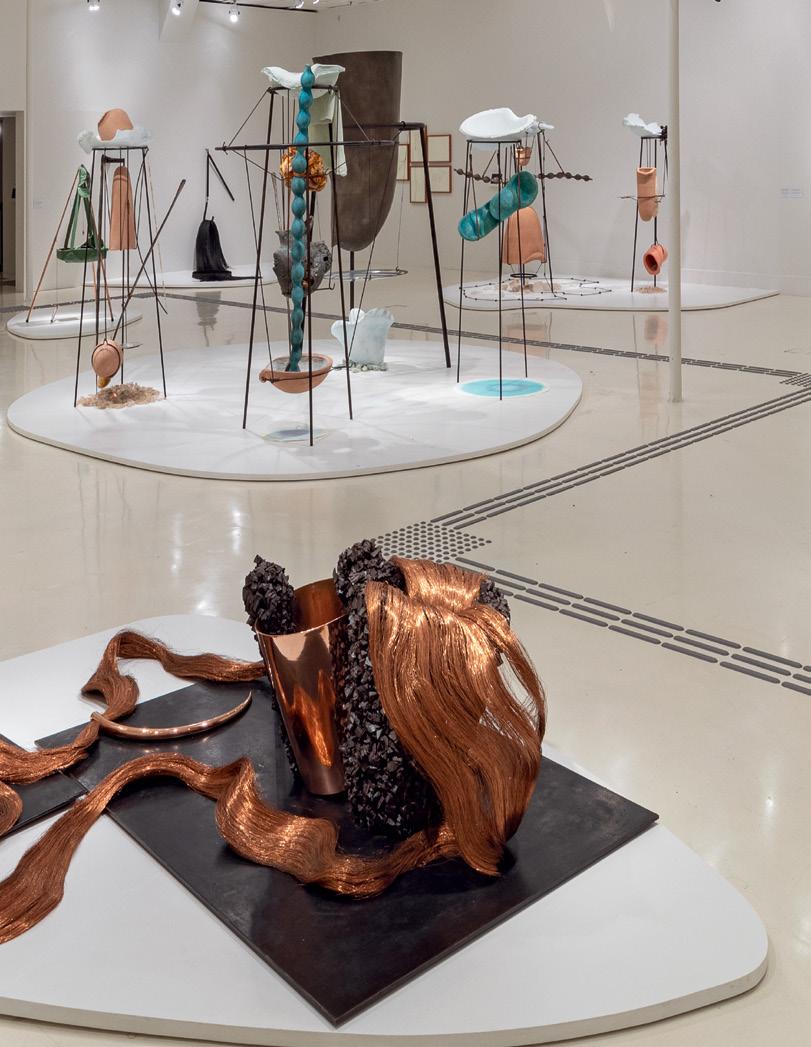

22, 23.
Sem título, da série |
Untitled, from the series Marionettes, 2010 aço-carbono, aço inoxidável, água cromatizada, cabo de aço, cristal de quartzo, ferro, ímã, resina epóxi, silicone e vidro | carbon steel, chromatized water, epoxy resin, glass, iron, magnet, quartz crystal, silicone, stainless steel, and steel cable dimensões variáveis | variable dimensions (150 x 180 x 300 cm) Acervo | collection Instituto Tunga
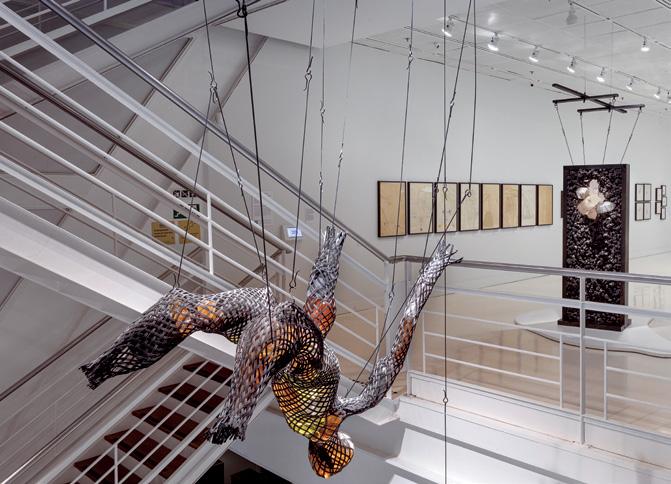
24.
Sem título, da série | Untitled, from the series “From ‘La Voie Humide’”, ca. 2014 pastel seco e tinta caligráfica sobre papel Nepal | dry pastel and calligraphic ink on Nepal paper 75 x 50,5 cm Acervo | collection Instituto Tunga
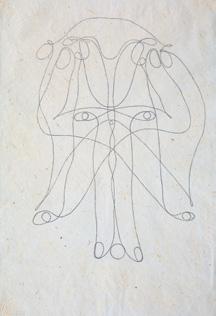
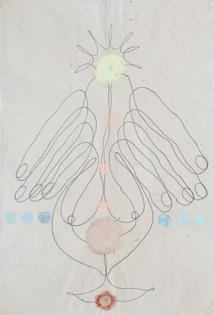
25.
Sem título, da série | Untitled, from the series “From ‘La Voie Humide’”, ca. 2014 pastel seco e tinta caligráfica sobre papel Nepal | dry pastel and calligraphic ink on Nepal paper 75,5 x 50,5 cm Acervo | collection Instituto Tunga
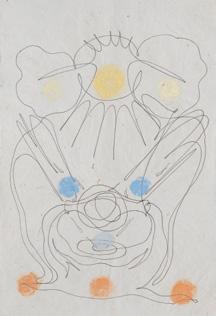
26.
Sem título, da série | Untitled, from the series “From ‘La Voie Humide’”, 2011 tinta caligráfica sobre papel Nepal | calligraphic ink on Nepal paper 75 x 50 cm
Acervo | collection Instituto Tunga
27.
Sem título, da série | Untitled, from the series “From ‘La Voie Humide’”, 2012 tinta caligráfica sobre papel Nepal | calligraphic ink on Nepal paper 75 x 50 cm
Acervo | collection Instituto Tunga
28.
Sem título, da série | Untitled, from the series “From ‘La Voie Humide’”, 2011 tinta caligráfica sobre papel Nepal | calligraphic ink on Nepal paper 75 x 50 cm Acervo | collection Instituto Tunga
29.
Sem título, da série | Untitled, from the series “From ‘La Voie Humide’”, 2014 tinta caligráfica sobre papel Nepal | calligraphic ink on Nepal paper 75 x 50 cm
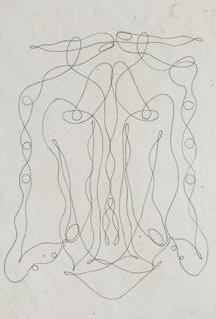

Acervo | collection Instituto Tunga

30.
Sem título, da série | Untitled, from the series Portal, 2010 aço inoxidável, cristal de quartzo, ferro e ímã | stainless steel, quartz crystal, iron, and magnet 60 x 74 x 300 cm
Acervo | collection Instituto Tunga
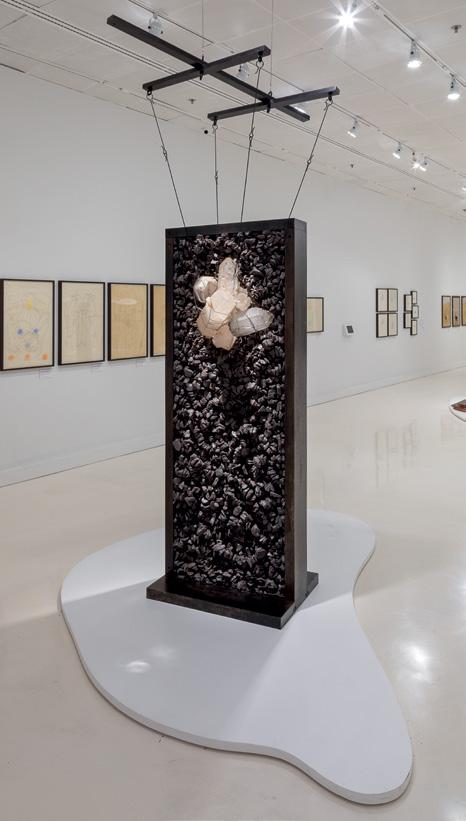
31.
, 1977 bronze, couro, ferro e dente | bronze, leather, iron, and tooth
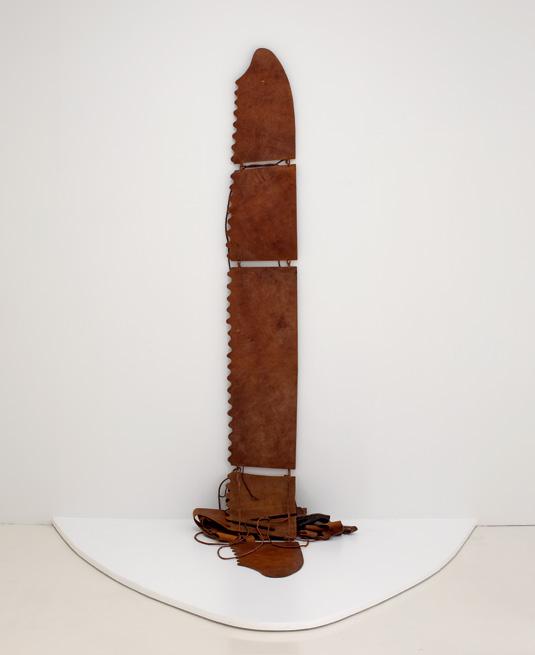
x
x
cm
Coleção | collection
Chateaubriand
MAM/RJ
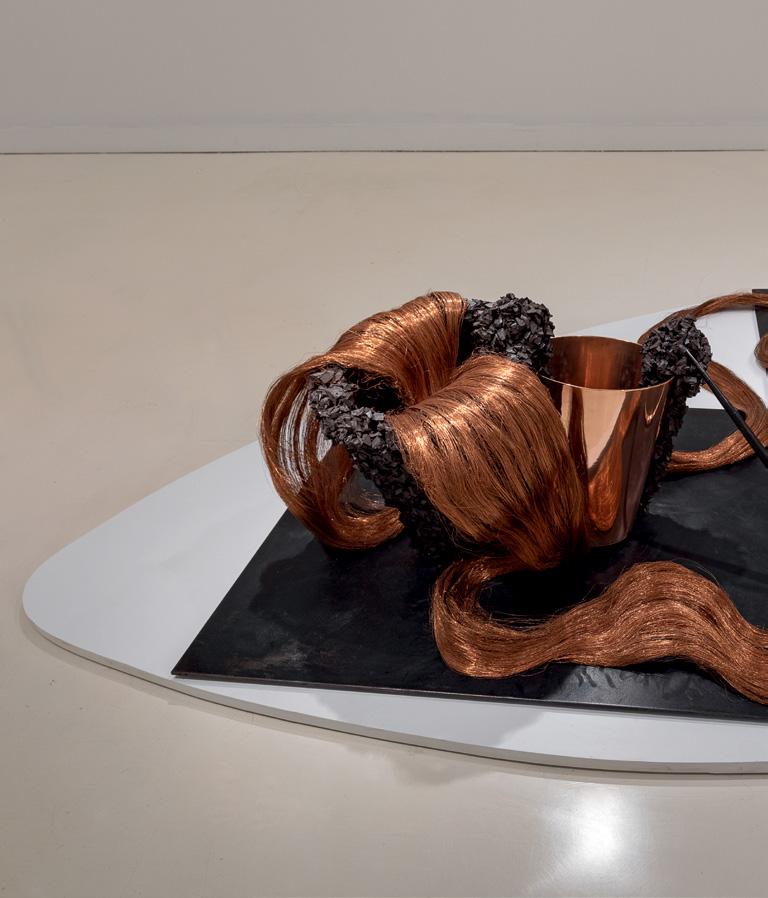
32. Palíndromo Incesto, 1989-1992 cobre, ferro, fio de cobre, ímã e limalha de ferro | copper, iron, copper wire, magnet, and iron filings dimensões variáveis | variable dimensions (65 x 150 x 245 cm) Acervo | collection
Banco Itaú
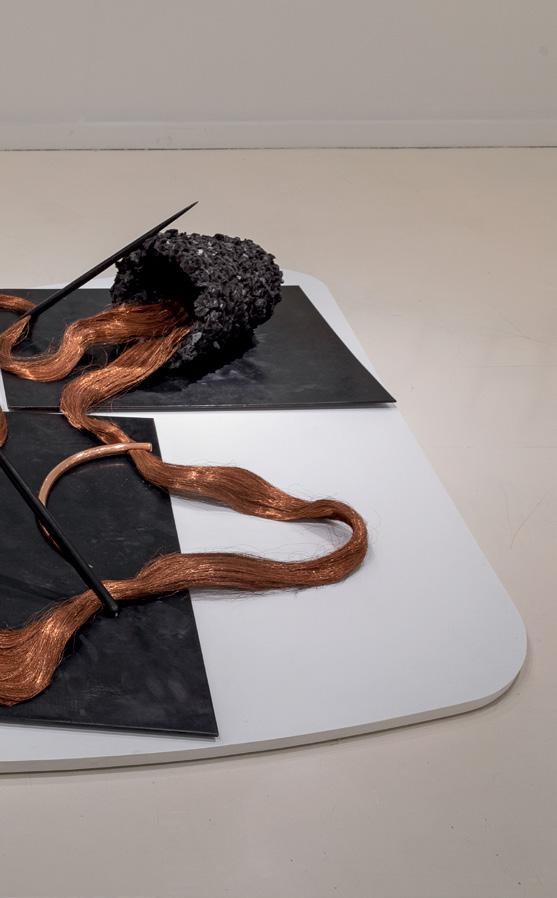
33.
Sem título, da série | Untitled, from the series “From ‘La Voie Humide’”, 2014 espelho, ferro e impressão sobre tecido | mirror, iron, and print on fabric 170 x 140 x 220 cm Acervo | collection Instituto Tunga
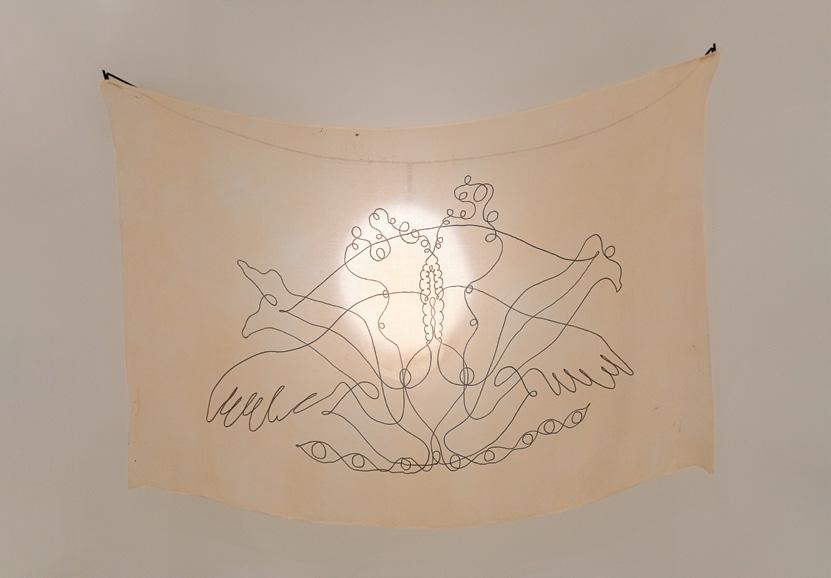
34.
Desenho Protuberante 2, 2010 cristal de quartzo, espelho, ferro, resina epóxi, têmpera sobre papel algodão e vidro | quartz crystal, mirror, iron, epoxy resin, tempera on cotton paper, and glass
75 x 59,1 x 7 cm
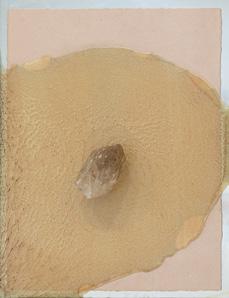
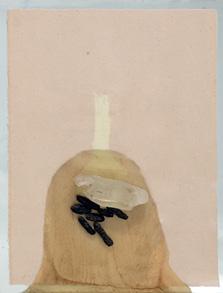
Acervo | collection Instituto Tunga
35.
Desenho Protuberante 6, 2010 cristal de quartzo, coprólitos, espelho, resina epóxi, têmpera sobre papel e vidro | quartz crystal, coprolites, mirror, epoxy resin, tempera on cotton paper, and glass
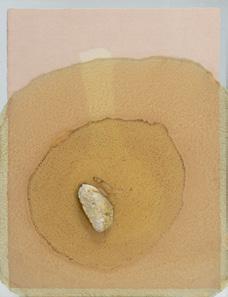
75,3 x 59 x 8,5 cm
Acervo | collection
Instituto Tunga
36.
Desenho Protuberante 3, 2010 cristal de quartzo, espelho, ferro, resina epóxi, têmpera sobre papel algodão e vidro | quartz crystal, mirror, iron, epoxy resin, tempera on paper, and glass
75 x 59,4 x 9 cm
Acervo | collection
Instituto Tunga
37.
Sem título, da série | Untitled, from the series “From ‘La Voie Humide’”, 2014 borracha, cascas de laranja, cerâmica, cristal de quartzo, couro, espelho, gesso, ferro e laranja | rubber, orange peels, ceramic, quartz crystal, leather, mirror, plaster, iron, and orange 180 x 150 x 200 cm Acervo | collection
Instituto Tunga
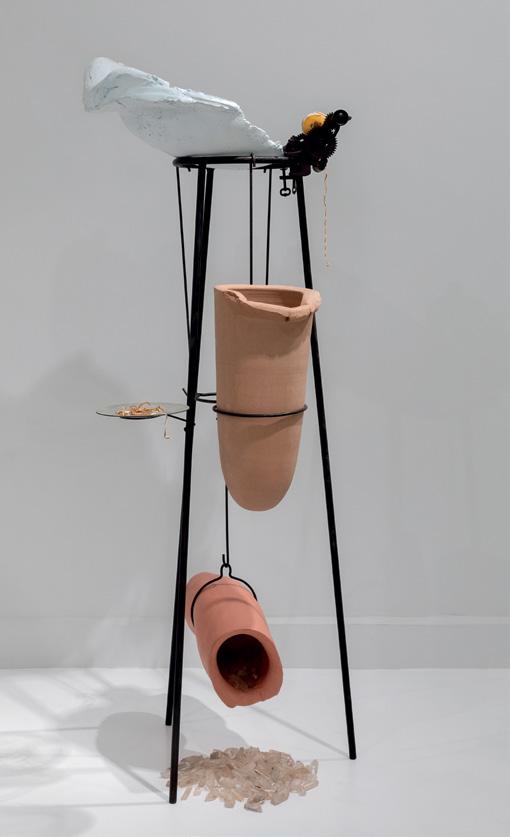
38.
Sem título, da série | Untitled, from the series “From ‘La Voie Humide’”, 2014 bronze, cerâmica, couro, cristal de quartzo, esponja marinha, espelho, fio de cobre, ferro, gesso e pérolas de vidro | bronze, ceramic, leather, quartz crystal, sea sponge, mirror, copper wire, iron, plaster, and glass pearls
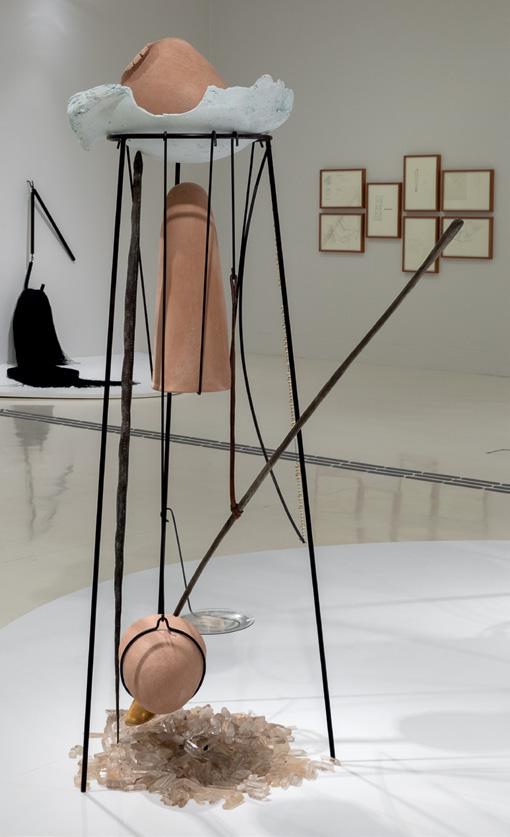
140 x 220 x 190 cm
Acervo | collection
Instituto Tunga
39
39. Piscina, 1975 aço, alumínio, borracha, chumbo, cobre, cordão de poliéster, ferro zincado, fotografia, latão, lona encerada, madeira, mel, tela de poliamida e TNT | steel, aluminum, rubber, lead, copper, polyester string, galvanized iron, photograph, brass, tarpaulin, wood, honey, polyamide and nonwoven fabric cópia de exibição | exhibition copy, 2021 150 x 120 x 120 cm
Acervo | collection
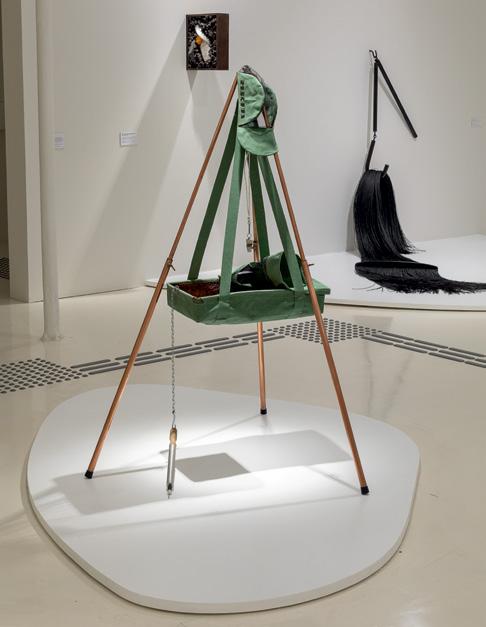
Instituto Tunga
Fotografia: Autor desconhecido, Sem título, ca. 1975
Photography: Artist unknown. Untitled, ca. 1975 20 x 28 cm reprodução em vinil autocolante sobre folha de alumínio | reproduction in adhesive vinyl on copper foil.
40
40.
Fração de Luz, 1981-2010 cabo de aço e ferro | steel cable and iron edição | edition 3/3 dimensões variáveis | variable dimensions (120 x 200 x 170 cm) Acervo | collection Instituto Tunga
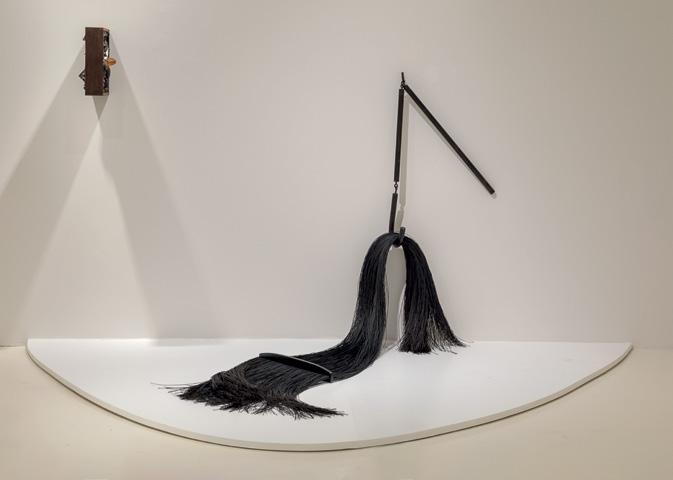
41.
Sem título, da série | Untitled, from the series Estojo, 2008-2015 aço, cristal de quartzo, ferro, ímã, resina epóxi e silicone | steel, quartz crystal, iron, magnet, epoxy resin, and silicone 32 x 20 x 38 cm Coleção | collection Elena Landau

42.
Sem título | Untitled, ca. 1970 (frente | front) aquarela e grafite sobre papel | watercolor and graphite on paper 20,5 x 27,4 cm Acervo | collection Instituto Tunga
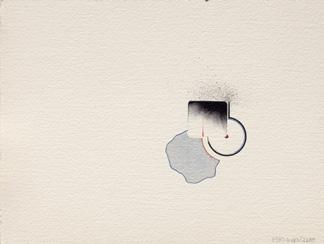
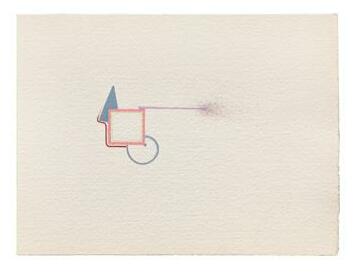
43.
Sem título | Untitled, ca. 1970 (verso | back) aquarela e nanquim sobre papel | watercolor and India ink on paper 20,5 x 27,4 cm Acervo | collection Instituto Tunga
44.
Vista da exposição com registro da performance
A Vanguarda Viperina, 1985 – reprodução de Lucia Helena Zaremba, projetada em canvas. | View of the exhibition with the record of the performance
A Vanguarda Viperina, 1985 – reproduction by Lucia Helena Zaremba, projected on canvas.
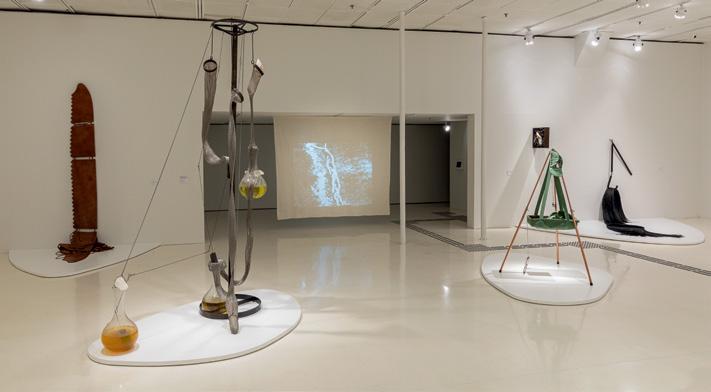
45. Vênus de Âmbar, da série | from the series “From ‘La Voie Humide’”, 2014 cerâmica, breu, couro, esponja marinha, ferro, gesso, tecido e pastel seco sobre papel | ceramic, colophony resin, leather, sea sponge, iron, plaster, fabric, and dry pastel on paper 200 x 150 x 80 cm Coleção | collection Marta e Paulo Kuczynski
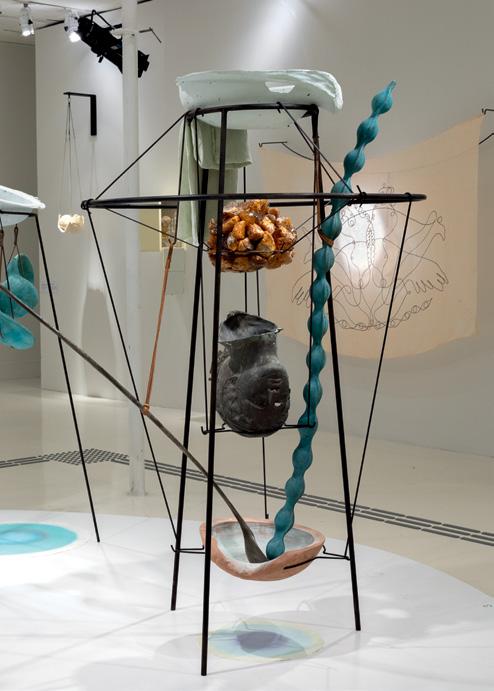
46.
The Splash of a Drop, da série | from the series “From ‘La Voie Humide’”, 2014 bronze, couro, gesso, ferro e pastel seco sobre papel | bronze, leather, plaster, iron, and dry pastel on paper 190 x 90 x 90 cm Acervo | collection Instituto Tunga
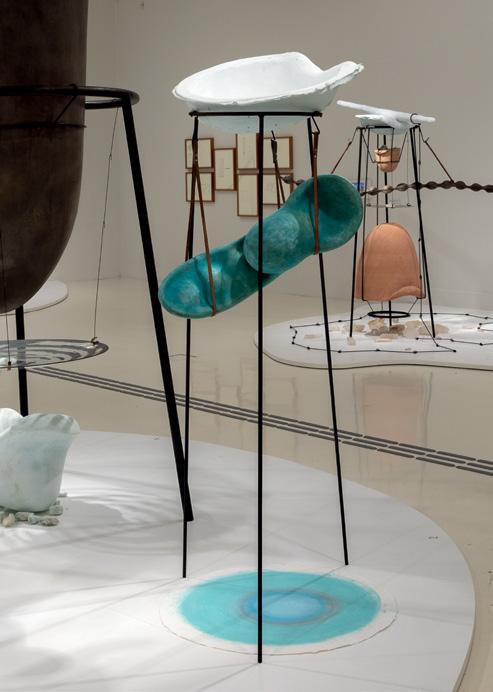
47.
Sem título, s.d. | Untitled, undated grafite sobre papel | graphite on paper 30,8 x 44,5 cm Acervo | collection Instituto Tunga
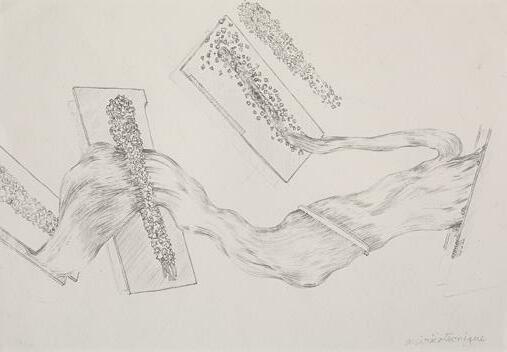
48.
Sem título, da série | Untitled, from the series “From ‘La Voie Humide’”, ca. 2014 pastel seco e tinta caligráfica sobre papel Nepal | dry pastel and calligraphic ink on Nepal paper 51 x 76 cm
Acervo | collection Instituto Tunga
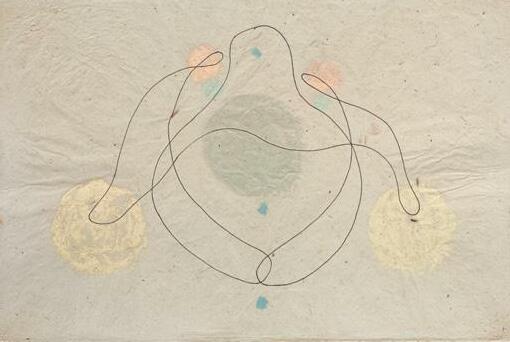
Phanografia, da série | from the series Quase Auroras, 2005 aquarela e grafite sobre papel algodão | watercolor and graphite on cotton paper 44,5 x 32,5 cm Acervo | collection Instituto Tunga
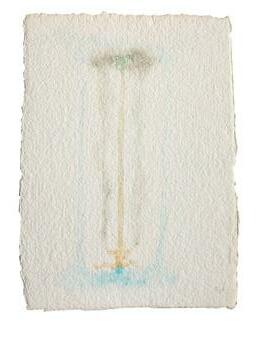
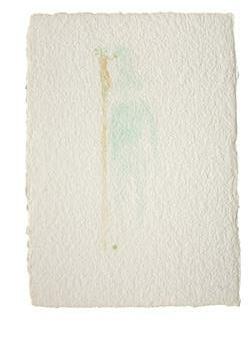
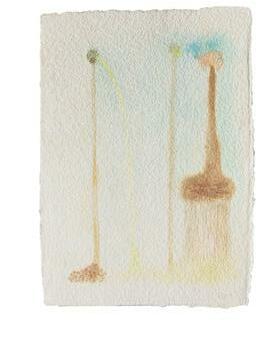
Phanografia, da série | from the series Quase Auroras, 2005 aquarela e grafite sobre papel algodão | watercolor and graphite on cotton paper 44,5 x 32 cm Acervo | collection Instituto Tunga
51.
Phanografia, da série | from the series Quase Auroras, 2005 aquarela e grafite sobre papel algodão | watercolor and graphite on cotton paper 44,2 x 32 cm Acervo | collection Instituto Tunga
52.
Sem título, da série | Untitled, from the series “From ‘La Voie Humide’”, 2014 bronze, cristal de água-marinha, espelho, ferro e gesso | bronze, aquamarine crystal, mirror, iron, and plaster 220 x 180 x 180 cm

Acervo | collection
Instituto Tunga
53.
Phanógrafo Policromático de Deposição, 2004-2009
água cromatizada, cabo de aço, cristal de quartzo, espelho, esponja marinha, ferro, fio de cobre, pérolas, madeira, matelassê e vidro | chromatized water, steel cable, quartz crystal, mirror, sea sponge, iron, copper wire, pearls, wood, matelassé, and glass 84,5 x 30 x 38 cm
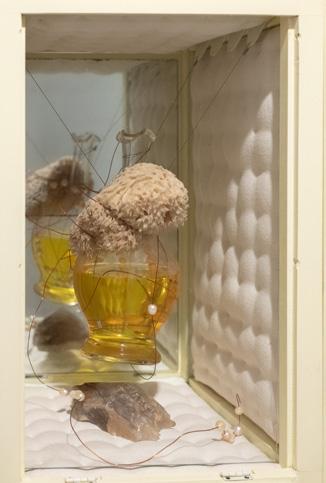
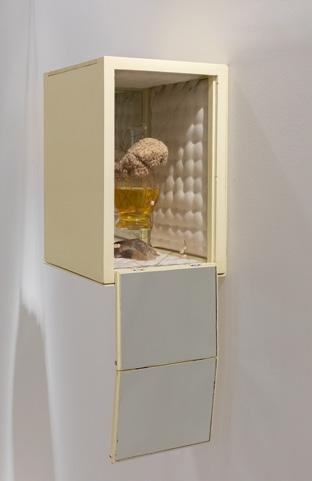
Acervo | collection
Instituto Tunga
54
54.
Sem título, da série |
Untitled, from the series Steel Pod, 2013 cabo de aço com pátina preta, concha do mar, ferragem, ferro fundido e ímã | steel cable with black patina, seashell, iron connector, cast iron, and magnet 120 x 50 x 50 cm Acervo | collection
Instituto Tunga
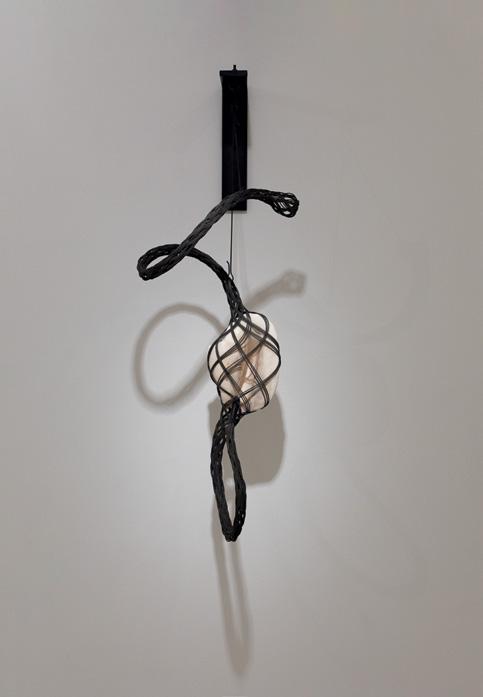
55.
Sem título | Untitled, 2008 aço-carbono, água cromatizada, cabo de aço, cristal de quartzo, ferro, ímã e vidro | carbon steel, chromatized water, steel cable, quartz crystal, iron, magnet, and glass 265 x 150 x 100 cm Acervo | collection Instituto Tunga
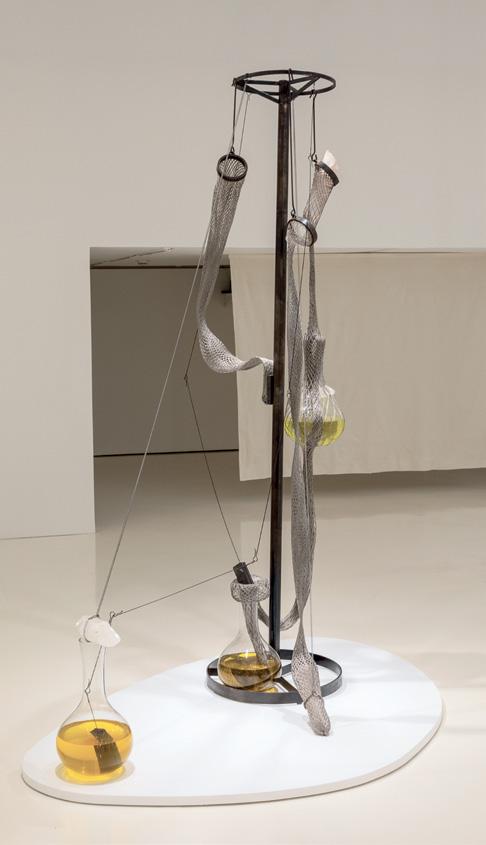
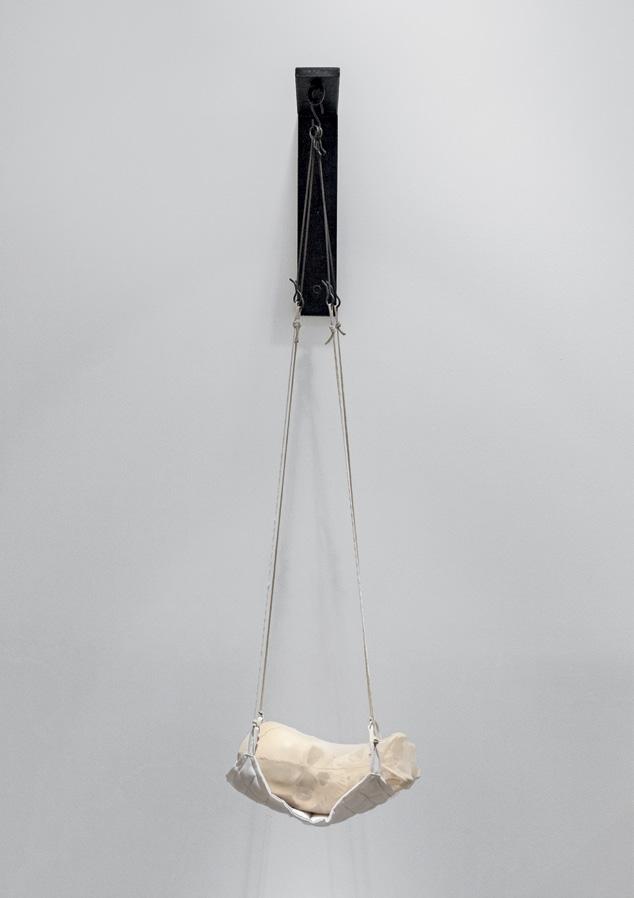
56.
Sem título, da série |
Untitled, from the series Berço de Crânios, 2011 cristal de quartzo, ferro, resina epóxi, tecido de algodão e tule de lycra | quartz crystal, iron, epoxy resin, cotton fabric, and Lycra tulle 135 x 35 x 37 cm Acervo | collection
Instituto Tunga
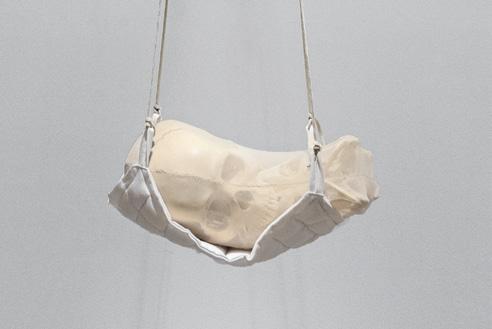
57.
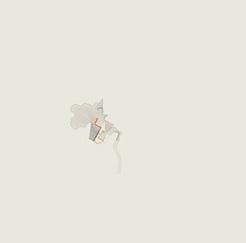
Sem título | Untitled, ca. 1970 aquarela sobre papel | watercolor on paper 35 x 34,3 cm
Acervo | collection Instituto Tunga
58.
Sem título | Untitled, ca. 1970 aquarela sobre papel | watercolor on paper 35,3 x 34 cm
Acervo | collection Instituto Tunga
59.
Sem título | Untitled, ca. 1970 aquarela sobre papel | watercolor on paper 35 x 35,5 cm
Acervo | collection Instituto Tunga
60.
Sem título | Untitled, ca. 1970 aquarela sobre papel | watercolor on paper 34,5 x 34,8 cm
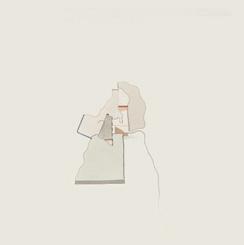
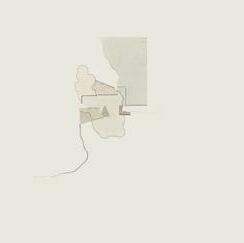
Acervo | collection Instituto Tunga

61.
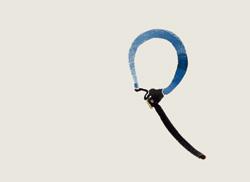
Sem título | Untitled, ca. 1970 aquarela e nanquim sobre papel | watercolor and India ink on paper 22,2 x 25,2 cm Acervo | collection Instituto Tunga
62.
Sem título | Untitled, ca. 1970 nanquim sobre papel | India ink on paper 21,7 x 24,2 cm Acervo | collection Roberto Profili
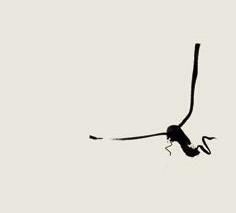
63.
Sem título | Untitled, ca. 1970 aquarela e nanquim sobre papel | watercolor and India ink on paper 33,3 x 24 cm Acervo | collection Instituto Tunga
64.
Sem título | Untitled, ca. 1970 aquarela e grafite sobre papel | watercolor and graphite on paper 21,5 x 19,1 cm Acervo | collection Instituto Tunga
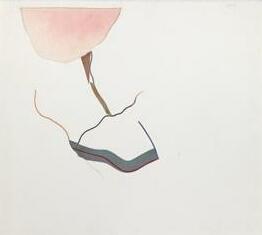
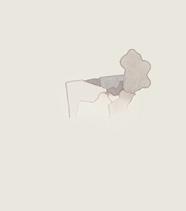
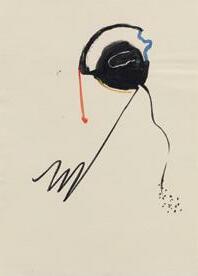
65.
Sem título | Untitled, ca. 1970 aquarela e nanquim sobre papel | watercolor and India ink on paper 24 x 33 cm Acervo | collection Instituto Tunga
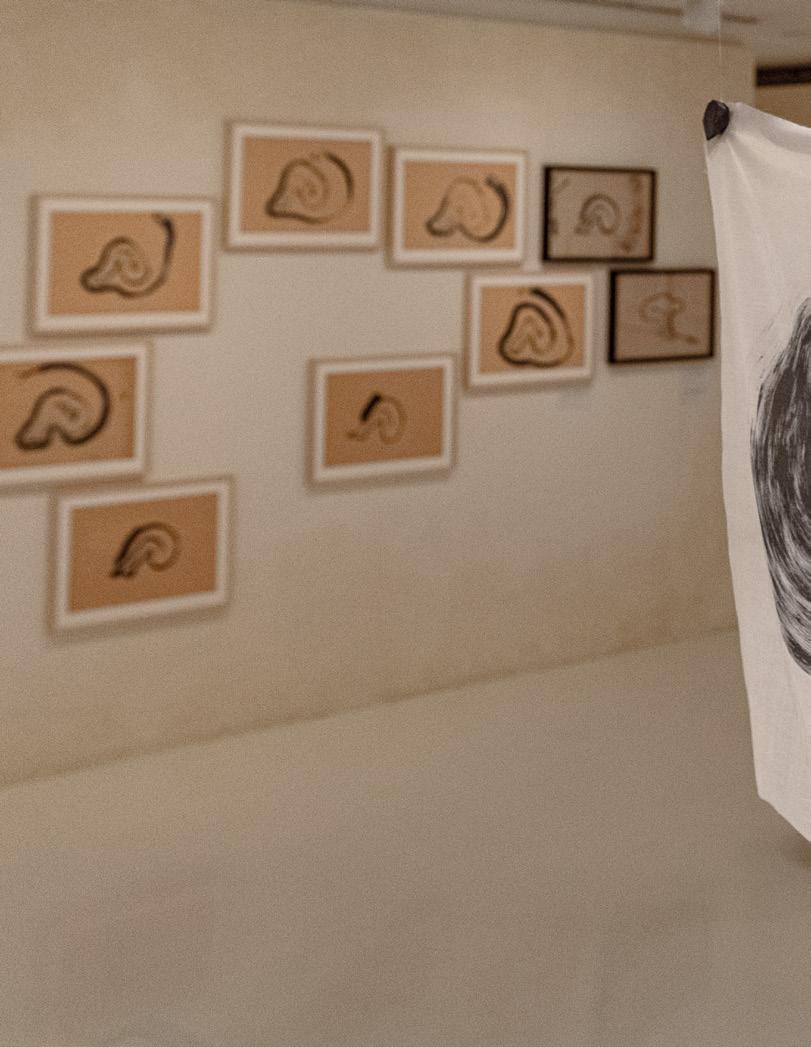
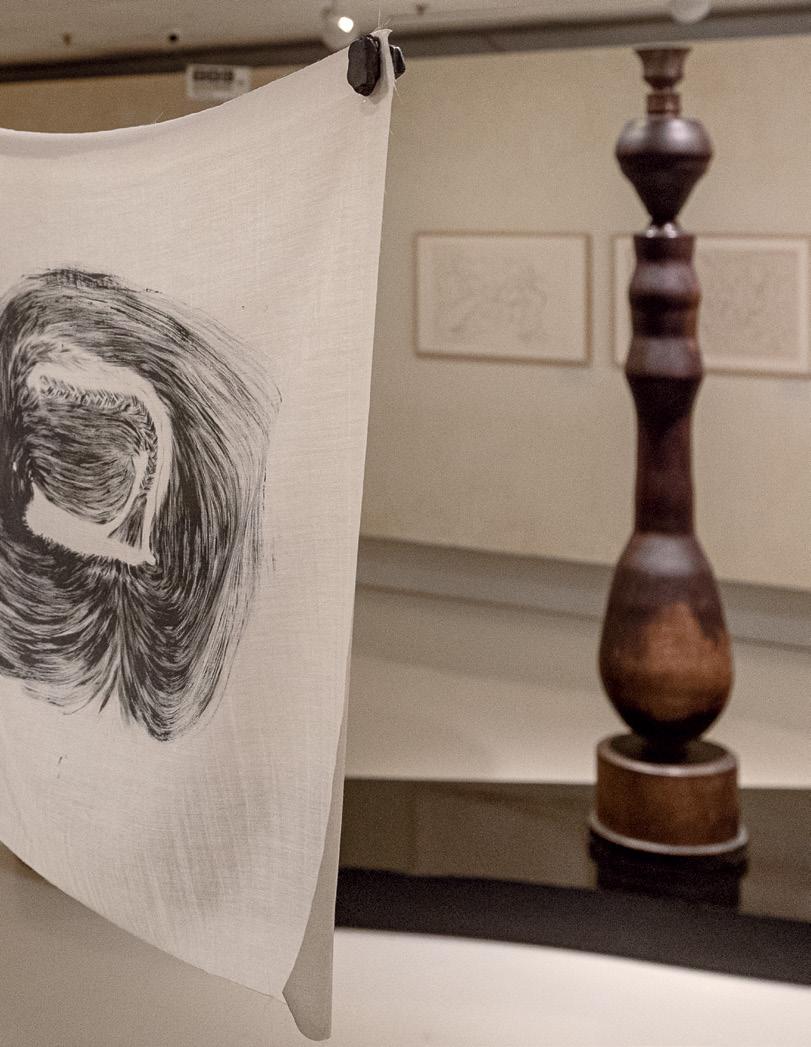

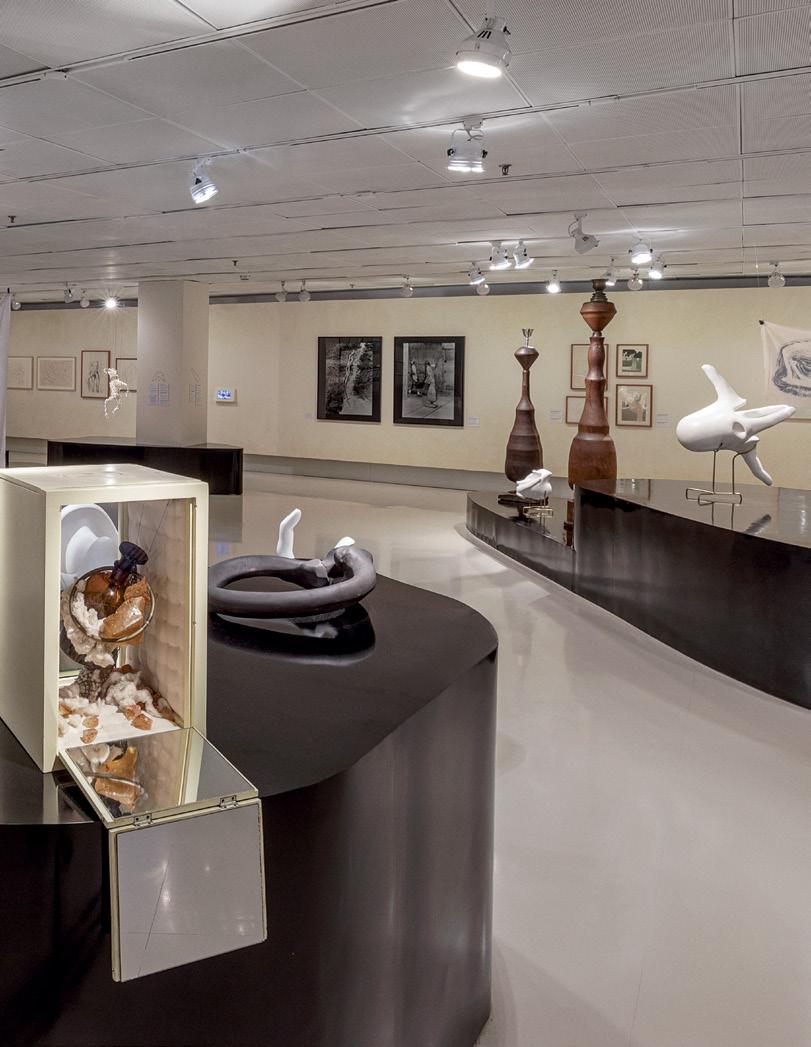
66. Eixo Exógeno, 1985-1997 madeira e aço | wood and steel 220 x 45 x 45 cm Coleção | collection Beth Jobim
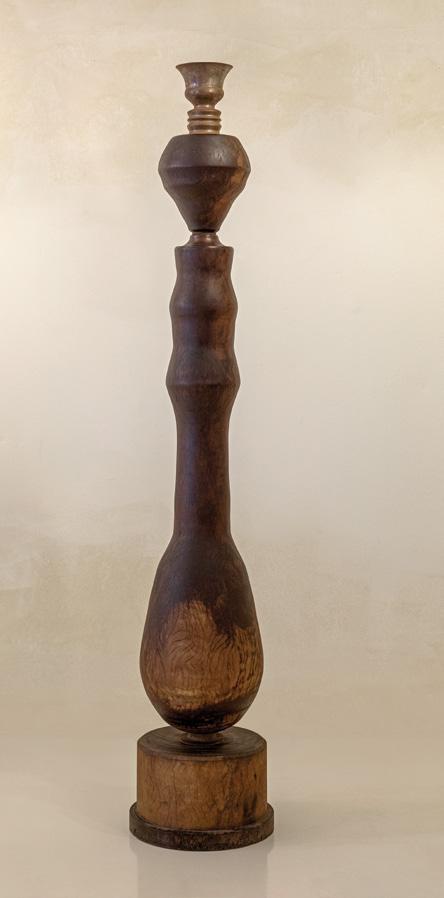
Trança, 2000 fio de chumbo | lead wire dimensões variáveis | variable dimensions (15 x 6 x 350 cm) Acervo | collection Instituto Tunga
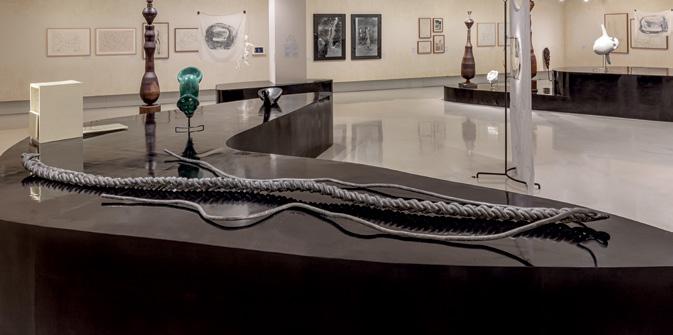
Tereza, 1999 ferro e tecido | iron and fabric dimensões variáveis | variable dimensions (altura 153 cm) Coleção | collection Luisa Malzoni Strina

69.
Sem título, da série | Untitled, from the series Gravitação Magnética, ca. 1980 aguada sobre papel | watered-down ink on paper 32,9 x 48,2 cm
Acervo | collection Instituto Tunga
70.
Sem título, da série | Untitled, from the series Gravitação Magnética, ca. 1980 aguada sobre papel | watered-down ink on paper 32,9 x 48,2 cm
Acervo | collection Instituto Tunga
71.
Sem título, da série | Untitled, from the series Gravitação Magnética, ca. 1980 aguada sobre papel | watered-down ink on paper 32,9 x 48,2 cm
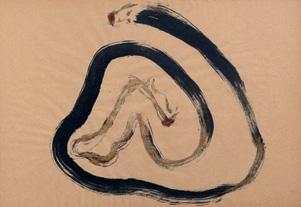
Acervo | collection Instituto Tunga
72.
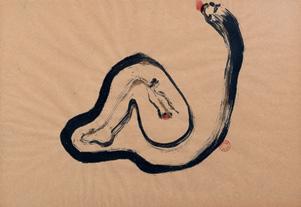
Sem título, da série | Untitled, from the series Gravitação Magnética, ca. 1980 aguada sobre papel | watered-down ink on paper 32,9 x 47,5 cm
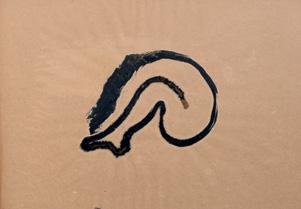
Acervo | collection Instituto Tunga
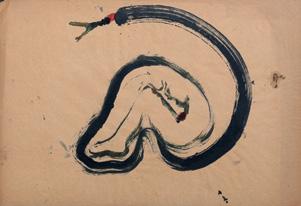
73.
Sem título, da série | Untitled, from the series Gravitação Magnética, ca. 1980 aguada sobre papel | watered-down ink on paper 32,9 x 48,1 cm Acervo | collection Instituto Tunga
74.
Sem título, da série | Untitled, from the series Gravitação Magnética, ca. 1980 aguada sobre papel | watered-down ink on paper 32,9 x 47,9 cm
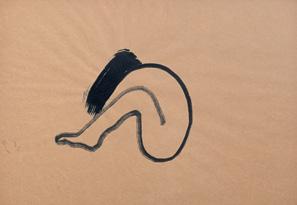
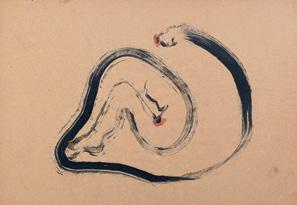
Acervo | collection Instituto Tunga
75.
Sem título, da série | Untitled, from the series Gravitação Magnética, ca. 1980 aguada sobre papel | watered-down ink on paper 32,9 x 47,5 cm
Acervo | collection Instituto Tunga
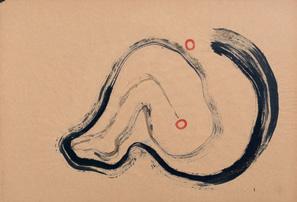
Veronica, da série | from the series “From ‘La Voie Humide’”, 2014 espelho, ferro e impressão sobre tecido | mirror, iron, and print on fabric 215 x 170 x 100 cm Acervo | collection Instituto Tunga
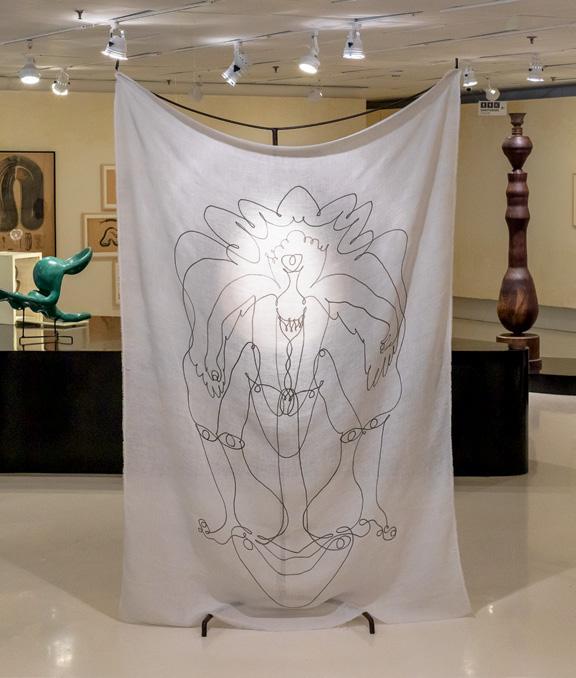
Sem título, da série | Untitled, from the series Morfológicas, 2014 bronze e ferro | bronze and iron edição 3/3 + P.A. | edition 3/3 + A.P. 75 x 53 x 25 cm Acervo | collection Instituto Tunga

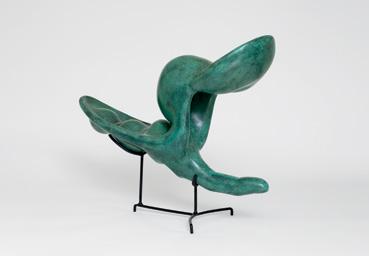
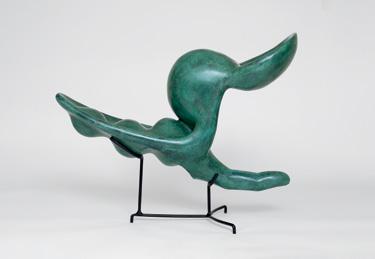
78.
Sem título, da série | Untitled, from the series Morfológicas, 2014 bronze 66 x 71 x 45 cm edição 1/3 + P.A. | edition 1/3 + A.P. Acervo | collection Instituto Tunga
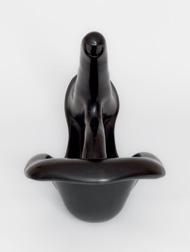
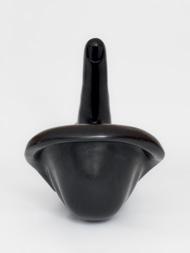
79.
Sem título, da série | Untitled, from the series Marionettes, 2010-2011 cristal de quartzo, ferro, fio de cobre, latão e pérolas de vidro | quartz crystal, iron, copper wire, brass, and glass pearls 180 x 50 x 40 cm
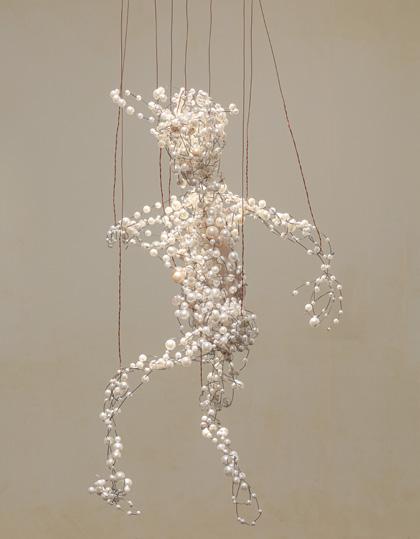
Acervo | collection Instituto Tunga
80.
Sem título | Untitled, ca. 1990 pastel oleoso sobre papel | oil pastel on paper 44,1 x 69,5 cm Acervo | collection Instituto Tunga
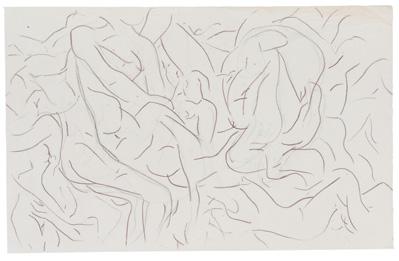
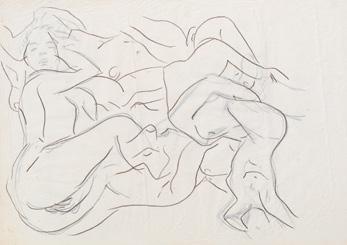
81.
Sem título | Untitled, ca. 1990 pastel oleoso sobre papel | oil pastel on paper 45,5 x 64 cm Acervo | collection Instituto Tunga
82.
Sem título, da série |
Untitled, from the series Desenhos em Polvorosa, s.d. | undated carvão sobre papel | charcoal on paper 50 x 71,5 cm
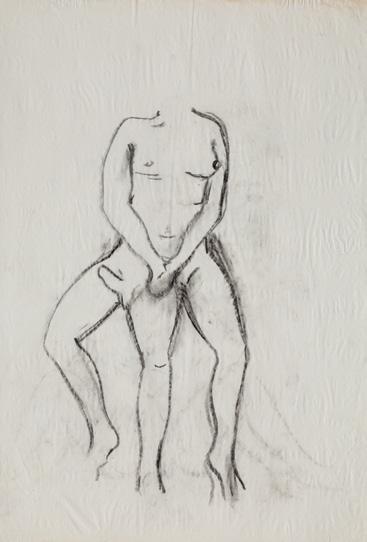
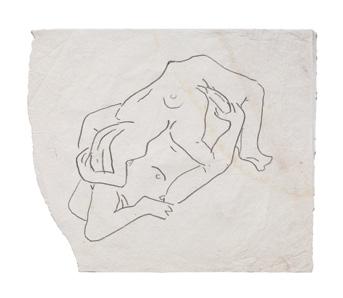
Acervo | collection Instituto Tunga
83.
Sem título | Untitled, s.d. | undated carvão sobre papel | charcoal on paper 55 x 46 cm Acervo | collection Instituto Tunga
84.
Sem título | Untitled, 1979-1983 grafite sobre papel | graphite on paper 48,5 x 66 cm Acervo | collection Instituto Tunga
85.
Sem título | Untitled, 1979-1983 grafite sobre papel | graphite on paper 48,5 x 66 cm Acervo | collection Instituto Tunga
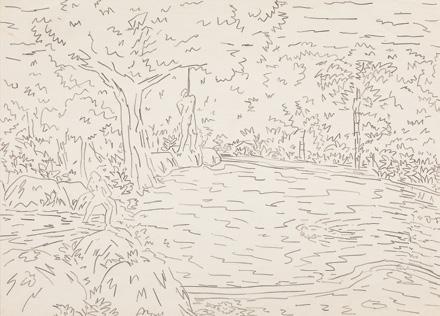
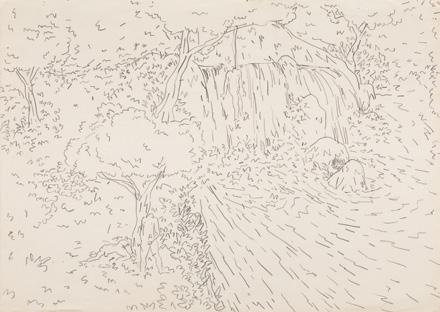
86.
Toro, 1983 ferro fundido | cast iron 20 x 60 x 60 cm Coleção | collection Andréa e José Olympio Pereira
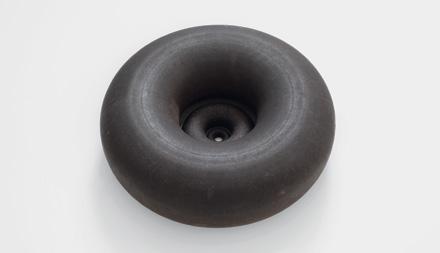
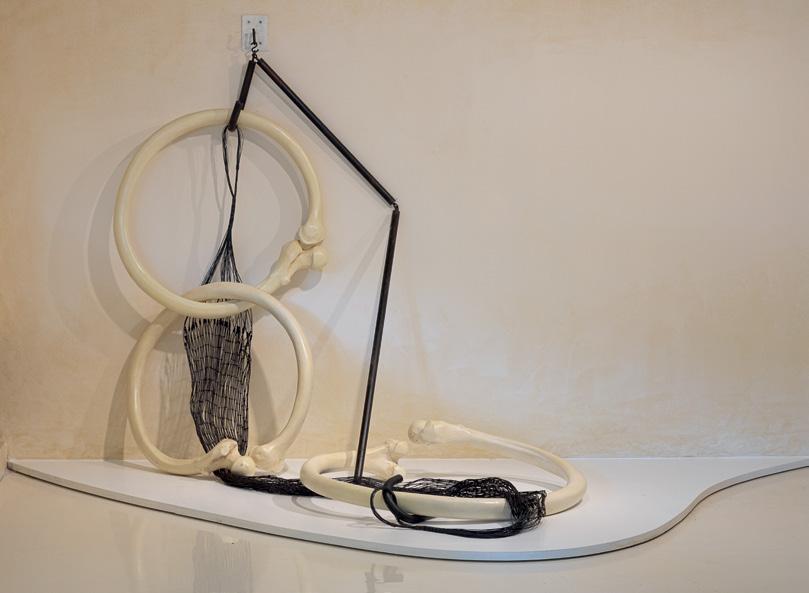
88.
Sem título, da série | Untitled, from the series Eixo Exógeno, 1996 pastel seco sobre papel | dry pastel on paper 188 x 57 cm Acervo | collection Instituto Tunga


89.
Sem título, da série | Untitled, from the series Eixo Exógeno, 1986 pastel seco sobre papel | dry pastel on paper 179,5 x 48 cm Acervo | collection Instituto Tunga
90. Eixo Exógeno, 1985 latão e madeira | brass and wood 202 x 40 x 40 cm Coleção | collection Luiz Buarque de Hollanda
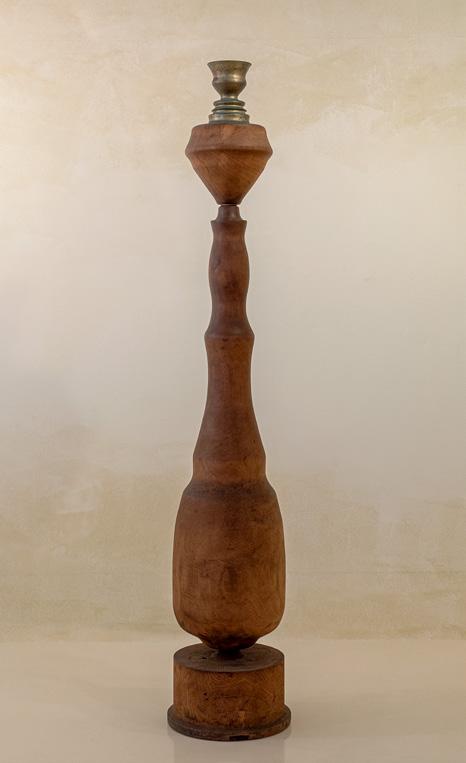
91.
Sem título | Untitled, 2007 cabo de aço, ferro fundido, ímã e vidro fundido | steel cable, cast iron, magnet, and cast glass 120 x 55 x 50 cm edição | edition 1/2 Coleção | collection Luis Paulo Montenegro
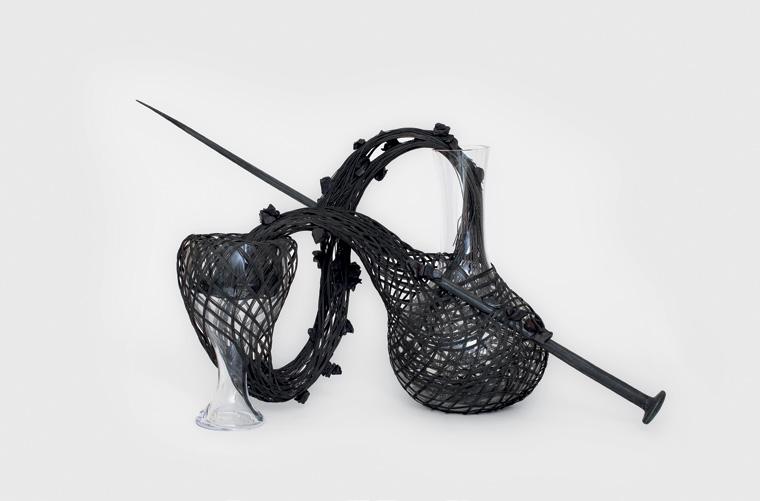
92.
Objeto do Conhecimento Infantil, 1975 feltro, chumbo, parafina, algodão, metal e alumínio | felt, lead, paraffin, cotton, metal, and aluminum 7 x 20 x 18 cm Coleção particular | private collection
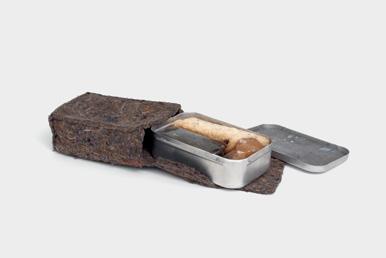
93.
Objeto do Conhecimento Infantil, 1974 aço inoxidável, alumínio, cera, chumbo e feltro | stainless steel, aluminum, wax, lead, and felt 2,5 x 5,7 x 9,6 cm (fechado | closed) Coleção | collection Patrícia e Waltercio Caldas
94.
Da Pele, 1975 madeira, feltro, aço inoxidável, elástico e termômetro | wood, felt, stainless steel, elastic cord, and thermometer 18 x 34 x 21,5 cm Coleção | collection Thiago Gomide
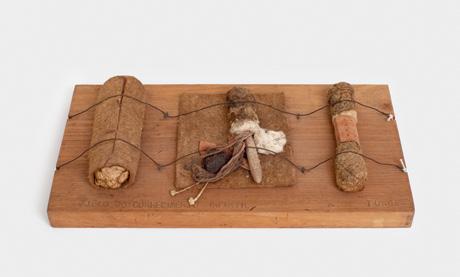

95.
Les Bijoux de Madame de Sade, 1983-2018 ferro, ímã e limalha de ferro | iron, magnet and iron filings 25 x 24,5 x 12 cm edição 1/2 P.A. + 10 | edition 1/2 A.P. + 10 Acervo | collection Instituto Tunga
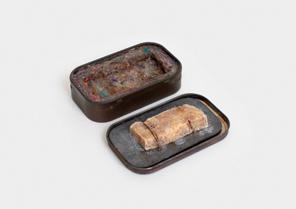
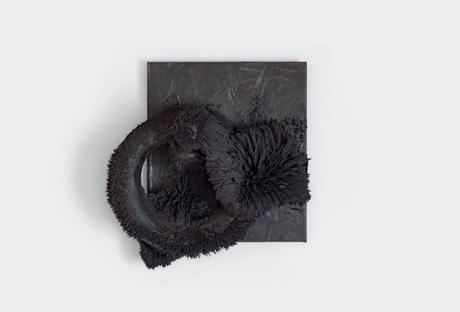
96.
Objeto do Conhecimento Infantil, 1974 aço inoxidável, algodão embebido em parafina, bastonete de feltro, cobertor de fibras recicladas, elástico, gaze, madeira e palha de aço | stainless steel, paraffinsoaked cotton, felt stick, blanket of recycled fibers, elastic cord, gauze, wood, and steel wool 27 x 52 x 10 cm
Acervo | collection
Instituto Tunga
97
97.
Wilton Montenegro
Xifópagas Capilares entre Nós / Eixo exógeno de | of Jacqueline Silva, 1986 fotografia em papel metalizado | photograph on metalized paper 102 x 76 cm Foto realizada durante as filmagens de O Nervo de Prata, de Arthur Omar | Photo taken during the filming of O Nervo de Prata, by Arthur Omar Acervo | collection Instituto Tunga © Wilton Montenegro
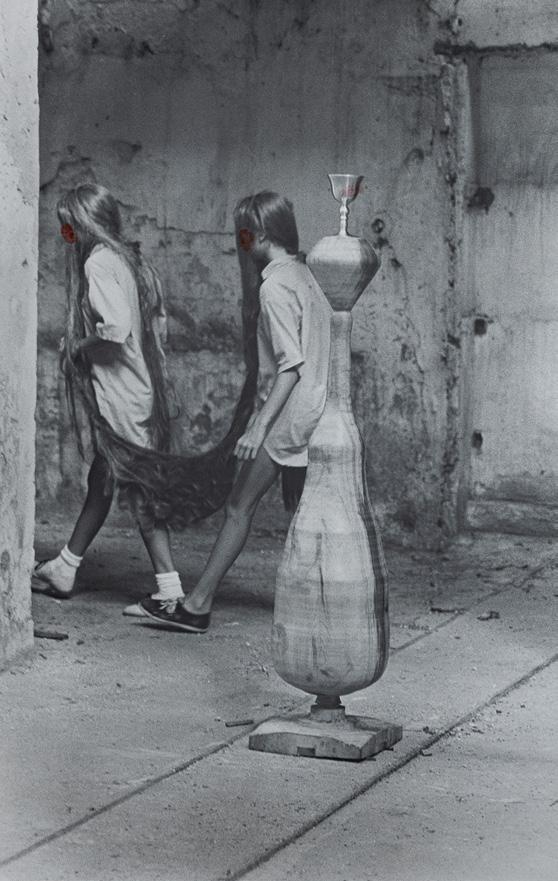
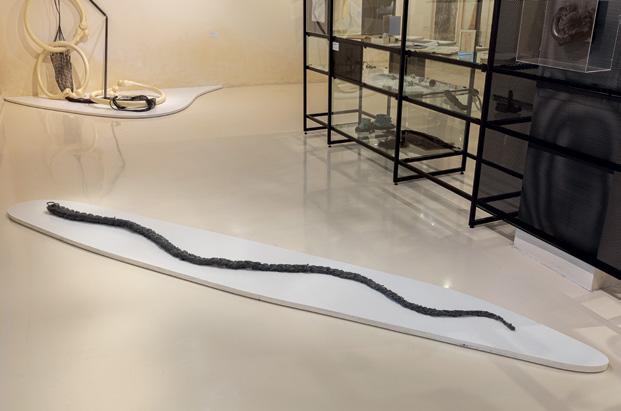
99.
Sem título, da série | Untitled, from the series Tarsila como curvas francesas, 1979-1980
aquarela sobre papel | watercolor on paper 35,5 x 23,5 cm
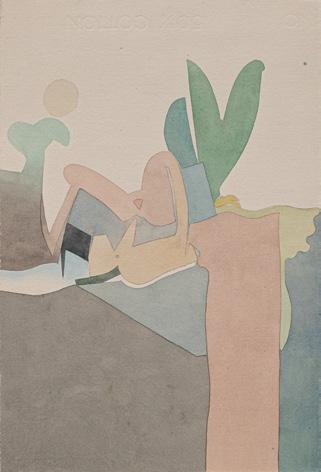
Acervo | collection Instituto Tunga
100.
Sem título, da série | Untitled, from the series Estojo, 2008-2011
aço-carbono, ferro, ímã, resina epóxi, silicone e vidro | carbon steel, iron, magnet, epoxy resin, silicone, and glass 167 x 37 x 52 cm
Acervo | collection Instituto Tunga
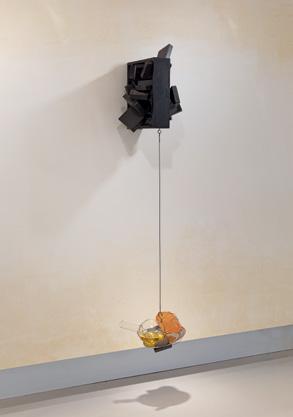
101. Matriz para | printing plate for Bordas, ca. 1980 zinco | zinc 45,5 x 32 x 0,01 cm Acervo | collection Instituto Tunga
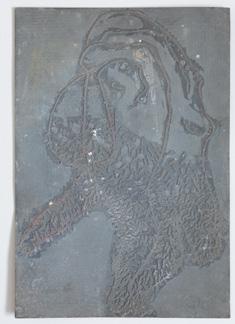
102. Sem título, da série | Untitled, from the series Bordas, 1983 impressão dourada e serigrafia sobre papel | golden print and silkscreen on paper 63 x 63 cm Acervo | collection Instituto Tunga
103. Sem título, da série | Untitled, from the series Bordas, 1987 impressão dourada e serigrafia sobre papel | golden print and silkscreen on paper 63 x 63 cm Acervo | collection Instituto Tunga
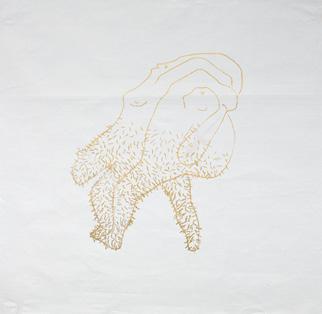
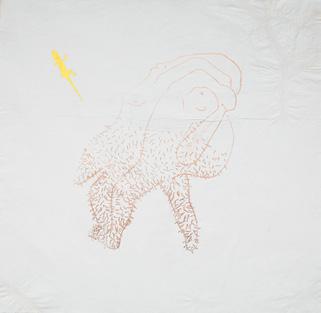
105
104.
Escalpo, 1981 latão | brass 25 x 26 cm Coleção | collection Fernanda Feitosa e Heitor Martins
105.
Escalpo, 1983 latão | brass 55 x 65 x 5 cm Coleção | collection Raquel Arnaud
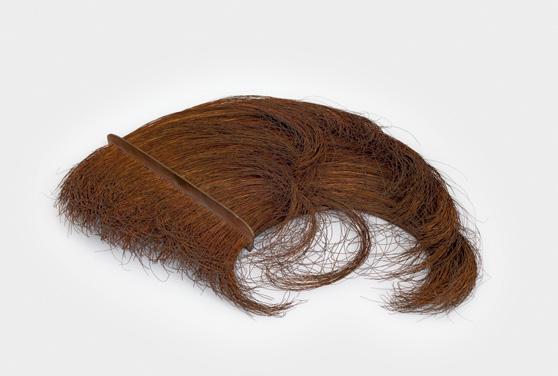
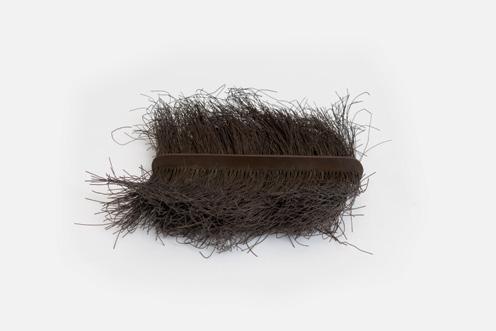
106.
Sem título, da série | Untitled, from the series Morfológicas, 2014 resina | resin edição P.A. + 3 | edition A.P. + 3 50 x 70 x 86 cm Acervo | collection Instituto Tunga
107.
Sem título, da série | Untitled, from the series Morfológicas, 2014-2017 bronze 26 x 92 x 33 cm edição 1/3 + P.A. | edition 1/3 + A.P. Acervo | collection Instituto Tunga
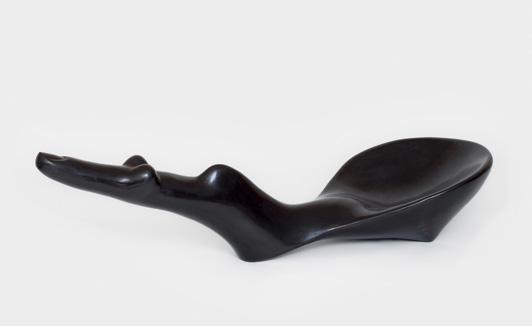
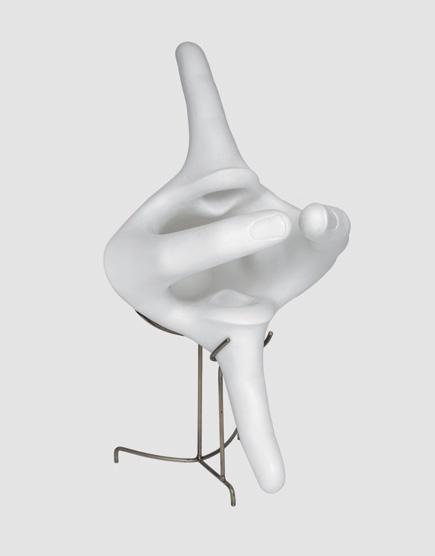
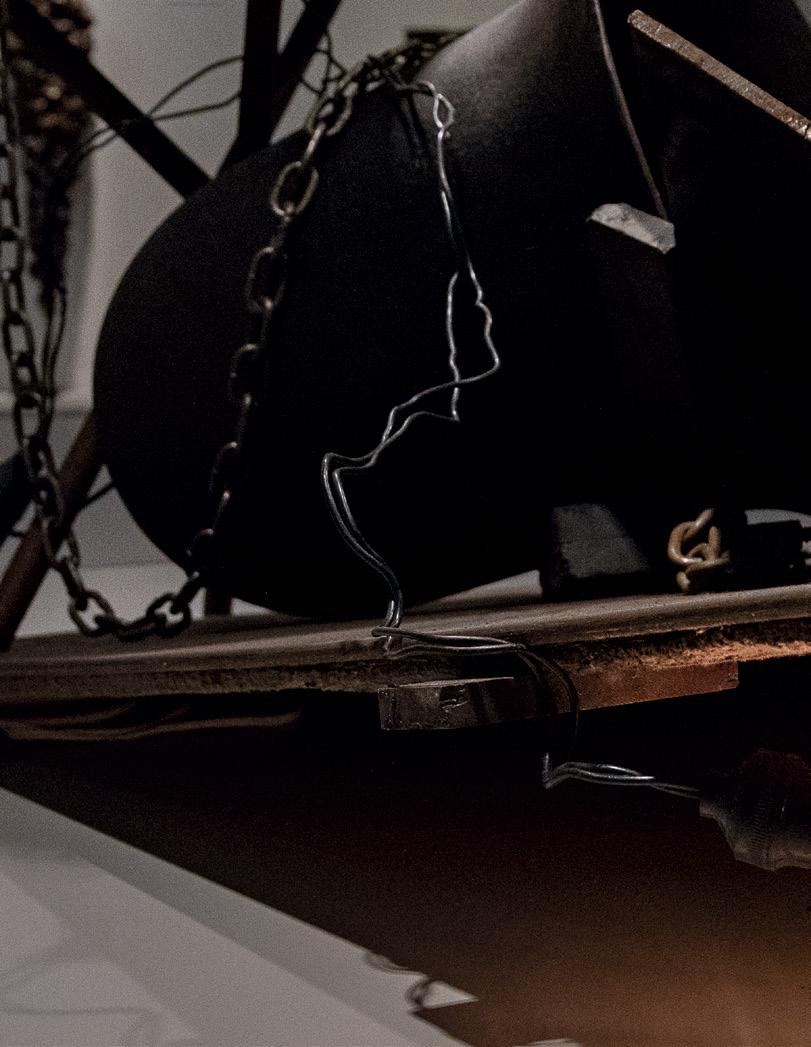
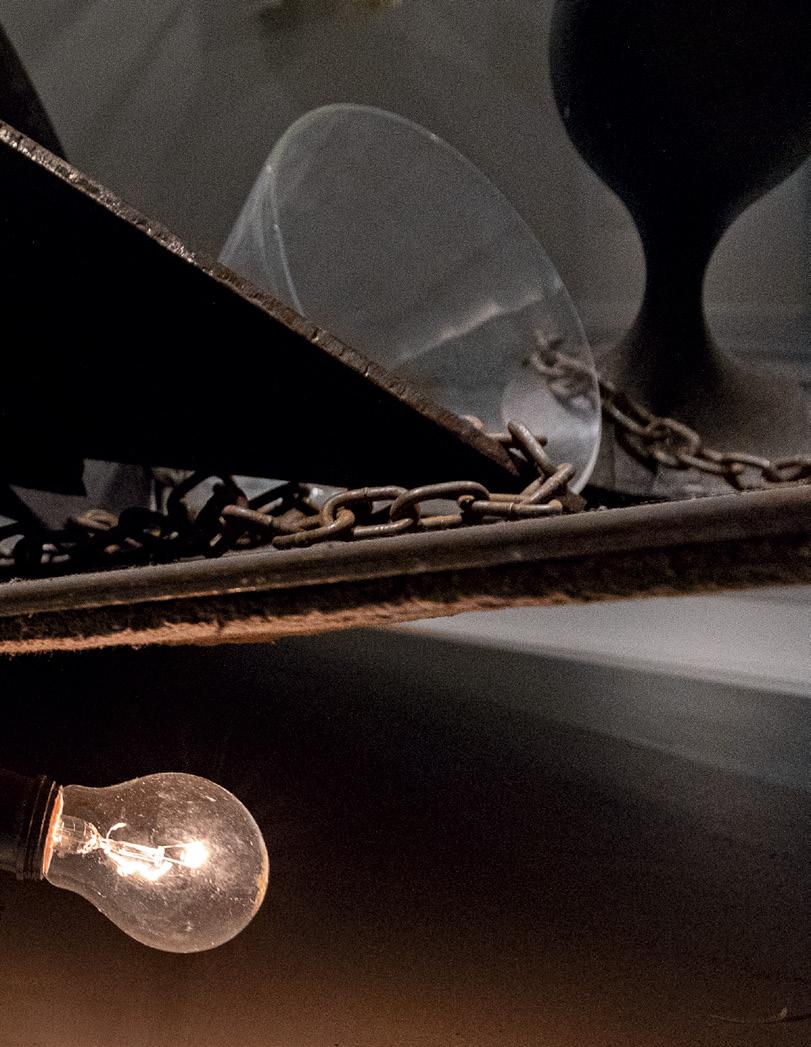
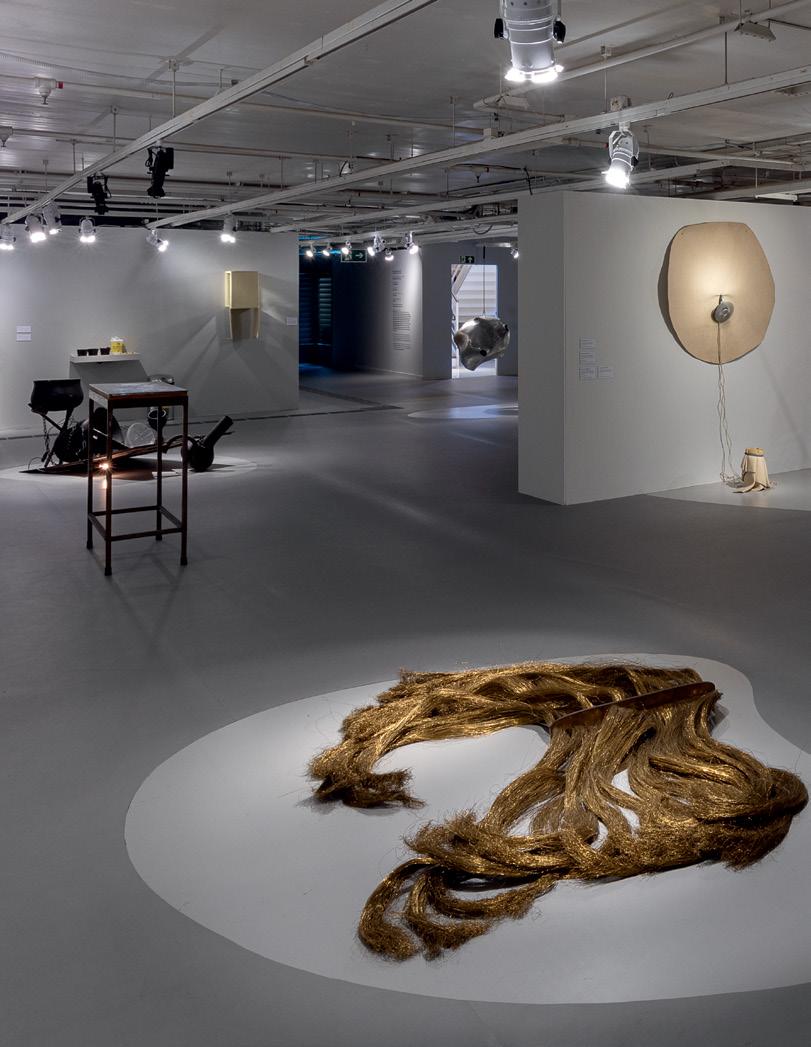
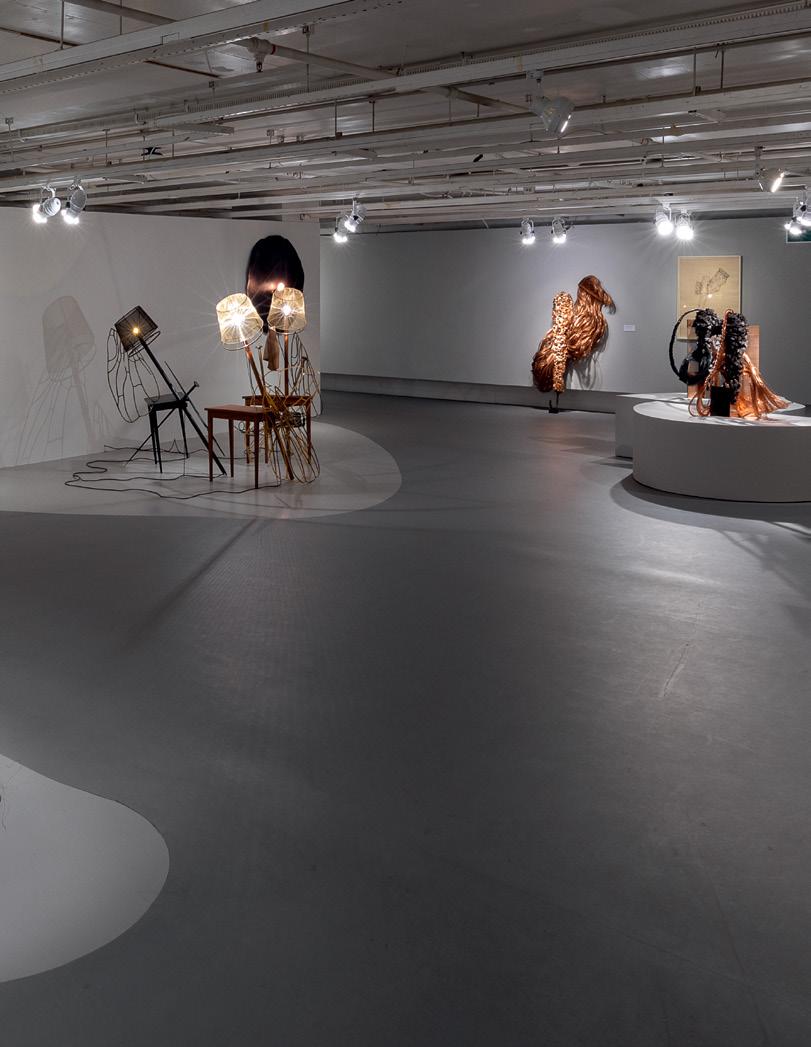
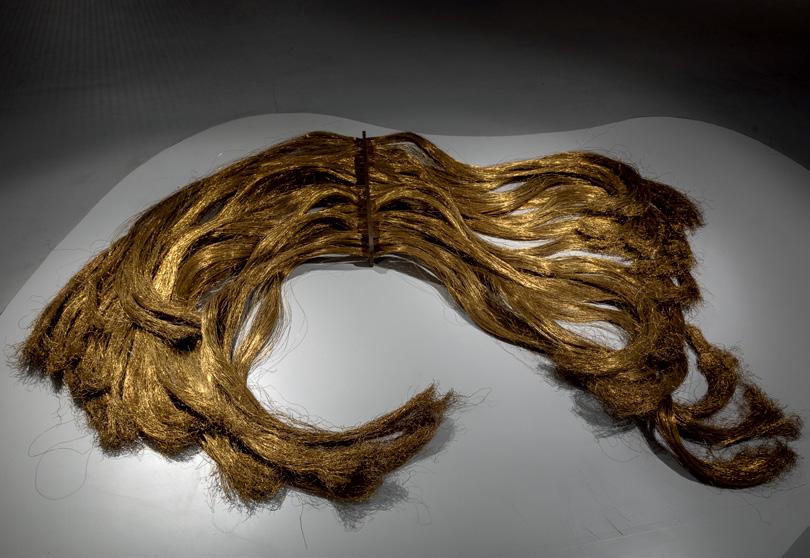
109.
Vê-nus, 1976 borracha, lâmpada, material elétrico e metal | rubber, lightbulb, electrical material, and metal 190 x 250 x 150 cm Acervo | collection Instituto Tunga
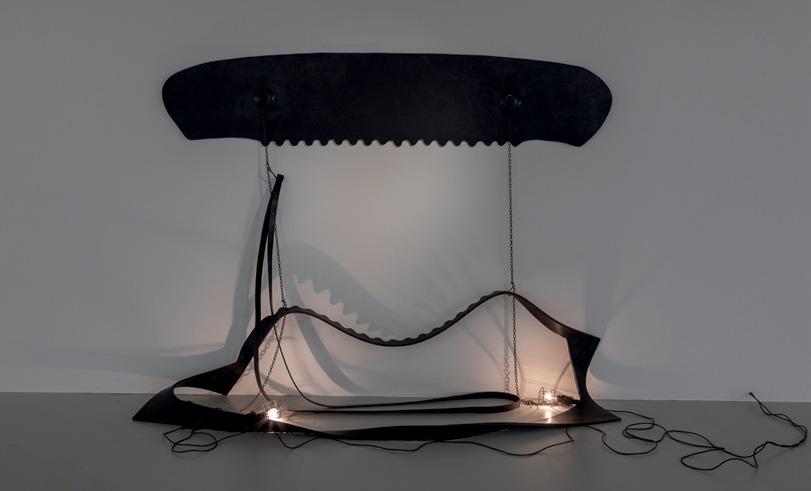
110.
Sem título | Untitled, 2007 couro, latão fundido, madeira, material elétrico, resina epóxi e tela de latão | leather, cast brass, wood, electrical material, epoxy resin, and brass mesh edição | edition 1/3 160 x 100 x 100 cm

Acervo | collection
Instituto Tunga
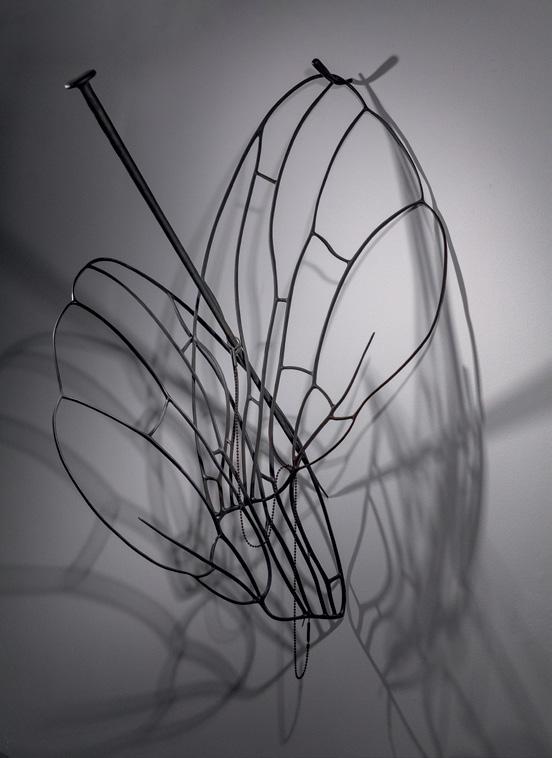
112.
Sem título, da série | Untitled, from the series Vê-nus, 1970 carvão sobre papel | charcoal on paper 28,7 x 38,1 cm Acervo | collection Instituto Tunga
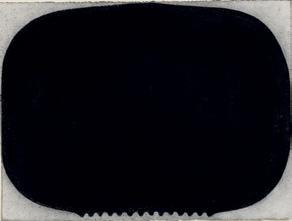
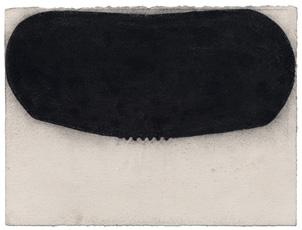
113.
Sem título, da série | Untitled, from the series Vê-nus, 1970 carvão sobre papel | charcoal on paper 28,5 x 38,6 cm Acervo | collection Instituto Tunga
114.
Sem título, da série |
Untitled, from the series Vê-nus, 1970 aquarela e nanquim sobre papel | watercolor and India ink on paper 33,6 x 52,2 cm
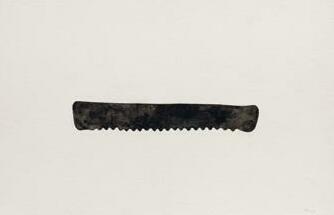
Acervo | collection
Instituto Tunga
115.
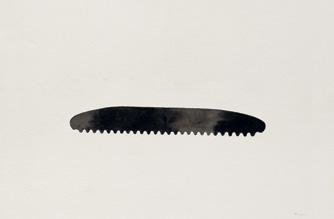
Sem título, da série |
Untitled, from the series Vê-nus, 1970 aquarela e nanquim sobre papel | watercolor and India ink on paper 33,6 x 52,2 cm Acervo | collection
Instituto Tunga
Balança com Dentes #1, 2008 aço-carbono, aço inoxidável, alumínio, caulim, ferro e poliéster | carbon steel, stainless steel, aluminum, kaolin, iron, and polyester 200 x 70 x 300 cm
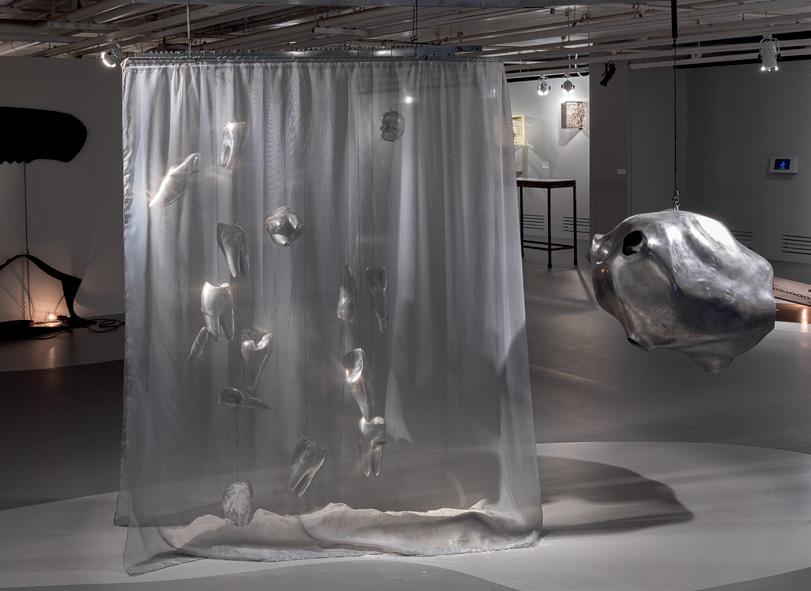
Acervo | collection
Tunga
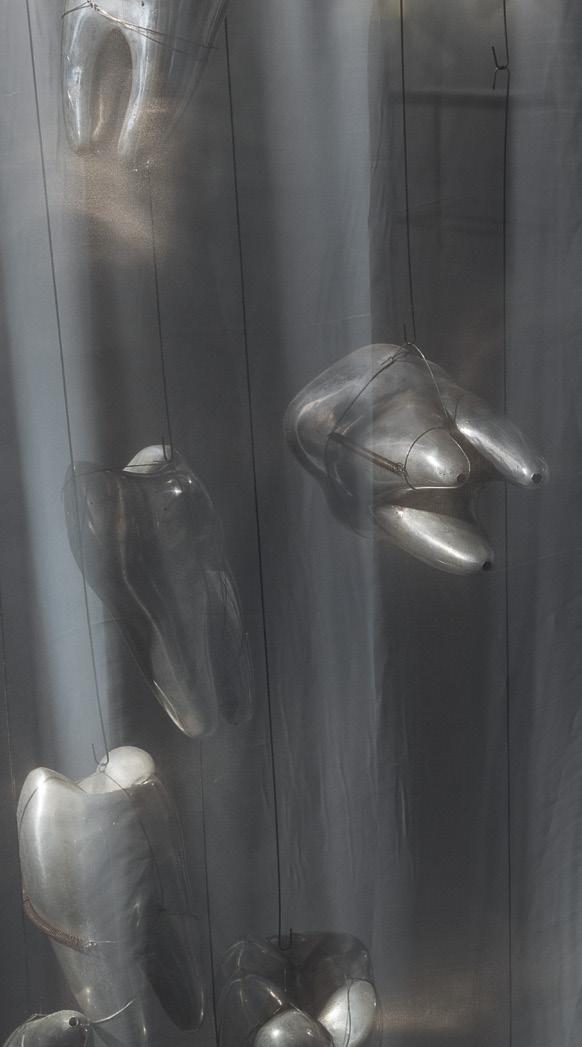
117
117.
Phanógrafo Policromático de Deposição, 2004-2009 água cromatizada, alumínio, cabo de aço, cristal de quartzo citrino, ferro, madeira, matelassê e vidro | chromatized water, aluminum, steel cable, quartz citrine quartz crystal, iron, wood, matelassé, and glass 84,5 x 30 x 38 cm
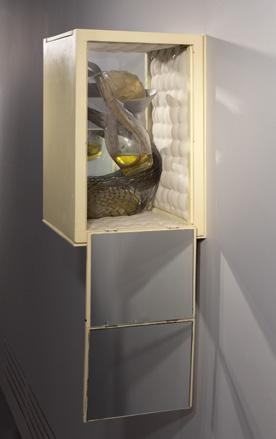
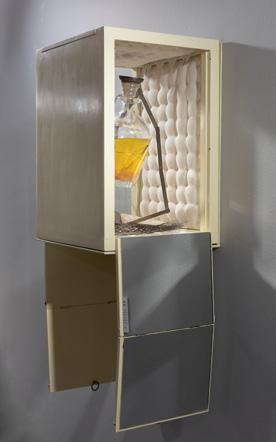
Acervo | collection Instituto Tunga
118.
Phanógrafo Policromático de Deposição, 2004-2009 aço, água cromatizada, borracha, cabo de aço, cristal de quartzo, espelho, ferro, ferro com banho de prata, granito, madeira, matelassê e vidro | steel, chromatized water, rubber, steel cable, quartz crystal, mirror, iron, silverplated iron, granite, wood, matelassé, and glass 84,5 x 30 x 38 cm
Acervo | collection Instituto Tunga
119.
Sem título, da série | Untitled, from the series Estojo, 2012 arame, cristal de quartzo, ferro com pátina prata e pérolas | wire, quartz crystal, iron with silver patina, and pearls 38 x 31,5 x 20 cm Acervo | collection Instituto Tunga
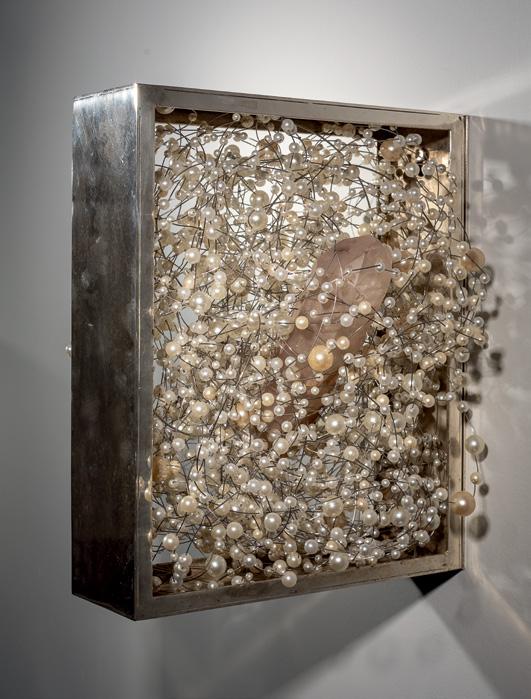
120.
Albinos, 1982 cordão de algodão, feltro de lã e ferro | cotton string, wool felt, and iron 170 x 10 x 250 cm edição P.A. | edition A.P. Acervo | collection Instituto Tunga
121.
Albinos, 1982 chumbo, feltro de lã e ferragem | lead, wool felt, and iron connector dimensões variáveis | variable dimensions (220 x 36 cm) Acervo | collection Galeria Millan
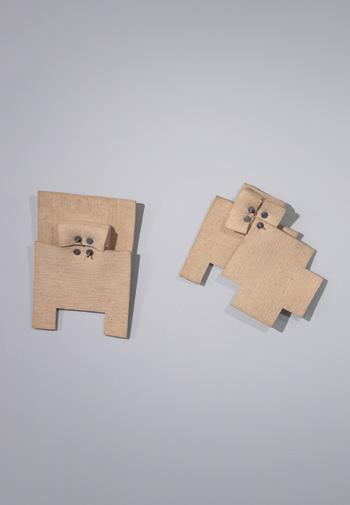
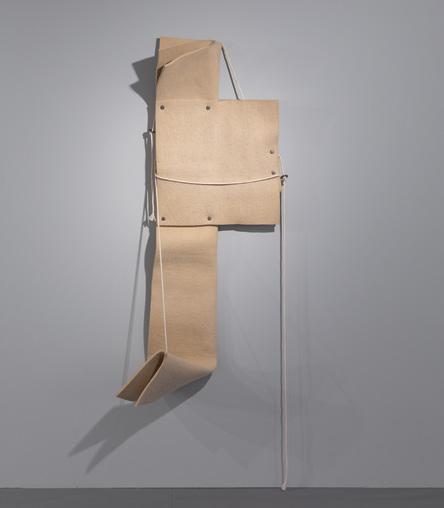
122. Albinos, 1982 cordão de algodão, feltro de lã e ferro | cotton string, wool felt, and iron 170 x 10 x 250 cm edição P.A. | edition A.P. Acervo | collection Instituto Tunga
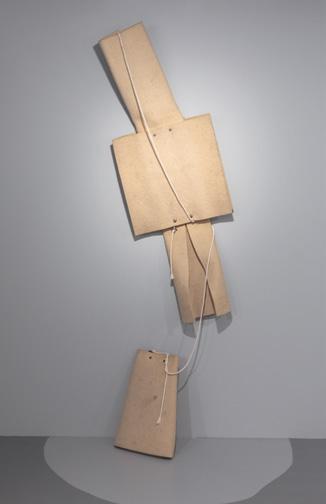
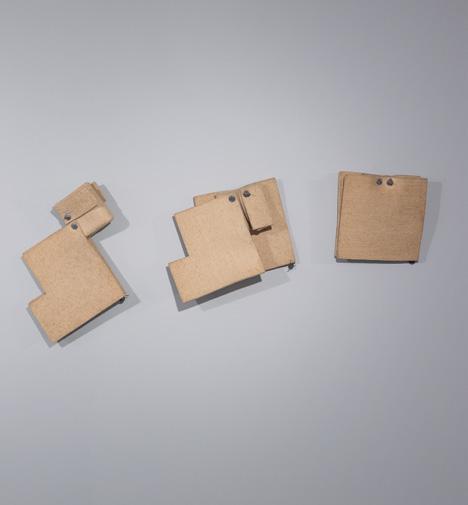
lâmpada
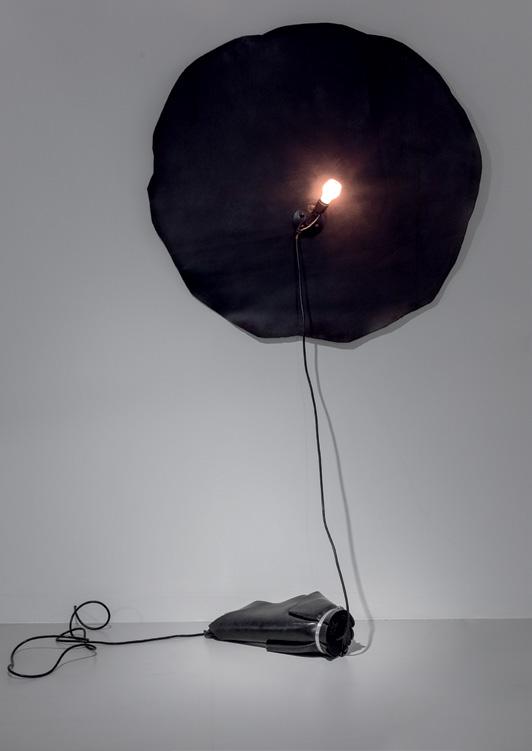
124.
Sem título | Untitled, 2001 vidro, ímãs, aço, ferro, soquete de lâmpada e lâmpada | glass, magnets, steel, iron, lightbulb socket, and lightbulb 60 x 160 x 100 cm Coleção | collection
Luisa Malzoni Strina

125.
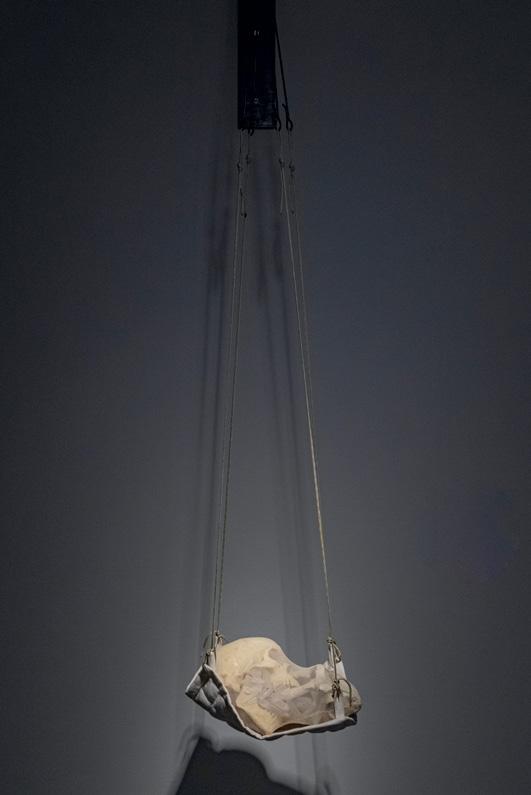
Sem título, da série |
Untitled, from the series Berço de Crânios, 2011 cristal de quartzo, ferro, resina epóxi, silicone, tecido de algodão e tule de lycra | quartz crystal, iron, epoxy resin, silicone, cotton fabric, and Lycra tulle 100 x 32 x 20 cm
Acervo | collection Instituto Tunga
126.
Sem título, da série | Untitled, from the series Estojo, 2008-2011 aço-carbono, ferro, ímã e resina epóxi | carbon steel, iron, magnet, and epoxy resin 164 x 38 x 33,5 cm Acervo | collection Instituto Tunga
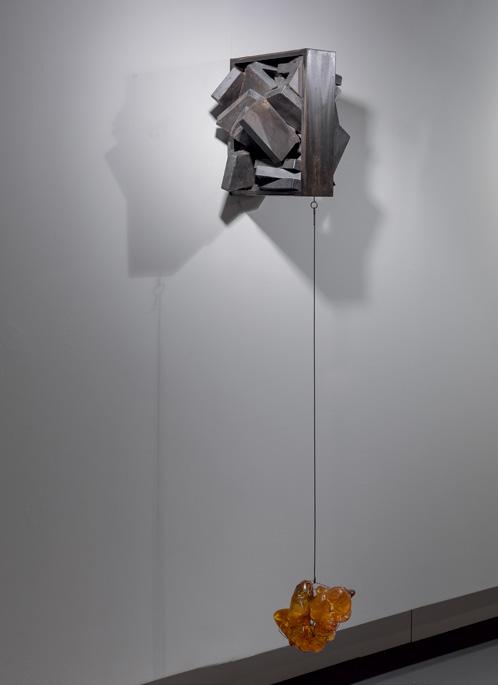
127.
Sem título, da série | Untitled, from the series Estojo, 2012 aço-carbono, cristal de quartzo, ferro, ímã, resina epóxi e silicone | carbon steel, quartz crystal, iron, magnet, epoxy resin, and silicone 38 x 36 x 33,5 cm Acervo | collection Instituto Tunga
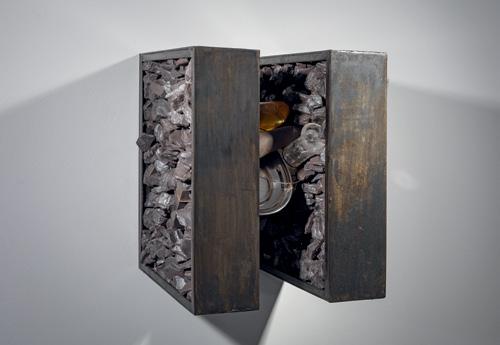
128.
Primeiras Núpcias, 1986-2002 cobre, ferro, folhas de cobre e ímã | copper, iron, copper sheets, and magnet 217 x 56 x 20 cm
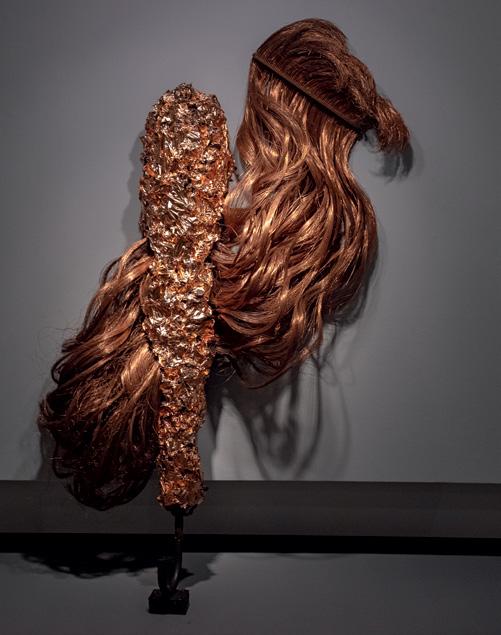
Coleção | collection
Max Perlingeiro
129.
Trança, ca. 1984 fio de cobre e tecido | copper wire and fabric 95 x 26 cm
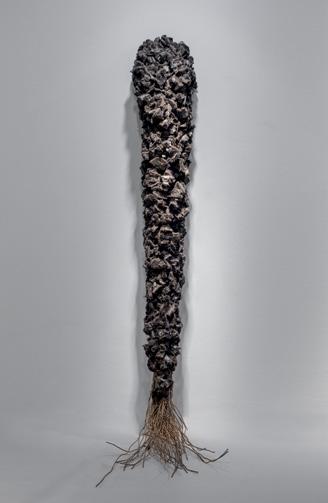
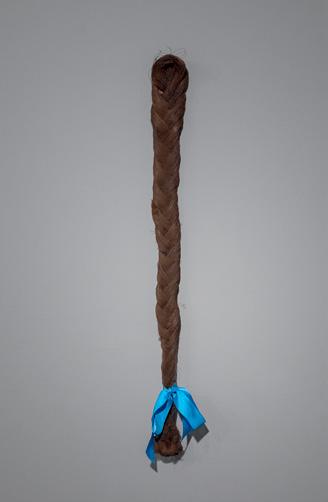
Coleção | collection
Igor Queiroz
130.
TaCaPe, 1986 ferro, ímã e limalha de ferro | iron, magnet, and iron filings 170 x 25 x 15 cm
Coleção particular | private collection
129
130
131.
Lezart, 1989-2012 cobre, ferro, fio de ferro e ímã | copper, iron, iron wire, and magnet 50 x 35 x 75 cm Acervo | collection Instituto Tunga

132.
Lezart, 1989-2012 aço-carbono, cobre, ferro, fio de cobre e ímã | carbon steel, copper, iron, copper wire, and magnet 50 x 35 x 75 cm
Acervo | collection Instituto Tunga
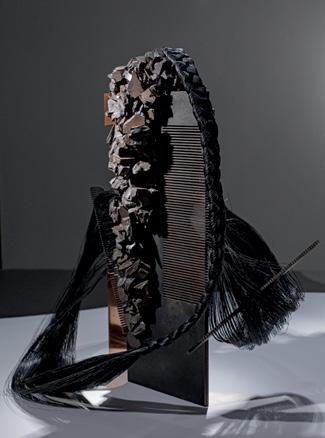
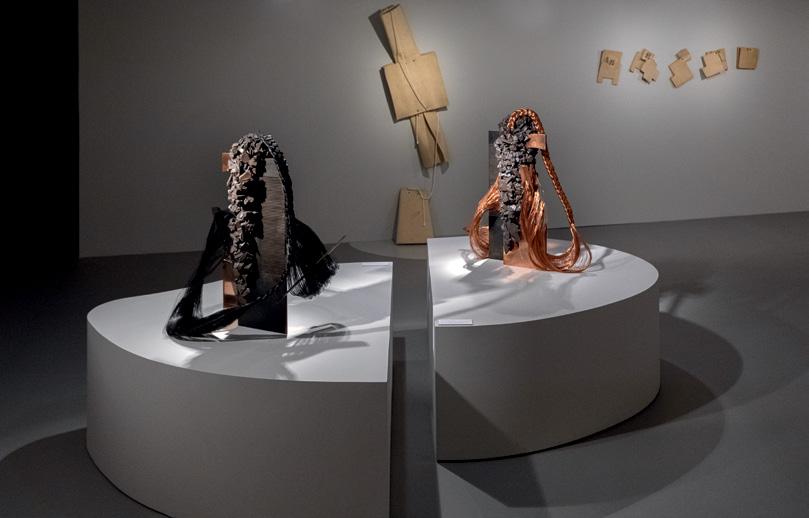
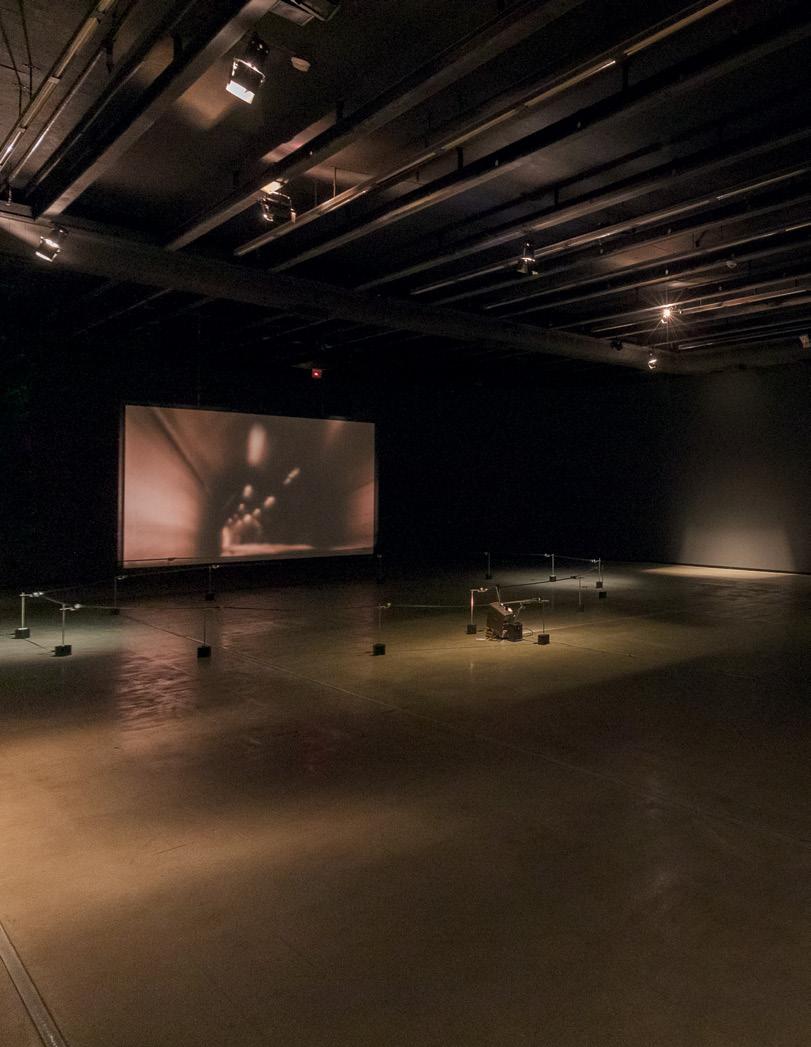
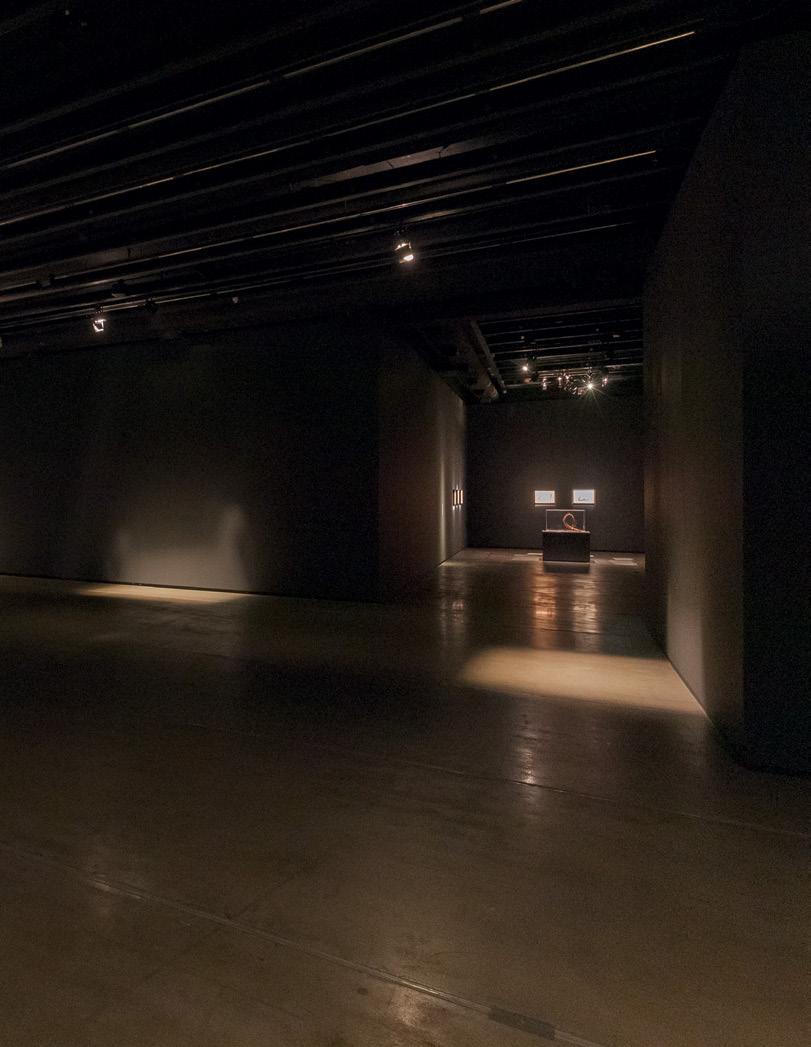
133
133.
Ão, 1981 filme 16 mm e instalação de som | 16 mm film and sound installation Direção de fotografia e câmera | cinematography and camera: Murilo Salles Edição de som | sound editing: Rodolfo Caesar Música: Frank Sinatra cantando “Night and Day”, de Cole Porter | Music: Frank Sinatra singing “Night and Day,” by Cole Porter Acervo | collection Instituto Tunga
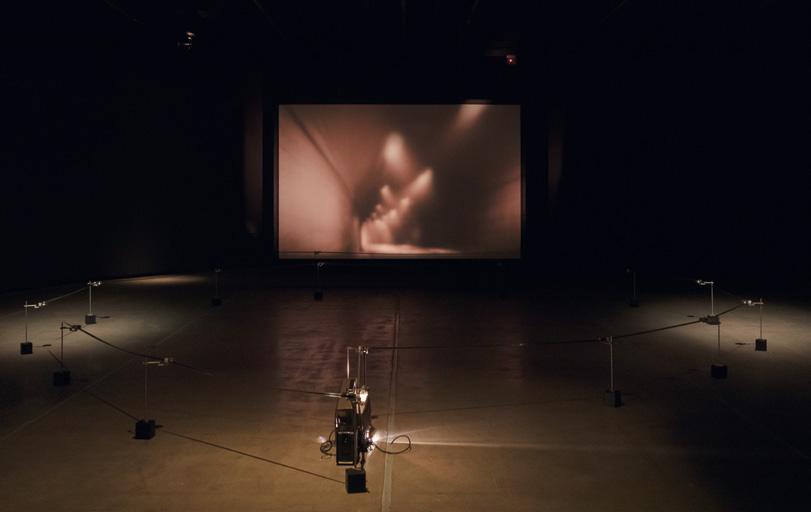
134.
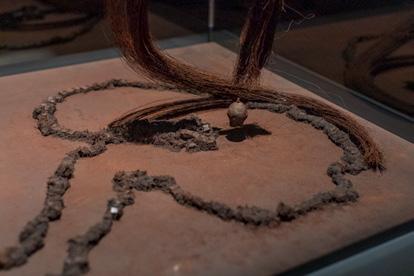
Maquete da obra Gravitação Magnética | mockup of Gravitação Magnética, 1987 fio de ferro, ferro, ímã, limalha de ferro | iron wire, iron, magnet, and iron filings maquete da obra original que participou da 19ªa Bienal de São Paulo | mockup of the original work that participated in the 19th Bienal de São Paulo, 1987 82 x 82 x 45 cm Coleção | collection James Acacio Lisboa
135.
Vista da exposição no Instituto Tomie Ohtake, com a maquete da obra Gravitação Magnética (centro) e desenhos da série de mesmo título | view of the exhibition at Instituto Tomie Ohtake, with the mockup of Gravitação Magnética (center) and drawings from the same series

136.
Gravitação Magnética, 1987 aço-carbono, cabo de aço, ferro, ferro fundido, fio de ferro, ímã, limalha de ferro e madeira | carbon steel, steel cable, iron, cast iron, iron wire, magnet, iron filings, and wood dimensões variáveis | variable dimensions (altura | height 10 m) Acervo | collection Instituto Tunga
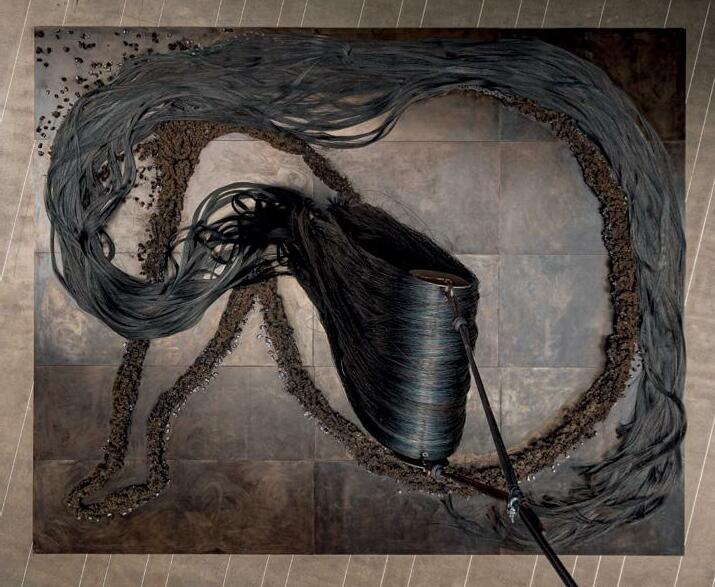
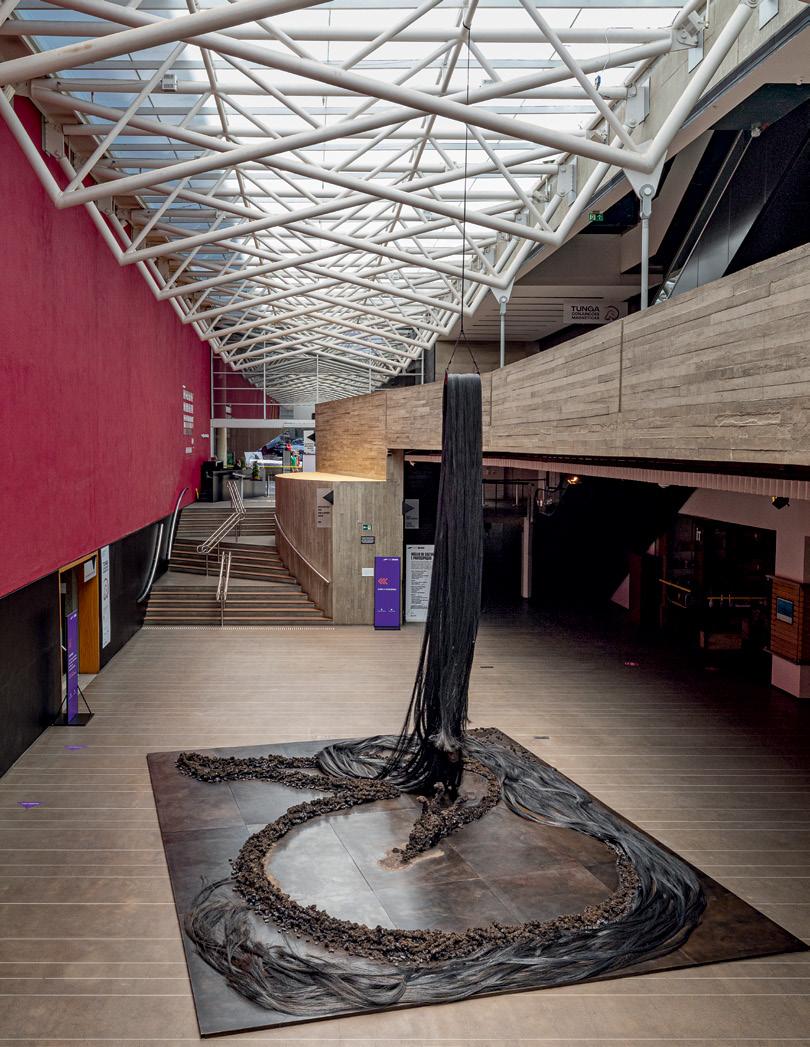
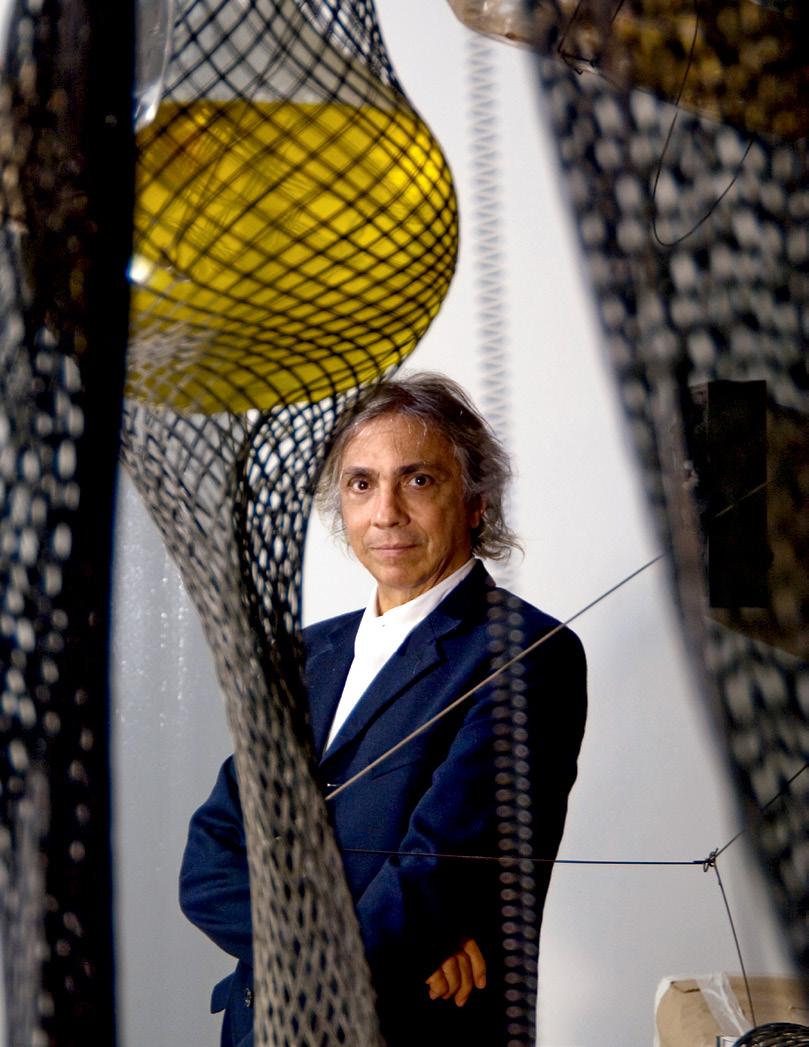
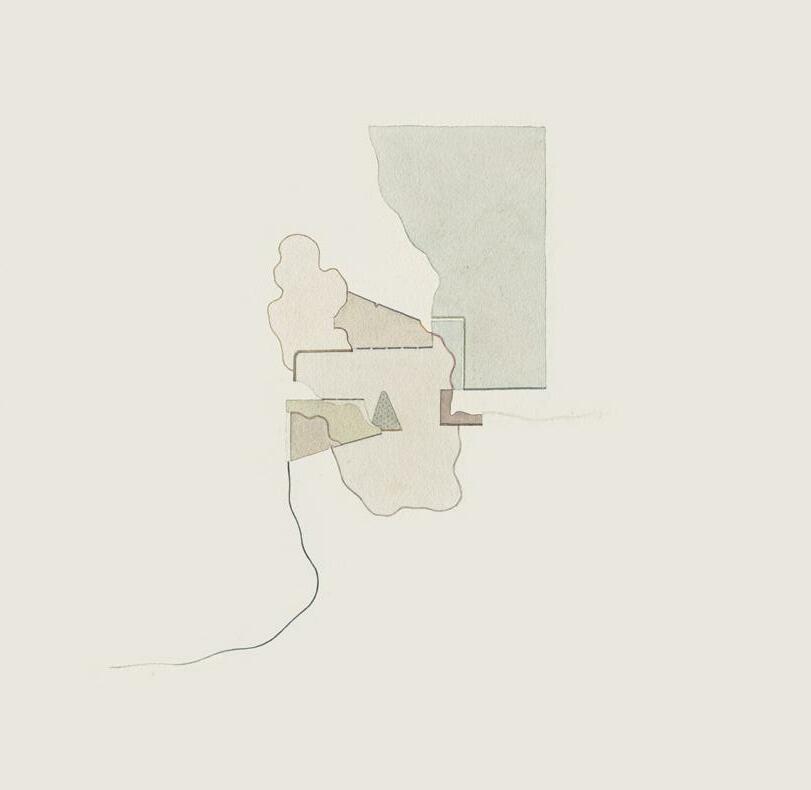
137.
Sem Título, ca 1970, aquarela sobre papel exibida na primeira exposição de Tunga, Museu da Masturbação Infantil, realizada no Museu de Arte Moderna do Rio de Janeiro (MAM Rio), em 1974. | Untitled, ca 1970, watercolor on paper shown at Tunga’s first exhibition, Museu da Masturbação Infantil, held at the Museu de Arte Moderna of Rio de Janeiro (MAM Rio), in 1974. Acervo | collection Instituto Tunga.
Foto | photo: Gabi Carrera
Antônio José de Barros Carvalho e Mello Mourão, Tunga, filho do escritor Gerardo de Mello Mourão e de Léa Barros Carvalho, nasce em 8 de fevereiro de 1952 no Rio de Janeiro, embora tenha sido registrado em Palmares, no estado de Pernambuco.
Em 1969 inicia a graduação na Faculdade de Arquitetura e Urbanismo da Universidade Santa Úrsula, no Rio de Janeiro, e, ao longo da década de 1970 , colabora na revista Malasartes e no jornal independente A parte do fogo , ambos de curta duração. Em 1972 expõe com o artista Eduardo Sued na casa de Marília Valls, no Rio de Janeiro, e em 1974 conclui o curso de arquitetura e urbanismo. No mesmo ano ocorre sua primeira exposição individual, Museu da Masturbação Infantil , no Museu de Arte Moderna do Rio de Janeiro (MAM Rio).

138.
Capa do catálogo da segunda exposição realizada por Tunga, Ar do Corpo, em 1975. | Cover of the catalog of the second exhibition held by Tunga, Ar do Corpo, in 1975.
Foto | photo: Rafael Adorján/ Itaú Cultural
Também no MAM Rio, realiza, em 1975 , a exposição Ar do Corpo . Em 1976 expõe a obra Piscina (1975) na Galeria Luisa Strina, em São Paulo, e viaja para Paris, onde reside por dois anos. Em 1977 publica o livro O Mar a Pele , com texto de Ronaldo Brito, fotos de Arthur Omar e projeto gráfico de Paulo Venancio Filho. Em 1979 realiza uma individual no Centro Cultural Candido Mendes, no Rio de Janeiro, da qual faz parte a instalação Pálpebras (1979).
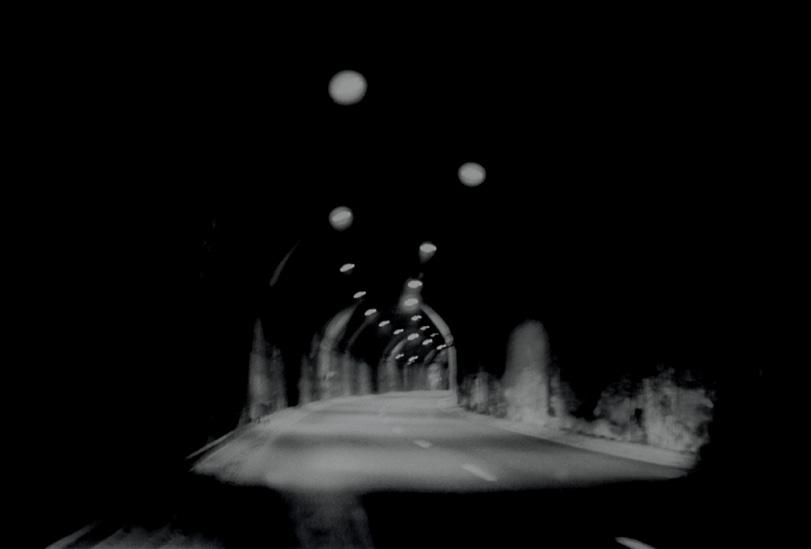
1981
139. Frame da obra Ão (1981). | Still frame from the film-installation Ão (1981).
Foto | photo: Murilo Salles Acervo | collection Instituto Tunga
Em 1980 realiza a exposição Tunga , no Pavilhão Victor Brecheret do Espaço ABC, no Rio de Janeiro, da qual faz parte São João Batista (1977). No ano seguinte apresenta o filme-instalação Ão (1981) na Galeria Candido Mendes, no Rio de Janeiro.
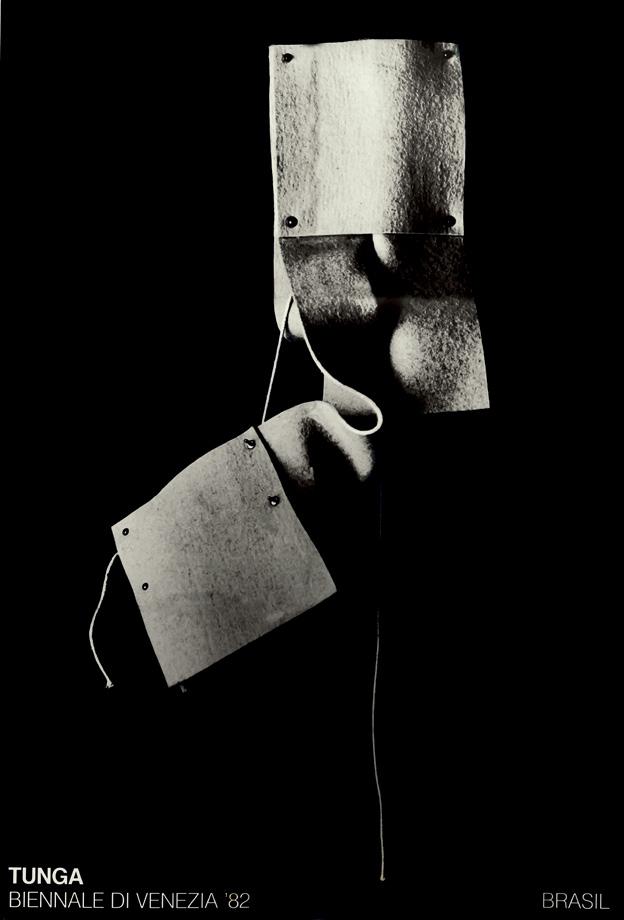
140.
Cartaz da 41a bienal de Veneza, da qual Tunga participou com a série Albinos (1981). | Poster of the 41st Venice Biennale, in which Tunga participated with the series Albinos (1981).
Foto | photo: Romulo Fialdini
Design: Sula Danowski Acervo | collection Instituto Tunga Reprodução | reproduction: Rafael Adorján / Itaú Cultural
Em 1982 participa da 41 a bienal de Veneza , com a série Albinos (1981), e em 1983 realiza conferências no Instituto de Filosofia da Universidade Federal do Rio de Janeiro (UFRJ), na Faculdade de Arquitetura e Urbanismo da Universidade Santa Úrsula e na Universidade Candido Mendes. No mesmo ano, integra a mostra coletiva 3000 metros cúbicos , no Espaço Cultural Sérgio Porto, no Rio de Janeiro, e realiza a exposição As Joias de Madame de Sade , no Gabinete de Arte Raquel Arnaud Babenco, em São Paulo, da qual faz parte Toro (1980). Em 1984 acontece sua individual na GB Arte, no Rio de Janeiro, com Trança (1981). Participa do Festival de utopia , no Centro Cultural Alceu Amoroso Lima, em Petrópolis (RJ), onde apresenta a performance Xifópagas Capilares entre Nós (1984).
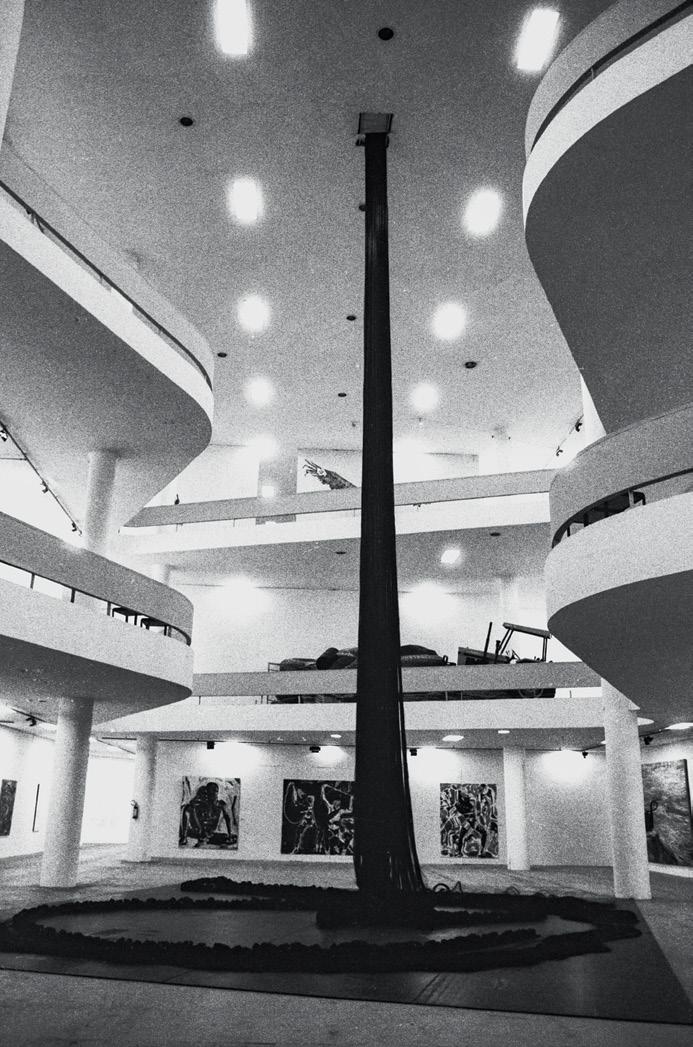
141. Vista da obra Gravitação Magnética na 19ªa bienal de São Paulo, 1987. | View of the work Gravitação Magnética at the 19th Bienal de São Paulo, 1987.
Foto | photo: Adriano Rosa
Em 1985 realiza uma individual no Gabinete de Arte Raquel Arnaud Babenco, em São Paulo, expondo Escalpe, Troféu , Pente (1984), e publica o panfleto “Xifópagas Capilares entre Nós” na Revirão – revista da prática freudiana (Rio de Janeiro). Além disso, recebe o Prêmio Museo de Arte Moderno de Caracas.
Em 1986 realiza a exposição Tunga: Esculturas, na Galeria Saramenha, no Rio de Janeiro, da qual fazem parte TaCaPe (1986) e Bordas (1983). Recebe os prêmios Governo do Estado e Trienal Latino-Americana. Em 1987 participa da 19a bienal internacional de São Paulo, com a obra Gravitação Magnética (1987) e a performance Semeando Sereias (1987). Produz, no mesmo ano, o filme O Nervo de Prata, em parceria com Arthur Omar.
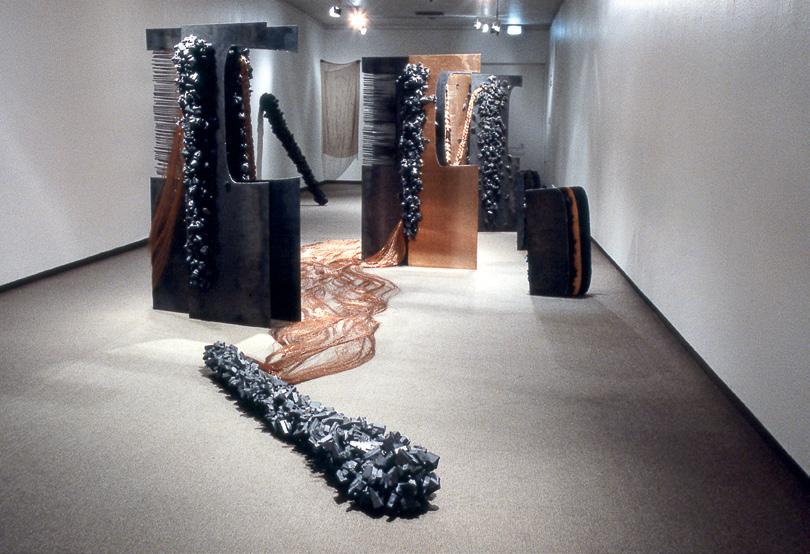
142. Lezart, 1989 dimensão variável | variable dimension Vista da instalação Option 37: Tunga, no Museum of Contemporary Art Chicago | View of the installation Option 37: Tunga, at the Museum of Contemporary Art Chicago Foto | photo: James Prinz, ©MCA Chicago
Em 1988 integra o 19 o panorama de arte atual brasileira e a exposição Modernidade: arte brasileira do século XX , ambos no Museu de Arte Moderna de São Paulo (MAM/SP). Em 1989 realiza as exposições individuais Option 37: Tunga , no Museu de Arte Contemporânea de Chicago,nos Estados Unidos, e Tunga , na Whitechapel Gallery, em Londres, onde expõe Lezart (1989).
Em 1990 recebe o Prêmio Brasília de Artes Plásticas e, no ano seguinte, apresenta pela primeira vez Palíndromo Incesto (1990), na exposição Viva Brazil Viva, no Kulturhuset, em Estocolmo (Suécia), e na Galeria Millan, em São Paulo. Recebe, com a obra, o Prêmio Mário Pedrosa, concedido pela Associação Brasileira de Críticos de Arte (ABCA).
Em 1992 apresenta Sero te Amavi (1992) na Galeria Saramenha, no Rio de Janeiro, e na Galeria Millan; e Tesouro Besouro (1992), na exposição Arte Amazonas, no MAM Rio.
Em 1993 integra a exposição Time and Tide, na Laing Art Gallery, em Newcastle, na Inglaterra. No ano seguinte expõe Barrocos de Lírio (1994) na 10a bienal de Havana e Cadentes Lácteos (1994) na 20a bienal internacional de São Paulo.
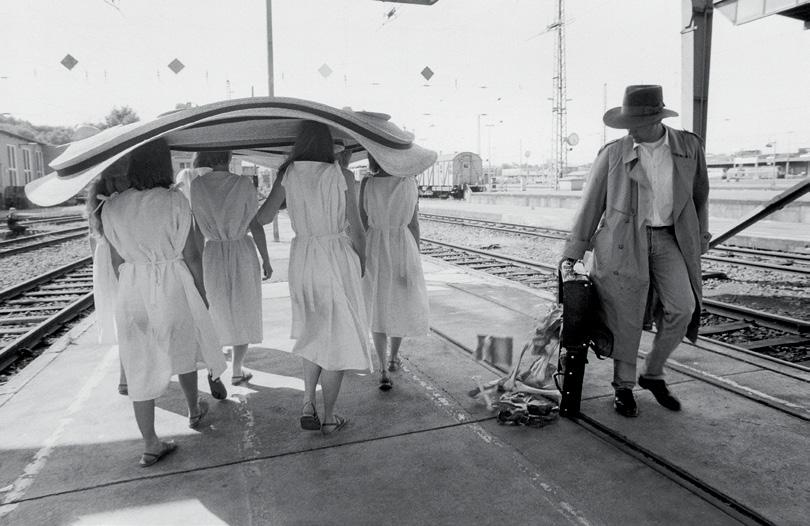
143.
Inside Out, Upside Down, performance realizada na documenta X, na cidade alemã de Kassel, 1997. |
Inside Out, Upside Down, a performance carried out at documenta X, in Kassel, Germany.
Foto | photo: Lucia Helena Zaremba
Em 1995 integra a coletiva Avant-garde walk a Venezia, na Itália, com a performance Debaixo do Meu Chapéu (1995), e em 1996 a coletiva Walk on the SoHo Side, em Nova York, com a performance Experiência de Fina Física Sutil (1996). Participa, no mesmo ano, da exposição Transparências, no MAM Rio, realizando a performance Espantos Aspiratórios Ansiosos (1996).
Em 1997 realiza a exposição Tunga: 1977-1997 , no Center for Curatorial Studies, Bard College, em Nova York, onde expõe Vê-Nus (1976). No mesmo ano recebe três prêmios aquisição, concedidos pelo Museu de Arte Contemporânea de Niterói (MAC Niterói), pelo Museu de Arte Moderna da Bahia (MAM/BA) e pelo Museu de Arte Moderna de Recife, além do Prêmio Embratel e do Prêmio de 30 Anos do MAM/SP. Ainda em 1997 apresenta 100 Rede (1997) na Avenida Paulista, no Itaú Cultural e no Ministério da Cultura (MinC), em São Paulo; e realiza, em parceria com Artur Barrio, a exposição Há sopas ( 1997), no Atelier Finep, no Paço Imperial, no Rio de Janeiro. Participa também da documenta X , em Kassel, na Alemanha, com a performance Inside Out, Upside Down (1997), e apresenta Eixos Exógenos (1986) na Galeria Cohn Edelstein, no Rio de Janeiro. Nesse ano, ainda, sua obra é retratada no livro Tunga: barroco de lírios , lançado pela editora Cosac Naify, e no vídeo Tunga: 100 redes e tralhas , de Roberto Moreira, que integra a série de DVDs Encontros , do Itaú Cultural.
Em 1998 apresenta True Rouge (1996) na Luhring Augustine Gallery, em Nova York, e Tereza (1998) no Museu Nacional de Belas Artes (MnBA), no Rio de Janeiro. Recebe o Johnny Walker Prize, do MnBA, e o Prêmio APCA – os Melhores de 1997, da Associação Paulista de Críticos de Arte (APCA).
Em 1999 realiza exposições individuais no Centro Cultural Recoleta, em Buenos Aires, e na Galeria Millan, em São Paulo, onde exibe Lúcido Nigredo (1998).

2005
144. Instauração Resgate na exposição Metro –a metrópole em você, evento de inauguração do CCBB São Paulo, abril a junho de 2001 | the “instauração” Resgate at the exhibition Metro – a metrópole em você, inaugural event of CCBB São Paulo, April to June 2001 Foto | photo: Ricardo Barcellos
Em 2000 expõe Lúcido Nigredo et Son Ombre (1998) na V Bienal de Lyon e é nomeado Chevalier des Arts et des Lettres (Cavaleiro das Artes e das Letras) pelo Ministério da Cultura da França. Em 2001 realiza a exposição Resgate , no Centro Cultural Banco do Brasil (CCBB) em São Paulo, e exibe Tríade Trindade (2001) na Galerie Nationale du Jeu de Paume, em Paris. Apresenta a instauração Pequeno Milagre , na primeira edição da Orlândia , no Rio de Janeiro, em 2001.
Em 2002 realiza a exposição Nociferatu Spectrum em La Chapelle du Centre de la Vieille Charité, em Marselha, na França, e apresenta Make-Up Coincidence (2002) na Luhring Augustine Gallery, em Nova York. No mesmo ano é inaugurada a Galeria True Rouge, no Inhotim, em Minas Gerais. Em 2003 realiza Se Essa Rua Fosse Minha (2003) na Grande Orlândia , no Rio de Janeiro, e Egypsiaca e a Fênix (2003) no ateliê do artista, chamado por ele de Pensatorium, também no Rio de Janeiro. Em 2004, nesse mesmo local, expõe Afinidades Eletivas (2001). Apresenta Laminadas Almas (2004) na Galeria Millan, em São Paulo, e produz o filme Quimera , em parceria com Eryk Rocha.
Em 2005 expõe À la Lumière des Deux Mondes (2005), no Museu do Louvre, em Paris, e integra a exposição The Art of Chess , na Gary Tatintsian Gallery, em Moscou, com a obra Olho por Olho (2005).
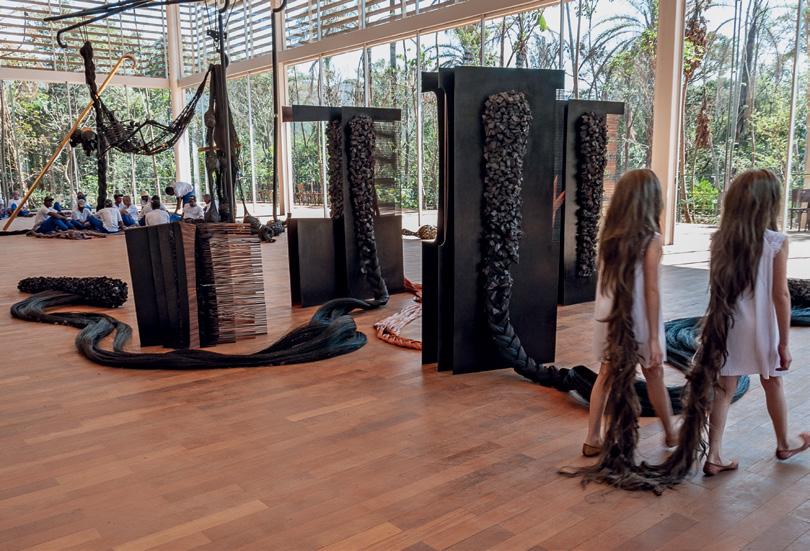
145. Xifópagas Capilares entre Nós (1984) e Lezart (1989) na inauguração da Galeria Psicoativa no Inhotim, em Minas Gerais, em 2012. | Xifópagas Capilares entre Nós (1984) and Lezart (1989) at the inauguration of the Galeria Psicoativa at Inhotim, in the state of Minas Gerais.
Foto | photo:
Lucia Helena Zaremba
Em 2006 apresenta Em Noite Escura (1995-2006) na Galeria de Arte Manoel Macedo, em Belo Horizonte, e Laminadas Almas (2004) no Espaço Tom Jobim, no Rio de Janeiro. Em 2007 é publicada a Caixa de livros Tunga , editada pela Cosac Naify, e ocorre a exposição Tunga, Laminadas Almas – à Luz de Dois Mundos , no Museu de Arte Moderna de Nova York (MoMA). Em 2008 realiza a exposição Dessins Érotiques , na Galerie Daniel Templon, em Paris, e em 2009 apresenta Cooking Crystals (20082010) na III Moscow biennale , no Garage Museum of Contemporary Art, em Moscou. Ainda nesse ano acontece a exposição Quase Auroras: Phanografias , na Galeria Millan, em São Paulo.
Em 2010 realiza a mostra Vers “La Voie Humide” na Galerie Pièce Unique, em Paris, e em 2011 as exposições Magma , na Pilar Corrias Gallery, em Londres, e Presolar, na Galerie Daniel Templon. No ano de 2012 participa da exposição Homenagem a Shelagh Wakely , no Museu do Açude, no Rio de Janeiro, e é inaugurada a Galeria Psicoativa Tunga, no Inhotim.
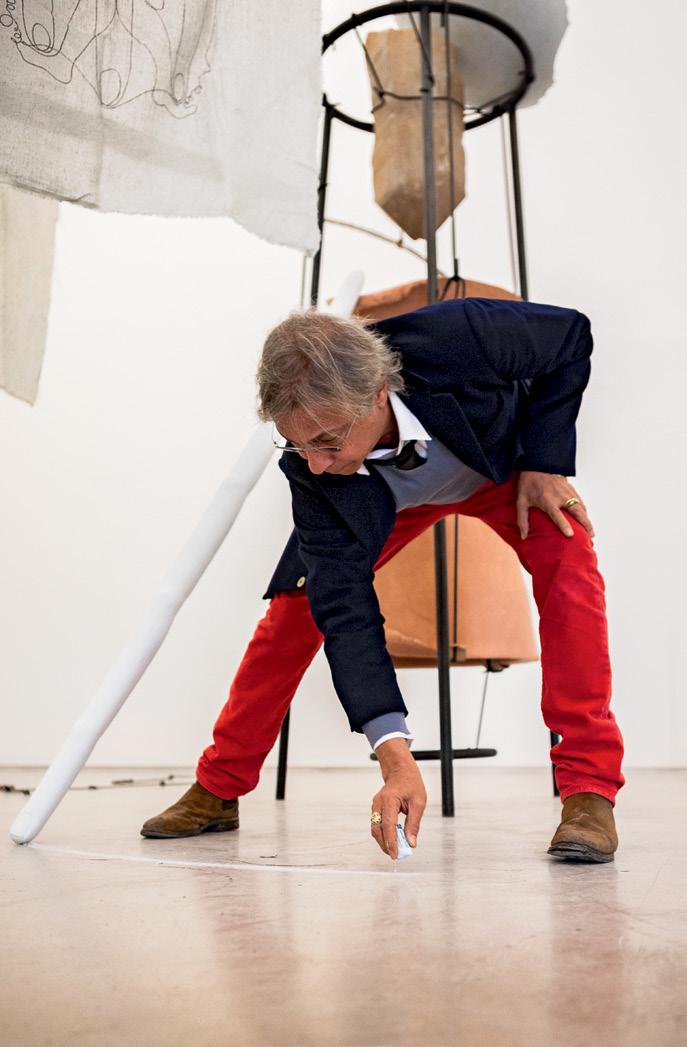
146.
Tunga desenha uma mandala – elemento de uma das obras da série
“From ‘La Voie Humide’”. | Tunga draws a mandala–an element of one of the works from the series
“From ‘La Voie Humide.’”
Foto | photo: Gabi Carrera Acervo | collection Instituto Tunga
Em 2013 apresenta Ão (1981) na feira Art Basel, na Suíça. Em 2014 realiza a exposição “From ‘La Voie Humide’” na Galleria Franco Noero, em Turim, na Itália. No ano seguinte, 2015, acontece a exposição Eu, Você e a Lua, no Centre d’Arts et de Nature, no Domaine de Chaumont-sur-Loire, na França; e apresenta Delivered in Voices (2015), no festival fluminense Novas frequências. Em 2016, no dia 6 de junho, Tunga falece no Rio de Janeiro.
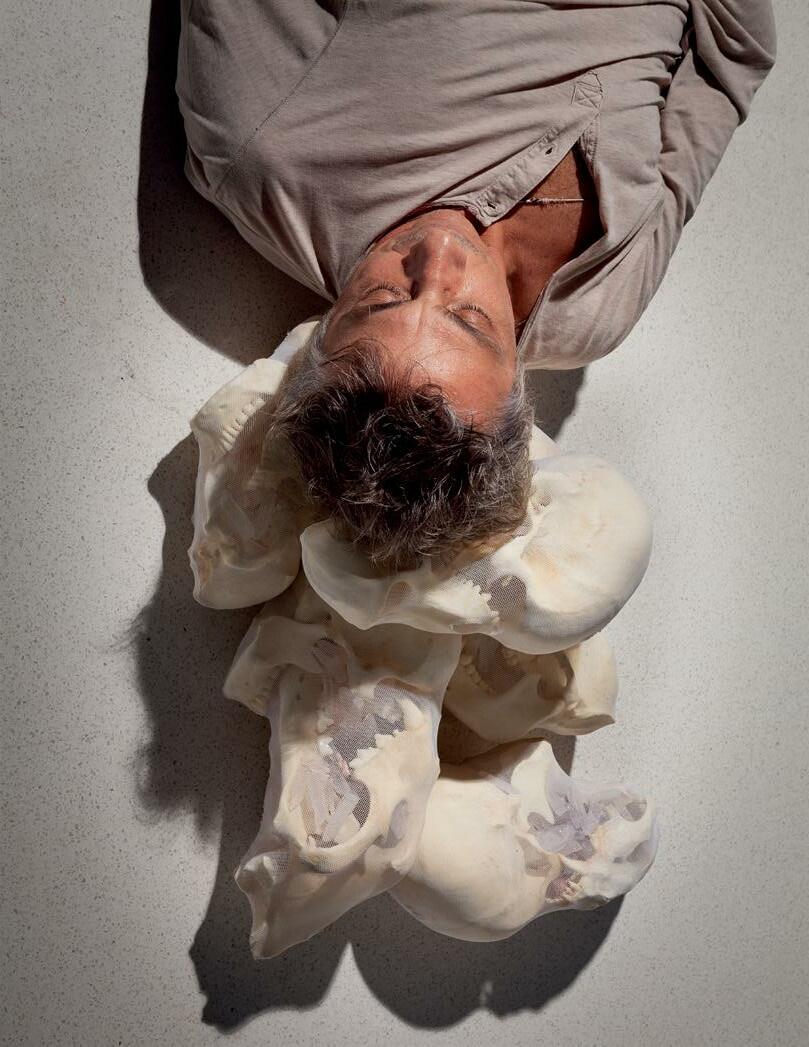
BRETT, Guy. Transcontinental: Nine Latin American Artists. Verso London, em parceria com a Ikon Gallery Birmingham e Cornerhouse Manchester, 1990. Catálogo de exposição.
BRETT, Guy; DAVID, Catherine; VENANCIO FILHO, Paulo; DE ZEGHER, Cathy . Tunga “Lezarts”/Cildo Meireles “Through”. Kortrijk: Kanaal Art Foundation, 1989. Catálogo da exposição realizada na Kanaal Art Foundation, Kortrijk, 20 maio-22 out. 1981.
DAVID, Catherine. “Tunga”. In: DAVID, Catherine. Désordres, 1992. Catálogo da exposição realizada na Galerie Nationale du Jeu de Paume, Paris, 1992.
DUARTE, Luisa; SALLES, Evandro. Tunga – o rigor da distração. São Paulo: Ipsis, 2019. Catálogo da exposição realizada no Museu de Arte do Rio, jun.-nov. 2018
DUARTE, Paulo Sergio. Tunga: pálpebras. São Paulo: Galeria Millan, 2017. Catálogo da exposição realizada na Galeria Millan, São Paulo, 19 out.-12 nov. 2016.
LAMPERT, Catherine. Tunga. São Paulo: Cosac Naify, 2020.
LAMPERT, Catherine; RJEILLE, Isabella; MARTINS, Marta; BRITO, Ronaldo; ROLNIK, Suely. Tunga: o corpo em obras. São Paulo: Masp, 2017. Catálogo de exposição.
MARTINS, Marta. Narrativas ficcionais de Tunga. Rio de Janeiro: Apicuri, 2013.
TUNGA. “Transparência do desejo”. In: Tunga. Rio de Janeiro: Museu de Arte Moderna, 1975. Catálogo de exposição.
TUNGA. Barroco de lírios. São Paulo: Cosac Naify, 1997.
TUNGA. Caixa Tunga. São Paulo: Cosac Naify, 2007. 6 v.
TUNGA. Tunga: Laminated Souls. Berlim: Holzwarth, 2007.
TUNGA. Quase auroras: phanografias. São Paulo: Galeria Millan, 2009. Catálogo da exposição realizada na Galeria Millan, São Paulo, 2009.
TUNGA; AGUILAR, Nelson; BRETT, Guy. Tunga Paris: Galerie Nationale du Jeu de Paume, 2001. Catálogo de exposição.
TUNGA; BASUALDO, Carlos; BRETT, Guy; ROLNIK, Suely. Tunga: 1977-1997. Annandale-on-Hudson, NY: Center for Curatorial Studies, Bard College, 1998. Catálogo de exposição.
TUNGA; BRITO, Ronaldo; VENANCIO FILHO, Paulo; OMAR, Arthur. O mar a pele. 1. ed. Rio de Janeiro: Ed. Pano de Pó, 1977.
TUNGA; DIAS, Magno Machado. Tunga –desenho / Museu da Masturbação Infantil. Rio de Janeiro: Museu de Arte Moderna do Rio de Janeiro, 1974. Catálogo da exposição.
TUNGA; FAINGOLD, Esther. Ethers. São Paulo: Cosac Naify, 2011.
TUNGA; MILLET, Catherine. Dessins érotiques Paris: Galerie Daniel Templon, 2008. Catálogo de exposição.
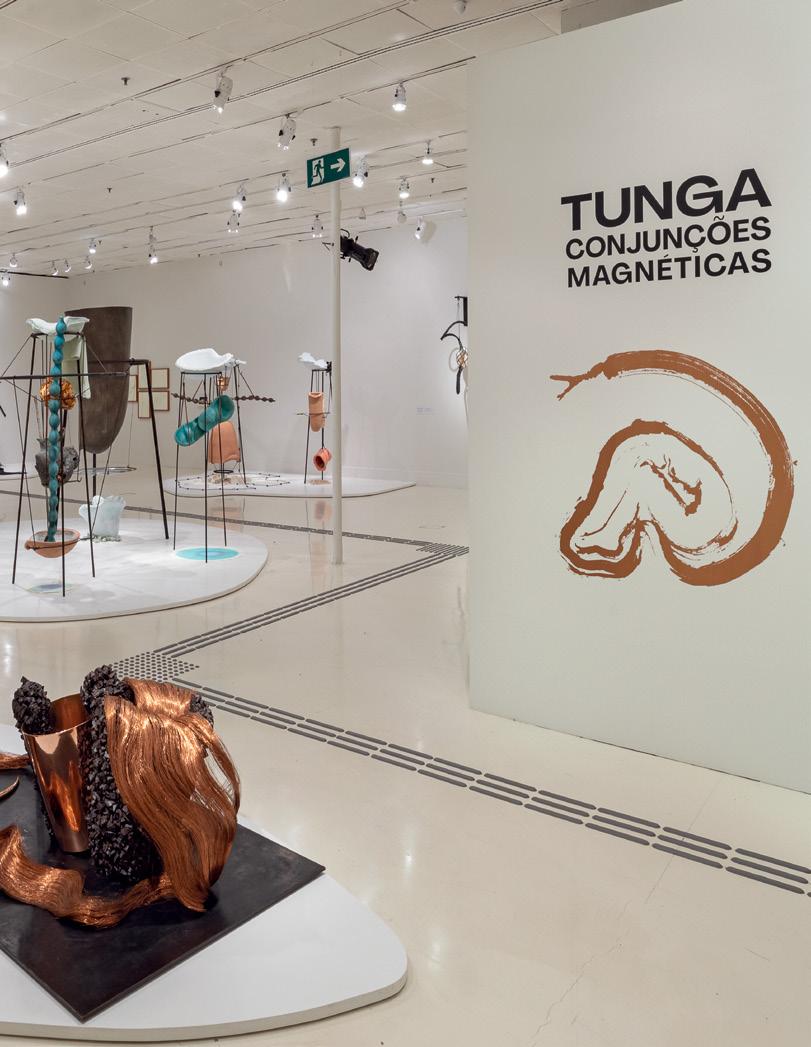
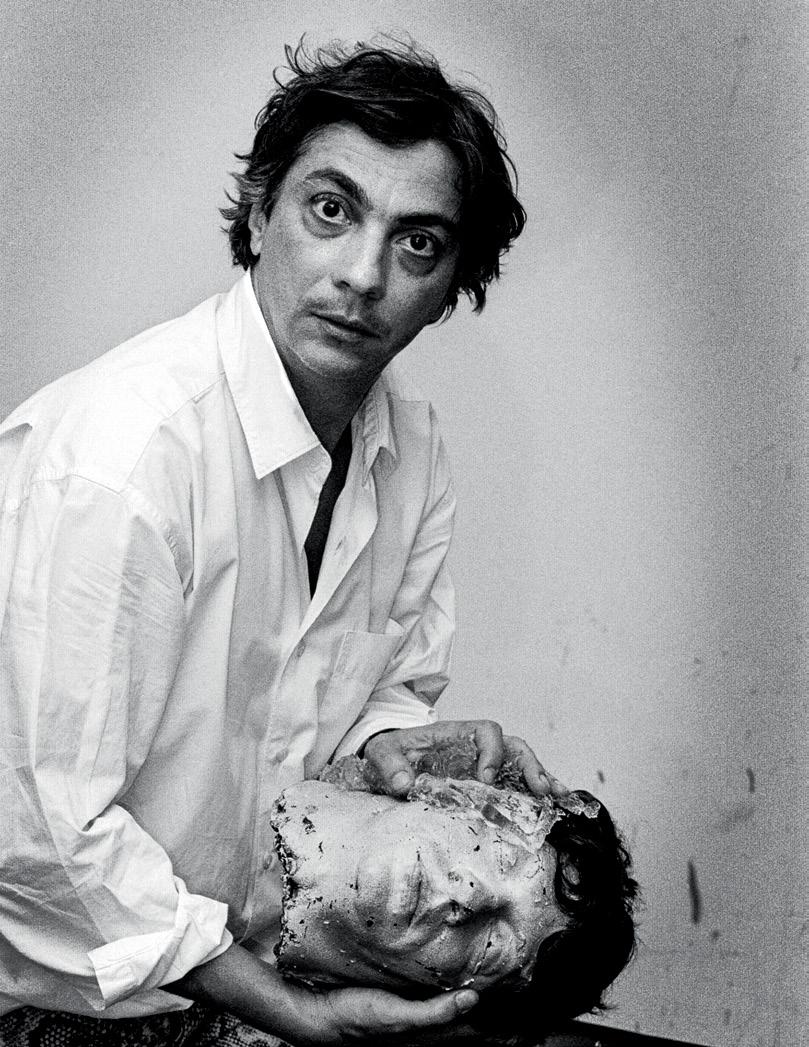
editions of the Bienal de São Paulo, and had his work featured in shows at the Museum of Modern Art (MoMA) in New York, and at Whitechapel Gallery, in London. At Instituto Inhotim, in Minas Gerais, two galleries are focused on his work: Galeria True Rouge (2002) and Galeria Psicoativa (2012). Tunga was the first contemporary artist and the first Brazilian to have his production shown at the Louvre Museum, in Paris—with the work À la Lumière des Deux Mondes (2005).
With a unique imaginative universe and refined production, Antônio José de Barros Carvalho e Mello Mourão (1952–2016), better known as Tunga, is a key figure in Brazilian visual arts. To celebrate his oeuvre, Itaú Cultural (IC), in partnership with Instituto Tunga and Instituto Tomie Ohtake, held the retrospective exhibition Tunga: magnetic conjunctions
Tunga received his BA in architecture and urbanism in 1974, the same year that he held his first solo show, at the Museu de Arte Moderna of Rio de Janeiro (MAM Rio). At the effervescent end of the 1970s, he rubbed shoulders and dialogued intensely with great names in the contemporary arts, such as José Resende, Waltercio Caldas, Cildo Meireles, Sergio Camargo, and Lygia Clark—the latter three of whom have also been the theme of exhibitions at IC.
Drawings, sculptures, objects, installations, videos, and performances. The wide variety of supports reveals Tunga’s multiple inter ests, which spanned a diverse range of areas of knowledge, from literature and mathe matics to art and philosophy. Plurality is also present in his use of materials; Tunga very notably explored magnets, glass, felt, rubber, teeth, and bones. His work gained symbol ism and presence, thrusting his production onto the international art stage.
Beginning in the 1980s, the artist partic ipated in the Venice Biennale and in four
Part of this extensive production can be seen in Tunga: magnetic conjunctions Besides the IC, the show is extending to Instituto Tomie Ohtake, which is presenting the sculpture Gravitação Magnética (1987)— whose sketches are on display in both cultural spaces—and the film-installation Ão (1981).
This catalog presents the works in the exhibition as well as a text that introduces the show, written by the director of Instituto Tunga, Antônio Mourão, together with the show’s curator, Paulo Venancio Filho, the latter of whom also contributed an essay that proposes a deep reflection on the art ist’s works. IC and Banco Itaú are supporting the project for a catalog raisonné, which is being edited by Instituto Tunga and is slated for release in 2024.
Since 2010, IC has held solo shows that revisit the work of artists fundamental to Brazilian visual art. This content is expanded on the website itaucultural.org.br and in the Enciclopédia Itaú Cultural de Arte e Cultura Brasileira.
See the exclusive contents developed for the exhibition Tunga: magnetic conjunctions

he himself proposed for his “performative installations,” the exhibition Tunga: mag netic conjunctions is itself like a “work” arising as the physical result of all the actions implied by that same concept.
Presenting Tunga’s work in its extension, depth, and integrity was what oriented the production of the show Tunga: magnetic conjunctions. Featuring more than three hundred works, many of them never before seen, the exhibition is a retrospective on the relationships and developments that metamorphosed since the 1970s—his first solo show was in 1974, at the Museu de Arte Moderna of Rio de Janeiro (MAM Rio)—up to a few minutes before his death, in 2016.
Besides drawing, the artistic restlessness of Antônio José de Barros Carvalho e Mello Mourão (1952–2016) led him to other practices: sculptures, objects, installations, videos, and performances. This set of works reveals the scope of his multiple interests, which freely transited through diverse areas of knowledge, including art, literature, science, and philosophy. A large part of the artist’s work is currently conserved by Instituto Tunga, which is responsible for maintaining, disseminating, and safeguard ing his legacy.
The exhibition space presents a broad overview of the most significant moments of the artist’s career, without any sort of hierarchy or chronology, in keeping with the artist’s continuously circular thought, always enlarging more and more. By presenting the breadth of his work in consonance with his artistic poetics, inspired by the concept of instauração that
Tunga was outstanding among con temporary artists for his wide-ranging exploration of media and materials such as magnets, glass, felt, rubber, teeth, and bones, imbuing them with poetic uncan niness. Through his peculiar metamorphic practice, he proposed dissimilar, heter ogeneous, and heterodox artistic-poetic experiences. His many instances of instau ração , his installations, sculptures, and objects seek to explore the symbolic and physical appeal of the materials as well as their artistic and poetic artic ulations, and they went hand in hand with his intensive obsession for drawing. Tunga never engaged in drawing as a mere scheme or plan; rather, every drawing is a realization in itself, indissociable and fundamental to the production and under standing of his work as a whole. Therefore, the practice of drawing as a sort of reason ing and realization is present throughout the show in its relationship with the three-dimensional works.
Tunga: magnetic conjunctions empha sizes the metabolic interaction between media and materials that arose over nearly half a century, in a constant dynamic of continuous mutation, a fundamental characteristic of Tunga. And it covers this extension in a set of works that span from the outset to the end of his career and vice versa, in an oeuvre that looked incisively at itself at each and every moment.
All of Tunga’s work is developed around the nude body. Reversible, the body is, simultaneously, the generator and the generated. It is a doubleness that is multiplied, it attracts everything to it and repositions it on a more elevated, refined, magnified plane. Drawings, objects, installations, sculptures, instaurações * are the diverse results of this process—the drawing in first place.
Drawings mark the beginning of his work; countless, they are the result of a constant, intense, and obsessive prac tice, which has constantly advanced to determine his entire oeuvre from begin ning to end. His first exhibition—only of drawings—took place in 1974, at the Museu de Arte Moderna of Rio de Janeiro (MAM Rio), with the edgy title Museu da Masturbação Infantil [Museum of Infantile Masturbation]. There, one clearly per ceived a draftsman in action and a voca tion. The drawings—which had nothing childish or childlike about them, nor much less, any possible naïveté—evinced, above all, the expression of a loose, uninhib ited libidinal energy. This was likewise indicated in the exhibition’s suggestive title—audacious, instigating, and intrigu ing, for a show of abstract drawings so intimate, which nearly appeared more like unfinished sketches than actual draw ings. Some were very small, tending more toward being invisible than being seen, as though obliging us to come closer with a
magnifying glass to see their fragile and delicate appearance, only immersed and diluted on the paper, springing from a still-nameless flow, the first emanations of a vital, overflowing energy. The figures are very intriguing, and recall, by affinity, La mariée from the erotic scene of Le grand verre , or La mariée mise à nu par ses célibat aires, même, 1 by Marcel Duchamp (1887–1968), much admired by Tunga. And that is what attracted him, the “other” Duchamp, the one with an erotic, nonliteral imagérie , suggested by figures without any common place sensual appeal— cosa mentale , one could say. Therefore, they are drawings already informed by a distinct heterodox visual genealogy. In that same exhibition, another gestural rhythm set apart a series of strikingly energetic drawings, in which the black of the India ink predominated in ejaculatory traces of a swift move ment, giving vent to the liquid and its free expansion on the paper. While these drawings are abstract, they are above all pulsations that encounter their ultimate expression in the affirmation of the ges tural discharge that runs from beginning to end, without additions or corrections, in every detail. Figures that are still name less, even though they are shown with titles, which are also intriguing: O Perverso [Perverse], Pensamentos [Thoughts], Máquinas [Machines], Charles Fourier , and Paisagens do Desejo [Landscapes of Desire]. They include this extravagantly anachronistic one that refers to Charles Fourier (1772–1887), the utopian socialist of 18th-century erotic societies. A name which, like others, already indicated the entanglement that Tunga’s work would always maintain with radical aspects of French culture, whether in visual arts, literature, or philosophy. Fourier appears as the name of a series of imminently contemporary drawings and, at that begin ning, indicated an elective affinity that would be combined with other campaigns throughout his career.
*The highlighted words throughout the text are part of a glossary that aggregates references, terms, and expressions typical of the artist. Check pages 187 through 192.
Note 1. Le grand verre, or La mariée mise à nu par ses celibataires, même [The Large Glass, or the Bride Stripped Bare by Her Bachelors, Even], a painting on glass by Marcel Duchamp, is divided into two parts. In the upper part, we see the “Bride,” and, in the lower part, the “Celibate Machine,” which includes the “Malic Molds,” who cannot come into direct contact with the “Bride.” The scene is concentrated on the erotic tribulations between the “Bride” and the “Malic Molds” and represents the Duchampian visual summa that extends through a complex and extensive narrative.
Fourier was just one of those who were brought into Tunga’s work, therefore acting as a harbinger for what would be ceaselessly expanded, making increasingly audacious and imaginative associations, bringing together things that were distant in time and space. The defined vocation— draftsman, first of all, throughout his career—positioned Tunga in the generation of artists who emerged in the 1970s, when drawing predominated, and who attained a degree of artistic importance in Brazil. In that generation, however, he occupies an extremely singular position. His first draw ings give the impression of being anachro nistic, perhaps deliberately displaced from his time and his generation. The delicate gesturality, whether slow or quick, uses color sparingly and characterizes these small images as subtly expressive. The black of the homogeneous, malleable, and visually heavy India ink seemed to anticipate the sculptural material that was to come.
The precise indefinition led to the formless or the deformed improvised gesture, sometimes close to, other times further away from an unlikely figure—somewhere between blotch and figure—oppositions that would recur throughout his oeuvre. In this reduced dimension of his abstrac tion, an influence is discernible from Henri Michaux (1899–1984), a great poet and hard-to-label artist, whose bestknown drawings were made under the effects of mescaline; from André Masson (1896–1987), a heterodox surrealist linked to another artist also at the fringe and an eventual dissident of the movement, the writer Georges Bataille (1897–1962), who Tunga often read, and admired in his younger years; from Roberto Magalhães (1940), who revitalized drawing in the late 1960s; and, last but not least, by the occasional draftsman Duchamp. He would later collect works by these artists, in recognition of his admiration for them and his youthful debt to them.
These names reflect the choice and the value that he gave to a certain artistic flank; choosing artists from outside the center of influence of those years, which is a mark of Tunga’s admiration, as he felt a proximity to those who attracted him by their strangeness and by their affinity with his visual world. In those choices—unlikely and very special combinations—some influences informed the young artist’s background when he was still a teenager. In those years, the 1970s, there was a transition and overlap between pop art and conceptual art, in which, strangely or deliberately, he did not participate. His transversal and idio syncratic link with the fringes of surrealism structured the poetics that would charac terize his work from then on.
It was not Duchamp’s conceptual works, so highly evident in contemporary art, which attracted him, but rather those that con stitute the Duchampian “mythology.” His surrealist inclination was also manifested in a series of drawings clearly inspired by André Masson, with his Massacres series. That series configured the scene that corresponded to his obsessions: the erotic compulsion and the presence of death, the latter as the final stage of the former—a scene that would recur in different ways in other works. The figure hanging at the gallows appeared alone and was camou flaged, indistinct from its surroundings; as invisible as the purloined letter in the tale by Edgar Allan Poe (1809–1849). A later work, Pintura Sedativa (1984), would exem plify the method that was then begun; the metabolic interplay between the material and the title; in that work, the adjective sedativa [sedative] takes on another sense [this one, a neologism], referring to the material seda [silk], on which this work was necessarily painted. Thus, the pair seda/ sedativa would aptly summarize the poetic transposition of material into a mental state—whoever looks at the seda is sedado [sedated] by it. The sedation is “glued”
onto the silk and, by extension, it leads to sleep and dreaming.
He was not (or scarcely) interested in Duchamp’s very influential readymade phase, but rather in his smaller works. He was attracted to those lesser-known works, the first “surrealist” objects and which most likely suggested the transition to the tridimensionality of the works presented in his second solo show, Ar do Corpo (at MAM Rio), in which the title of one of them, Objeto do Conhecimento Infantil [Object of Childhood Knowledge] (1974), could have served for all the others. In that exhibi tion, we are a step beyond the unconscious flows of the first one, at the stage subse quent to the apprehension of the objects’ tridimensionality, which would later lead him to sculpture. Now the action is tactile, having to do with the discovery of the object (of the desire); from the drawings to these uncommon and perverse “toys”—as suggested by the title of one of them, Eros e o Pensamento Positivo [Eros and Positive Thinking] (1974)—we are a step above and outside the infantile visual imagination. Objects that are quite eccentric, enigmatic, full of possible revealing discoveries of the world of polymorphic eroticism which, from that point onward, would be mani fested in the choice and use of materials: initially felt and lead, both with a decisive importance throughout his oeuvre.
An ambitious yearning was already apparent in those smaller works; an intimate grandi osity which, at some later moments, would reach the point of sumptuousness—the large and the small are indistinct homothetic var iations in Tunga’s work. The careful selec tion of the materials, whether in their raw or refined states, coupled with the polished and meticulous execution, clearly evinces a deliberate program to imbue the work with authority, material relevance, and the aim to restore a certain magnificence to contempo rary art. This explains the artist’s refusal of
the banality and conceptual unilateralness that often characterize the readymade; and, on the other hand, the search for a mythol ogy and greatness akin to Le grand verre; the same vast and intricate narrative that would link one work to the next, adding to each of them a new and enlarged version.
Sade, Fourier, Rimbaud, Baudelaire, Lautréamont: the list of names from the literature of France and other countries resembles the artist’s spirit—as though he were, based on them, a revitalizer and transformer of those radical, intimate, and precisely chosen poetics. It is a singular case more of intoxication than of inspira tion; delirious but conscious, rigorously operative, and calculated. It does not involve mere appropriations, citations, transcriptions; the validity of these names is only justified when they mobilize and penetrate in the work, in its poetic mythology, as a sort of reincarnation of the mystic approach that accounts for this artist’s romantic mastery, like few others in contemporary art.
An example of an affinity is the small mul tiple by Jean Arp2 (1886–1966) acquired at a marché aux puces in Paris in the 1970s, which reveals not just an opportune choice, but a noncircumstantial proximity. With revers ible front and back, the two holes of the eyes of the Masque Oiseaux can be seen as a harbinger of later developments that would complexify the simplicity of that object which is both mask and bird—first one, then the other, and also both of them simultane ously. The implicit reversibility in this smallscale sculpture reinvigorated his preexisting drives toward combining mutually distant realities. Tunga unveiled possibilities that were previously concealed in this mask, and used it as though it were a personal objet trouvé, destined only and exclusively for him. If the diversity of his interests led him into remote, divergent, and incongruent areas—science, philosophy, literature,
Note 2. Jean (Hans) Arp, one of the great abstract artists of the 20th century, an iconoclast, circulated through Dadaism and surrealism. He was one of the first to privilege the participation of chance in his artistic practice, more specifically in his collages. Also a poet, his sculptures represented one of the high points of modern abstraction.
Note 3. “The examples of objects presented here belong to the class of the classic theme of the nude” is the first phrase of “Prática de Claridade sobre o Nu.” The entire text can be found at https:// issuu.com/tungaagnut/ docs/revista_malasarte, in Portuguese.—Ed.
Note 4. In Portuguese vê is the third-person singular verb for “to look” or “to see,” while nus means “nudes.”—Trans.
occultism, religion—all of them were reconducted as sources of energy that were unified and metabolized in his work. This productive, fluent, and unclassifiable erudition expanded and became fixed on each idea at each moment of artistic trans mutation, immersed in the flow from work to work. This refined mastery of interests gave his work its unmistakable air of longelaborated preciosity, destined to endure and remain. Without this specific refine ment, it would have been fake, inconse quential, artificial, insufficient, without the density of the effect it sought to bring about, often even in excess—as is the case of the long, exhaustive, fascinating, and exalting instaurações .
The idea he pursued and to which he always remained linked was already expressed in his text published in issue #3 of the mag azine Malasartes, in 1976, entitled “Prática de Claridade sobre o Nu”:3 to cast new light on a body and explore it in every way until it reappears reinvented; to re-instaurar the body in sculpture—the body is the sculpture and vice versa. Every artwork pursues the obsessive idea of the nude, which is unfolded at each moment, in each work. It is a primor dial erotic scene of Tunga, summarizing the phrase by Georges Bataille: “The decisive action is the denuding.”
His first sculptures already pointed to a practice that was divergent and heterodox, nevertheless close to that of other contem porary artists. He was not, for example, the only one to use felt. Joseph Beuys (1921–1986) and Robert Morris (1931–2018), among other artists, also explored, in different ways, the tactile, flexible, anti-sculptural, and organic nature of that material. Unlike them, Tunga articulated the soft mate rial of the felt to create “hard” geometric schemes, making his first sculptures, the Albinos (1982) (p. 130 | img. 120 to 122), by cutting bodies out of the felt and remount ing them using screws and strings in several
variations. In those sculptures, the opposi tion between the structured geometry of the forms and the flexible material of the felt suggested a possible tension and reaction of the inanimate, which asserted itself as a living thing—a phenomenon similar to Lygia Clark’s (1920–1988) Bichos. It was as though the strings tensioned the geometric purity while the twisted plane suggested a volume fixed in a position in which the “body” took shape. Isn’t it suggestive that the white of the felt recalls the nudes of the classical Greek sculptures? Here Tunga began to engage in a profound link with the material, or the materials; there would be many of them which identify, from then on and at first sight, a work of his.
The Venus that first arose in the prehis tory of Tunga’s work had to be a prehistor ical one: the Venus of Laussel , a Paleolithic statuette discovered in France in 1909, appears in a photograph that is part of a work, today lost, Piscina (1975) published in the magazine Malasartes together with the text “Prática de Claridade sobre o Nu.” Note that this Venus is already the “nude,” one of the first in history. Venus would become Vê-Nus (1976); by separat ing and linking her nudity to the voyeur with a hyphen, 4 Tunga indicates that one does not exist without the other. A similar thing occurs with the Eixos Exógenos . Eixos [axes] x Exógenos [exogenous]—the “x” that is repeated in the two words is like the graphic representation of an axis— there is a proximity between these terms, one is umbilically linked to the other, like the twins in Xifópagas Capilares entre Nós (1984), by an unknown “x,” which fasci nates us without our knowing what it is. Contemporary caryatids—that is what we can call the Exógenos , erect and hier atic bodies generated by the revolution of a woman’s body around an axis; the woman’s body is the “x” that gives body to the axis when it goes away when absence becomes presence. They are, therefore,
negative caryatids; simultaneously clas sical and contemporary. This volubility in the perceptual experience of the work leads the body to ceaseless adventures of the form; here, the form should be under stood only as a stage, a moment of passage that becomes present in one or another work. The form is a fluid between mental and material, imagined and materialized, and is therefore indistinct, one: the “sub stance” of the poetics. At one moment, it is the embodiment of a planar experience, as in the Albinos ; at another, the body is materialized as a “void” and carries out an occupation that is also a “deoccupation of space,” to use a sculptural concept by Jorge de Oteiza 5 (1908–2003).
Peculiar fixations would establish a family of fetishes in Tunga’s work; hair, for example, is one of the most notable ones. By turning it into a sculptural material (which to a certain degree it already potentially is), the work interlaces, as always, body and sculpture. Therefore, the xiphopagi can only be united by their hair, the individual follicles being the con ductors of energia de conjunção (energy of conjunction) which envelops them in a lyrical, musical, enchanting atmos phere like the same melody repeated over and over. It is an ode to puberty, as one supposes that only at this age does hair manifest its pure, nascent sensuality. And in this case, the “x,” the unknown, is a capillary palindrome: does the hair grow from one and end to the other, or vice versa? In this hair- “ palindrome ,” as in the twins, the meaning that unites them is as different as it is equal. Both are enveloped in an aura of freedom and fraternity that is only given to them and only they know and experience—would this be a revisiting to his childhood, where he fantasized about his mother and aunt, twin sisters, united by their hair? 6 Would Tunga be re-signi fying a personal myth or an immemorial fable in his imagination here? This work,
among others, is one of his mythic con structions; the horizon they seek to articu late encompasses origins ranging from the most archaic to the contemporary mani festations—time and space are blended. This strange, heterodox, and unfamiliar duality would pervade all his work, assum ing various forms in its fascinating hetero clitic amalgams. Such is the celebration of the purified juvenile “monstrosity” of the twins. They exude a true joie de vivre ; as living sculptures of freedom, vivacity, and luminosity, they would not appear again until the series “From ‘La Voie Humide , ’” more than thirty years later.
Hair continued to pursue his imagination, urging with the power and insistence of a fetish. This intricate process of commu nication between things reoccurred often in his work, for the first time, as Trança (1981). The intertwining was repeated in various braidings, in different sizes and formats, and even hairdos, and—why not—in sculptures. Braidings that presuppose a scalp, the violent cutting of the fetish-object. A metallic but flexible and sinuous sculpture, often tied—in a final touch—with an ironic, graceful, and per verse bow of colored silk.
Judging by its size, Troféu (1981) (p. 120 | img. 108), an enormous head of hair (but without the head, just the hair) looks like an object of sacrifice, subjugation, or veneration— possible meanings that the braidings bear. It is the plunder of a cut that would often reappear in Tunga’s work as a material and symbolic gesture of a radical, irremediable separation—which is nevertheless rearticu lated. The cut gives rise to something that is part of a whole and, if it refers to decapita tion, it alludes to a saint essentially linked to beheading: St. John the Baptist (2 BC–27). One part on the floor, another on the wall, like a trophy of sorts to be seen by all; the decapitated head of the saint presented on a platter. In Vênus, or Vê-Nus (p. 121 | img. 109),
Note 5. Jorge de Oteiza, a Basque sculptor received the Foreign Sculptor Prize at the 5th Bienal de São Paulo, in 1957. He called his participation in the show a “propósito experimental” [experimental proposition]. His idiosyncratic constructivism led him to question the presence of the void in sculpture and that which he called the “deoccupation of space.”
Note 6. Léa, Tunga’s mother, and her twin sister Maura, his aunt, were portrayed side by side, dressed identically, in a famous painting by Alberto da Veiga Guignard (1896–1962) painted in 1940.
Note 7. Georges Bataille, Erotism – Death and Sensuality, trans. Mary Dalwood (1957; San Francisco: City Lights Books, 1986), 129.
as in São João Batista (1977) (p. 132 | img. 123), the archaic and the contemporary are inter laced. The interplay of the words Vênus and/ or Vê-Nus expresses the multiple implications that enlarge and open new dimensions for an initial, seemingly closed meaning. The names, words, and concepts glide in differ ent directions, as though by an unsatisfied, restless, generative, and enlarging drive—the permanent desire to bring things to oneself, without concern for nearness or distance. The spirit of this is so forceful that Tunga called it energia de conjunção, as it brings together distant physical and mental realities and amalgamates them in the material and substance of the works. As stated by Georges Bataille, “The final aim of eroticism is fusion, all barriers gone….”7
Vê-Nus, previously Vênus, is included in “Prática de Claridade sobre o Nu.” We are, therefore, within a historical language that the work wants to question or to be inscribed within. It does this in such a way that that which Tunga proposes would arise in another dimension of the physical nude; that of the mere external appearance. The nude, Venus, was initially manifested in his drawings as a black figure, a blotch with small undulations on its lower edge. A reclin ing nude, a classical one, we could say. Not the slightly sadistic climate of Vê-Nus. This recently operated body, detached, separated, or perhaps newborn—a birth (or death) of Venus—shackled by chains, lies under the dim illumination of light bulbs. Here we see a contemporaneously transmuted, metabo lized, albeit still “classical” Venus.
Vê-Nus is a work in rubber, flexible and heavy, solidly black, cut out from the plane to which it still remains attached—the “other,” the rejected part, which remains below, suspended in the visual game of empty and full, inside and outside, like a jigsaw puzzle piece that was previously communicating through its edges. Limits, borders, everything to go beyond, after
all, there is nothing more than the skin that separates us from the outer world and hides what we are inside. The flow of continuity/discontinuity between the materials takes apart the boundary—the border—between organic and inorganic and links the lead of the braids to the snakes of A Vanguarda Viperina (1985).
Tunga transmuted his studio into a lab oratory; the two in continuous interplay, experiencing and settling the volatility of his artistic drives and ideas. In it, the topol ogy of the torus can be a metallic object, a tunnel, or the smoke ring exhaled from a cigarette. And the infinity of the circularity in Ão (1981) is also the infinite interlacing of a sculptural braid modernly verticalized by Constantin Brancusi (1876–1957) in his Infinite Column (1937). For his part, Tunga aims to incorporate to Trança the organic corporeal sinuosity of a snake, stretching it out like something simply thrown onto the floor, in contrast to Lezart (1989), a vertical work, his first large sculpture with magnets.
Previously the material was cut, braided, tied, and then there came the “discov ery” of the magnet, the material par excellence of Tunga’s practice. No other material summarizes so well the essence of his work: to join, to connect, to link, to transmit, to conjugate, etc.; the magnet as the ultimate material, the materialization of thought itself, the philosopher’s stone of his artistic practice. Tunga should be awarded the title of the “inventor” of the magnet in contemporary sculpture—for his discovery of it, and for the consist ency and intensity with which he used it. Only this material “contrary” to sculpture could call his attention, magnetize him; the ready-made material that he “em-bod ies” into his sculpture. The use of the magnet obviates any element to connect the parts, the magnet is already part and whole; it is itself the “glue” that does not need any intermediary. It is the material
element of the energia de conjunção , of the “poetic glue”—the magnet as a metaphor, this is what we can call Tunga’s sculptural process. And it is this magnetic phenom enon that would give “body,” and glue everything together. This discovery arose for the first time in TaCaPe (1986). Tunga divided the word, separating each syllable by a capital letter, which is also a link; a magnet. TaCaPe is made of magnets all stuck together, on a vertical metallic shaft, forming the figure of a tacape [cudgel used by Indigenous people in Brazil] whose rugged roughness recalls a sculpture by Alberto Giacometti (1901–1966) inside out.
TaCaPe (p. 137 | img. 130) is a new sculp ture; not by addition or subtraction, as in classical sculpture; nor the modern “drawing in space” inaugurated by Julio González8 (1876–1942), but a sculpture by “magnetization.” The introduction of the magnet can very well represent a step beyond the construction of the modern sculpture; no longer the weld or any other artifice, but the energy of the material itself as the binder of the parts and the incon gruent flow of construction. The presence of the magnets as an element of energia de conjunção physically expresses the mental process. A material that produces “energy” that is metabolized, so to speak, would have to have a long life in the work and, as such, is a poetic manifestation of nature; it is in everything and everyone, we are indis sociably linked, joined by it, in constant exchange, giving and receiving.
While the artists of minimalist art were stuck to classic geometry, Tunga headed off into topology, thus giving rise to Toro (p. 104 | img. 86) and its variations. And not only this; all the exuberance that results from this transcends the minimalist asceticism. Even so, the work cannot be limited to just one determination; it always tends to overflow to other associations, affinities, relationships; to go beyond borders. Only this could give
rise to Ão—the torus is a figure which by defi nition does not have borders—like a penetra tion under the skin of the torus; the imaginary bursting of a border.
The elements of sculpture—a somewhat limited category to define this work, like that of others, such as Beuys, for example— were already understood as relics, trophies, fetishes. Teeth, bones, hair are elevated to the highest degree of preciousness; that of true jewels. One of them, according to its title, belongs to a particular owner, Madame de Sade—an invention of Tunga’s, or did she really exist? As suggested by its title, the next work to be discussed here intro duces a figure from literature related to the work and who merits an homage cloaked in a veil of possible suggestions—the wife of the famous marquis? Les Bijoux de Madame de Sade (1983) (p. 109 | img. 95) is created as a contemporary relic—a jewel from the 18th century in our time?—another of the many paradoxes that the work postulates. These jewels, the bijoux, are bones curved into a circle, ring, or tiara, and are not bones really the sculptural material of the body?
The “hard” materials then came into the scene; the sculpture returned to metallic solidity. Lead—the “soft” malleable heavy metal—returns after a long time, in wires, not having been seen since the Objetos do Conhecimento Infantil. It returns as braids, the body part that can dissimulate the osten sibly nude female body, with their implicit modesty. The braids bear recollections of childhood knowledge, they contain a pos sible imaginary re-instauração, and occur in various formats and sizes. The metallic qual ities are explored like few times before. And it is as though they were resurging with the power of a unique material in its hardness, shine, weight, malleability, volume, forms.
The metal’s aesthetic/formal sinuosity is amenable to its translation and biological extension in A Vanguarda Viperina, which
Note 8. Julio González is one of the pioneers of modern sculpture, together with Pablo Picasso (1881–1973). In his iron sculptures he used welds, an innovative method at that time, for a result that he called “drawings in space.”
is nothing more than a living sculpture, the simulation of the ophidian coitus, the sensual embrace of two snakes, one reflected in the other as incestuous twins—is not Palíndromo Incesto (1990) (p. 71 | img. 32) the title of another work? Here we have one among various analogies, metaphors, allego ries, and paradoxes that ceaselessly transit from one work to another, following an insatiable and unlimited logic, whose action, in the last instance, is overflowing; it goes beyond borders, ruptures the limits of logic and reason. A lover of paradoxes, Tunga would certainly concur with the paradox of Epimenides, a Greek philosopher and poet who lived in the 6th or 7th century BC: “All Cretans are liars,” which was paraphrased as: “The following phrase is false. The previous phrase is true.” And he would translate it like this: “The following work is false. The previous work is true.”
Lezart (p. 138 | img. 131 and 132) is the first sign of an aspiration for monumentality, for an expansion of scale that is not only phys ical but also insists on the construction of a mythology, a narrative that is developed as the movement of the spiral involving previous elements, autophagic steps of the work which are unfolded. Previous works are recovered on another plane, reartic ulated and enlarged, connecting to one another, forming a whole from which they were previously separated, dismembered, and which return to reunite in light of the work’s intrinsic selectivity—there would not be too far-fetched to use the Hegelian term aufheben (dialectic transcendence).
At each step, the body—the body is sculp ture and the sculpture is body—returns as a final and provisory unit; waiting for a new realization in the future. We could say that the expression “magnetic attraction” is what denotes and symbolizes the joining of the scattered elements, the process of an aggregating energy of which the magnet is only the physical material, one of the parts—the other is the “poetic glue” of
free imagination. The one is entangled in the other, penetrating, unfolding in the other, obeying the logic of magnetization which, for example, makes Lezart a complex sculpture supported by vertical metallic plates held in place by magnets and crossed through by wires, recalling a giant, anach ronistic archaic power generator or the full nudity of a monstrous erotic machine.
Bordas (1983) is a drawing important not only for its title but for implications that it suggests: limits, borders, passages from one thing to another; a path of transmuta tion between continuity and discontinuity. Bordas belongs to the order of the palin drome—one meaning on one side, another meaning on the other. As we pass the border, we go immediately from one thing to the other. In this transitional drawing, the first one in which figures arise, the head of hair is metabolized into a Tacape. The border is the limit and also the junction of one thing and another. It explains the work process well and requires the plural; borders that are unfolded and transform, for example, a tooth into a sculpture. The same phenomenon occurs, on another plane, when the small objects of Objetos do Conhecimento Infantil assume a sculptural condition; this is another overturning, an overflowing toward monumentality, to a new scale, in which the presence of the body is insistently implied once again. The work is imposed on our scale, ele vated, face-to-face, showing its extravagant majesty. A further step in Tunga’s intricate reasoning, in which the associations are enlarged as an endless spiral.
With Gravitação Magnética (1987), his work reached an unprecedentedly ambitious dimension. In its alternate name, Enquanto Flora a Borda Tomba Magnética de Acúleos Zumbidos a Trilha Atapetara Aérea Ataraxia Pendular Arrepio Marsupial que Mesmo Hominídeo Cabia Fenoso Pêlos ao Lóbulo Rastreara Assistência Fractal Hesita-o Animal
de Níquel Vêm o Vôo Entomológico Fêmea Asculta Cabeça Genomas Penetrarás, we find a title proportional to the greatness of the work itself: a giant drawing that is trans muted into a sculpture and the sculpture into a drawing, a very characteristic reversal throughout Tunga’s oeuvre. In his first great leap of scale, the artist made this work to occupy, from ceiling to floor, the mul tistory central empty space of the Bienal de São Paulo’s building, at the event’s 19th edition. As a unique gesture, the drawing made with metal wires raises up, comes down from the building’s ceiling, and flows across the floor; the monstrous head of hair ends at the decapitated head of the artist— once again the “cut” reappears—and is joined to a body drawn by the magnets on the floor. Only the spatial dimension of the Bienal allowed for this unique happen ing. An unforeseen and surprising totem, Gravitação Magnética9 imposed, in that envi ronment, its awesome, intimidating, nearly threatening presence.
With À la Lumière des Deux Mondes (2005), Tunga elevated the “balangandã” to mon umentality by installing the work inside the pyramid of the Louvre Museum, as he had done years before with Gravitação Magnética in the central empty space of the Bienal de São Paulo. À la Lumière des Deux Mondes is the anthropophagic return of the native to his place of admiration; the provocative totem of reverence and emancipation; a bold return of the prodi gal son. That effect could only take place in France, in Paris, at the Louvre, the first large museum of Western culture. All the art accumulated there was present, turned upside down, and replaced in that instal lation featuring two magnified objects much used in the times of colonial slavery and in indigenous culture, the hammock and the tipiti . As in Gravitação Magnética , the work arises as strange, ironic, and lugubrious, majestic and decadent, con temporary and anachronistic, luminous
and subterranean—all the antipodes that the work conjoins. It is certainly Tunga’s most “intentional” work, which at the Louvre was supported on the column originally designed to support the work Winged Victory of Samothrace 10 And there it seemed to question exactly that “empty” place and fill it. With its skulls and its skeleton, À la Lumière des Deux Mondes is, so to speak, the summa and the cadaver of Tunga’s metallic sculpture. From then on, his work became increasingly focused on the incorporation of other materials and elements and an increasingly greater expansion of his instaurações .
The instaurações spring from a contempo rary artistic genealogy of the ephemeral modalities of art, open to the intervention of chance and public participation; the happenings and performances configured the radical dematerialization of the artis tic object and sought to erase the borders between art and life, in the ephemeral, occasional interaction, without any defin itive time or space of its own. Expanding on the improvisation of the happening and the “program” of the performance art, the Viennese actionist11 artists added the ritual istic layer of their gory “theatrical” actions together with the participants, in an exalta tion of corporeality as a subject of the expe rience; an exaltation that was modulated, on the other hand, in the “aristocratic”12 actions of Yves Klein (1928–1962) and the collective “propositions” of Lygia Clark. These are the partial precedents of the instaurações—Tunga’s Gesamtkunstwerke possible examples of the often pursued “total artwork.” They are a sort of event that is sometimes intimate but also public, of the exhibition and contact of bodies, in which the actions are carried out in the immersion of the elements in the work, to celebrate sensorial and sensual coexistence.
The more the instaurações intensified, the more the drawings became explicitly
Note 9. This work was remounted in 2021—at the exhibition Tunga: conjunções magnéticas—at Instituto Tomie Ohtake (pp. 144 and 145).—Ed.
Note 10. Winged Victory of Samothrace is a sculpture from the Hellenistic period that represents a winged woman, the Greek goddess Nice, without head or arms, standing at the bow of the ship; probably linked to the commemoration of a naval victory. Created around 190 BC in white marble, standing 3.28 meters high, the work was most likely produced for the sanctuary of the great gods on Samothrace Island, in Greece, where it was discovered in 1863. Today it is conserved at the Louvre Museum.
Note 11. The Viennese actionists were a group of Austrian artists, including Otto Müehl (1925–2013), Günther Brus (1938), and Hermann Nitsch (1938), who, in the 1960s, were known for their ritualistic, scatological, gory, and obscene performances, often carried out with the public’s participation.
Note 12. In the most famous of his aristocratic actions, Anthropométrie de l’époque bleue, staged in 1960, Yves Klein, wearing a formal coat and bowtie, directed musicians who were playing his piece Symphonie monotone, and commanded three nude women covered in blue paint who pressed their bodies onto white canvases.
Note 13. Coined by Italian art historian Germano Celant (1940–2020), the term arte povera refers to the avant-garde movement that arose in Italy in the mid-1960s. Also called “poor art,” above all as a critique of consumerism and the commercialization of art, it was developed in painting, sculpture, installation, and performance with works composed by organic, ephemeral, and diverse materials such as wood, earth, tree leaves, sand, fabrics, and trash.
Note 14. Created by German astronomer and mathematician August Ferdinand Möbius, in 1858, the Möbius strip consists of a topological space where a line perpendicular to its plane does not have the same direction at all points on the surface. It is a nonorientable form, in which it is not possible to determine the upper or lower, inner or outer part.
figurative. Now the scene was another, dominated by the abundant presence of nude bodies, which were introduced more and more in the presentation of the work; it was the living material of the “nude” that was imposed in an explicit, communal, orgasmic way. Here also the body was man ifested as a magnet, a magnetic catalyzer of other bodies, multiplying and expanding its energy to the whole and to everyone.
It is noteworthy how the word “poetic” appears so frequently and insistently in the conception, description, and charac terization that Tunga made of his works. The instaurações, more than all the others, propose the “poetic glue” as an artistic practice. It is the modern collage elevated to another aesthetic/formal, discursive, spatial, and symbolic plane. Everything, in principle, can be “glued.” There is “glue” in everything, and “poetry” is the universal agent of this “glue.” We, therefore, see here, once again, an anticonceptual and anti minimalist attitude, closer to the articula tions of arte povera, 13 but with uncommon refinement and sophistication, returning and enlarging the plural intentions of surre alism; everything that determines, like few others, Tunga’s heterodox practice in the contemporary art world.
We then recall Pálpebras (1979), Tunga’s first instauração—although he was not yet using that term: a little music box, a childhood distraction, plays over and over the song “Smoke Gets in Your Eyes” in the semidarkness of a room, while a spider climbs up and down between two sheets of rubber, in an endless, hypnotic, myste rious movement. Here, for the first time, the work wants to bring about the situa tion leading to an indistinct state between dream and reality, to make the observer feel the weight of his or her own eyelids, to sleep, and to dream, which would be con tinued later in the infinite circularity of Ão. In Ão, night and day, simultaneously,
“xiphopagous twins”; in the fusion of one with another one finds the unfathomable and inescapable path through the interior of a torus. It should include a warning sign: No Exit! We hear “Night and Day” in the modern voice par excellence of Frank Sinatra, and it becomes a sort of sedative lullaby, cradling a trip without beginning or end, which only exists in a tunnel one can only enter while dreaming; sedated by the song—a trip inside a sculpture, a “nude” sculpture. In Ão, a “visual sculpture,” two movements interpenetrate one another; that of the moving film strip which loops ceaselessly through the room and that of the image on the screen—one is the transla tion of the other. In these two intercrossed movements, we find once again—and not for the last time—the method of the “braid” in action; Tunga’s uncommon spatial version of the Möbius strip.14
Ão is an unfathomable unending circulation inside a tunnel; “Night and Day,” where one does not know if it is day or night. The cease less movement that seems to lead some where and leads nowhere. A turning motion that continues, around countless bends, hypnotic, and intoxicating. A strangely monotonous and exciting path. In this delir ious, filmic experiment, only the film strip that circulates through the gallery provides any dimension of reality. We are thrown into the interior of a fantastic carousel straight out of a laboratory from another time. Ão is a spatiovisual palindrome, without letters, words, empty, nude, with a stripped and bare torus. An “other” Nude Descending a Staircase, n. 2 (1912), by Duchamp, translated in a topo logical processor.
The adventure of the body continues in the works of the series Morfológicas and in the kinship they bear to Lygia Clark’s Objetos relacionais—it’s not by chance that Tunga owned one of them, given to him by Clark. The Objetos relacionais were those works that Lygia would place on the body of the patient
in her therapy sessions and which, accord ing to her, compensated and filled an empty imaginary corporeal “hole.” The origin of the Morfológicas is similar, they are molded based on the body, giving rise to tactile fantasies as though, submitted to a session of distortion of the corporal image, some parts of the body got smaller, others grew much larger, while others disappeared, forming a sequence of perturbing figures, a true family affected by anamorphosis. Thus, the Morfológicas hallu cinatingly return the carnality to Bichos, the organicity of the plane to the body.
In the series “From ‘La Voie Humide,’” we see once again the colors of the first drawings— blues, greens, oranges; colors that give rise to a delicate spatial ordering, almost in suspen sion, artworks in the air; lyrical, luminous, contemporary totems. In them, the tripod, also seen in a work at the outset, Piscina, suggests the oracular tripod of pagan antiq uity, but here no longer in consecration to the gods, but to the avid and needy contemporary eyes, an authentic and true beauty. A verti cal and gigantic variant of the balangandãs, of different materials, shapes, and colors, in which the tripod is the support for elements connected to it; a support and linking—the “brutality” of the magnet gives way to a deli cate juxtaposition of the parts. They are open bodies with their various organs exposed, or also organs without a body; the remains of a massacre, a quartering; the last example of a sculpture by conjunção; no previous work had such a great variety of elements in the description of its technique—a mix of ceramics, resin, metal, crystals, pearls… The conjunção at its greatest extension.
For their part, the “From ‘La Voie Humide’” drawings result from the path of a single line, whose end returns to find the begin ning at some unknown point; just as in Ão, we do not know where it begins or ends, and we follow its path as though hypno tized by the same sedative effect, a sort of inner calm, of a spiritual exercise springing
from some meditative inspiration from the Orient. The continuous drawing produces that mesmerizing, hypnotic effect, we continue to follow the line and we discon nect from the figure toward the infinite, an endless pacifying sedation of the gaze; draw ings that also seem to fixate us, to attract us by the avidity of an inviting, ecstatic, and enigmatic gaze. The transversality of references and materials in Tunga’s work manifests this metamorphic contagion, all the materials bear a symbolism, every sym bolism is manifested in the materials. No material is exhausted in itself, in its silence and immobility. Each of them is convoked to another plane and is revealed, renewed and enlarged, at each work. There is this sort of gliding nature in his work, from the drawing to the object, from the object to the sculp ture, from the sculpture to the installations, from installations to the instaurações, from the instaurações to drawing… Nothing less than turning art into a rigorous delirious poetic mathesis universalis 15
In the end, all his works are “braids,” “pal indromes,” “xiphopagi,” “borders,” magnet ized by energia de conjunção—the universal “magnet” of the work that attracts everything, binds things together, and articulates. It is the energy that conjoins the strange, the incongruent, and the improbable, and reverts them to unite them in his work, which Tunga legitimately and very aptly called “poetry.”
Paulo Venancio Filho is a fulltime pro fessor at the School of Fine Arts of the Universidade Federal do Rio de Janeiro (UFRJ), an art critic, and curator. He is the author of A presença da arte (2013), published by Cosac & Naify. He has curated exhibi tions at important venues that include Tate Modern, the Pinacoteca de São Paulo, the Moderna Museet, the Kunsthaus Zürich, the Museu de Arte Moderna of São Paulo (MAM SP), Wexner Center for the Arts, and Centro Cultural Banco do Brasil (CCBB).
Note 15. Mathesis universalis is the science of the general knowledge concerning all the objects that can be known, including metaphysical ones, on the basis of order and measure. Developed over the centuries, by, for example, the philosophers and mathematicians Pythagoras, Descartes, and Husserl, its universality consists in its applicability to any and every problematization of natures, in which human and mathematical reason furnish a universal path toward knowledge.
Instaurar—an act of initiating, installing, or renewing; a process or consequence of the action of creating something. Associated to the North American philosopher Nelson Goodman (1906–1998), the term entered the dis cussions about aesthetics and the theory and philosophy of art, becoming widely used in this field. The introduction of the term instauração in the artistic context is attributed to Tunga, beginning with his work Xifópagas Capilares entre Nós (1984). From the 1990s onward, through Tunga, the word became one of the seminal concepts for contemporary art.
Tunga considered instauração as the instant at which an object becomes an artwork, that is, the moment that the work is deployed or activated, which occurs based on connec tions of meanings in a certain context. In his words, “the work is a set of works; one always leads to the next, as though there was a magnet existing between them ... it is a matter of repotentializing a work in relation to the others.”
Nude Descending a Staircase n. 2 (1912) was poorly received and refused by the Salon des Independents. In the following years, Duchamp produced his first readymades: Bicycle Wheel (1913) and Bottle Rack (1914). In 1915, he began his work The Large Glass, or The Bride Stripped Bare by Her Bachelors, Even (1915–1923). In 1917, he created The Fountain—nothing more than a urinal signed by the pseudonym “R. Mutt”— which became his most controversial work, spreading his name far and wide. Two years later, he produced the likewise provocative L.H.O.O.Q. (1919), in which he manipulates a copy of Mona Lisa, adding a mustache and goatee to it. In the 1920s and 1930s, he ded icated himself to the game of chess, created the female alter ego Rrose Sélavy, and joined the surrealist movement. Through his works and the notion of the readymade, Duchamp became one of the most influential artists of the 20th century and contemporary art.
CHARLES FOURIER A representative of the hedonist tradition, Charles Fourier (1772–1837) was a 19th-century French philosopher famous for his theses on sexual liberation. Strongly criticizing religion and Christian morality, the social hierarchy, the bourgeoisie, the traditional family, monogamy, marriage, the economic struc tures of capitalism, and many other aspects of society, Fourier identified the restriction of desire and pleasure as the origin of the pain and the conflicts that afflict humanity.
The French artist Marcel Duchamp (1887–1968) began his career as a painter and sculptor at a young age, and later became a forerunner of conceptual art, especially by introduc ing the concept of the readymade: the appropriation of objects from daily life, elevating them to the status of the artwork. Due to its ironic proposal, his painting
According to the philosopher, society is based on hypocrisy, since it seeks the real ization of its desires but represses them at the same time in the name of morality. The solution to this contradiction would take place through the satisfaction of the desires and the free exercise of the passions, divine principles, and fundamen tal parts of human nature. Only through these means would society achieve a state of equilibrium and harmony. For Fourier, coexistence with the same people
throughout life, either in loving or sexual relationships, condemns one to monotony and boredom, which, in turn, hinders the development of personality. Diverse rela tionships in different periods of time are necessary for the development of person ality, allowing all of the creative activity to emerge, necessarily, from the liberation of one’s passion.
HENRI MICHAUX A Belgian writer and painter, in 1920 Henri Michaux (1899–1984) began a countless series of trips, traveling throughout his life through various coun tries of North America, South America, Europe, Africa, and Asia. In that period, he began his process of writing, especially poetic texts and travel notebooks. Ecuador (1929) was his first book published to obtain success, resulting from a trip that he defined as failed and precarious. In the 1930s, he moved to Paris, began to paint and participate in exhibitions, mainly influenced by surrealist works, maintaining constant contact with artists and writers.
In his narratives, which border on anthro pology, he creates imaginary countries and cultures, ethnographic projections that are unfolded in myths, legends, fictions, and fables. His writing is marked by fury, anguish, desperation, anxiety, and dissat isfaction in regard to the world and the human being, in such a way that his atten tion is directed to his own inner self.
With the death of his wife in 1948, Michaux concentrated on his painting and writing based on another level of escape, exploring the effects of mescaline and hashish. His experi ments with hallucinogens, with the alteration of states of consciousness and the perception of time, gave rise to a series of books and drawings. In one of his interviews, Tunga cites the following phrase by Henri Michaux: “Même si c’est vrai c’est faux” [Even if it is true, it is false]. Adding to this, he said the inverse was also valid: even if it is false, it is true.
ANDRÉ MASSON A French painter, André Masson (1896–1987) began his studies at the Royal Academy of Fine Arts of Brussels at a young age, lending continuity to them in Paris. With an initial interest in cubism, he later became associated with surrealism and, in his works, explored a fundamental question for the surrealists: the unconscious. Among the various techniques of freeing the unconscious, automatic drawing, also known as automatism, pointed to a way of minimiz ing conscious control of the artistic process. Masson was one of the surrealists who most explored the technique, in his dessins automatiques. Made on the basis of indepen dent acts of the subject’s will, with random movements and spontaneous gestures, they reveal or suggest aspects of the unconscious; in the absence of rational control, the process results in drawings that are erotic, dreamlike, and with the sorts of unexpected combi nations proper to surrealism, in which the unconscious mind operates.
With links to writer Georges Bataille (1897–1962) and psychoanalyst Jacques Lacan (1901–1981), Masson was immersed in the context that derived from the intense relationship between art and psychoanaly sis, making his work seek that which comes directly from the unconscious, without the intermediation of reason, morality, or established conventions, expressing the unknown that lies within us.
The French writer
Georges Bataille (1897–1962) is the author of poems, essays, novels, and conferences; his work ranges through philosophy, anthropol ogy, sociology, economics, art, eroticism, and mysticism. He was converted to Catholicism in 1914 and attended the seminary in Reims, but in the 1920s he renounced Christianity and, two years later, graduated from the École Nationale des Chartes, in Paris. During his youth he was influenced by his readings of Marcel Mauss (1872–1950), Friedrich Nietzsche (1844–1900), and the Marquis de
Sade (1740–1814), he studied psychoanalysis, he associated with the surrealist movement, and he founded literary groups, such as Acéphale (1936), with André Masson (1896–1987), Michel Leiris (1901–1990), and Roger Caillois (1913–1978).
Bataille worked his entire life as an archi vist of the National Library of France and founded important newspapers and magazines, including the influential Critique (1951). Referring to intimate conflicts, the sacred, transgressions, death, the inhumane, evil, sacrifice, sexuality, tran scendence, eroticism, and the rupture from bourgeois rationality and morality, his oeuvre is characterized by philosophical depth, autobiographical suggestions, and the use of pseudonyms. His last produc tions include the essays “Eroticism” and “Literature and Evil,” both from 1957.
also called the evening star; the goddess of love and beauty in Roman mythology; and the goddess Aphrodite in Greek mythology. Venus was depicted countless times in the history of art, in myriad works ranging from statuettes of women with voluptuous bodies sculpted in stone, bones, or ivory during the Paleolithic period, associated to fertility—the most famous one being the Venus of Willendorf—to countless representations of young female nudes with balanced proportions from antiq uity onward, representing ideals of beauty, the best-known one painted by Sandro Botticelli (1445–1510).
A Brazilian visual artist, throughout his career, Roberto Magalhães (1940) has been inspired by mystic experiences and by studies in alchemy, occultism, and esotericism to produce drawings, paintings, and prints mainly depicting deformations and anthro pomorphicizations which led him into a thematic universe all his own. In 1961, he attended courses at the Escola Nacional de Belas-Artes (ENBA), in Rio de Janeiro, and in 1965 he became one of the members of the group of young painters who participated in the exhibition Opinião 65, at the Museu de Arte Moderna of Rio de Janeiro (MAM Rio). In that phase, he received awards for his works and moved to Paris, where he remained for two years. From 1969 onward, he interrupted his artistic activities with studies about occultism and Theosophy, as well as Buddhism. He resumed them only in 1975, participating in solo and group shows.
VENUS From the Latin venus, this word denotes the second planet of the solar system, which orbits between Mercury and Earth,
Whether in prehistory, in antiquity, in the Middle Ages, in the 18th and 19th centuries, or in modern or contemporary art, Venus has always been present. From prehistoric statuettes to sculptures in marble and countless paintings, emerging from the waters by stepping out of a seashell, or in various other situations, Venus’s nudity has spanned the centuries, reflecting the trans formations and changes proper to each society in which she has been represented and characterized. And, at each moment, reformulated and adapted according to new questions as they arise.
EIXOS EXÓGENOS Tunga’s Eixos Exógenos generate the visual perception of a simultaneous clashing between figure and background. In this process in which the illusory aspect interferes in the com prehension of the object observed, a sort of disorientation in the perception of figure and background sets in, where there is more than one interpretation for what is seen, and the two forms observed stand out together. Thus, when trying to observe figure and background simultaneously, the perception is organized in such a way that one prevents the other: figure becomes background, back ground becomes figure, ceaselessly.
Conceptually, the Eixos Exógenos echo the notion proposed by Edgar Rubin
(1886–1951) in the image known as the Rubin vase. If observed in comparison with it or as variations of it, formally, the Eixos Exógenos resemble a sort of disten tion or vertical elongation of the vase, with adaptations in its shapes. While in Rubin’s vase one perceives the silhouette of a vase or the profile of two human faces, in the Eixos Exógenos one perceives the silhouette of a central axis or the profile of two female bodies. In both cases, the duplication of the latter shapes arises from the curving outline of the central axis. Sometimes one sees the vase, sometimes one sees the faces; one sees the axis, or sees the bodies, alter natingly. The analogy of the axis and the vase thus takes place through the Gestalt premises present in both of them.
Created by
Tunga, the idea of energia de conjunção [con junction energy] arose from the desire to come up with a concept that was able to explain what he was doing. He defined it as “…the capacity to place the heterogeneous together and find in the heterogeneous two things that have nothing to do with one another: a third thing that is produced by this encounter.” And he added: “energia de conjunção is, par excel lence, the energy of love”—that is, Eros. Thus, based on Tunga’s own words, the concept can be analyzed based on three meanings which, together, define its central idea: the conjunc tion of heterogeneous elements; the new element generated from their conjunction; energy as Eros.
In various interviews, the artist referred to energia de conjunção as his “poetic glue.” According to him, it means the linking of two things that are not commonly linked, that is, the connection of different things for the creation of meanings—and, in this process, giving rise to the unknown. Unveiling, revealing, making present, making appear, making emerge, or linking things that were never linked before to bring into the present what is not present.
One of the main definitions of the concept of instauração—the making of worlds based on connections of meanings in a determined context—is closely related to the notion of energia de conjunção explored by Tunga, in the sense of bearing within it the estab lishment of relationships and possibilities of creation and revelation that arise from them, thus engaging in worldmaking. This is why he stated that “perhaps the vocation of art is the use of energia de conjunção.” This is immediately related to the “poetic glue” that connects two unlike elements, creating a third one. Tunga believed that this glue was unique and exclusive to each artist. Each poet, musician, etc. creates his or her own poetic glue and, therefore, produces art.
PALINDROME From the Greek palíndro mos, this word is composed of the joining of the terms palin (again, coming back) and dromos (to run), referring to “repetition, return, anew, once again.” Thus, the palin drome is associated with words, numbers, or phrases that read the same forward as backward, maintaining the same meaning.
The recurrent use of the palindrome throughout history has given rise to one of its enduring properties: its constant repe tition and return, ever since the incisions of letters in columns of stone in the Roman Empire. In a certain way, individually, each palindrome bears a topological aspect within it, in the sense that, even in change, something remains that is the same—the orientation and direction of reading do not interfere in this meaning—no matter its form, the meaning is preserved.
SAINT JOHN THE BAPTIST John the Baptist (2 BC–27) was born in Aim Karim, a city in Israel, as the son of Saint Elizabeth (cousin of Mary, who was to be the mother of Jesus) and of the priest Zachariah, who became mute after doubting what the angel Gabriel had told him: that Elizabeth, old and sterile, would have a son and he would
be called John. A little later, she gave birth, as Gabriel had announced. In his adult hood, John the Baptist lived as a nomad in the desert of Judea, in a life of penitence and preaching, announcing the arrival of the Messiah. He then began to be called a prophet. In his mission, he preached the conversion and repenting of sins through baptism—thus his name, which refers to his practice of baptizing people. John baptized many people, including Jesus, his cousin. In his preaching, he denounced injustice, abuses of power, immoralities, and, above all, the adulterous life of King Herod, who had wedded Herodias, his own sister-in-law. This opposition led to John’s imprisonment. St. Mark, in his gospel, tells that Salome, Herodias’s daughter, danced for Herod, who was so delighted that he said he would give her whatever she asked for. Salome then asked for the head of John the Baptist on a platter, which the king arranged, ordering the prophet’s decapitation.
TORUS A torus, the Latin word for the geometrical shape resembling a doughnut, is a topological, homeomorphic, and non-Eu clidean space generated by revolving a circle around a line on the same plane, where there is no contact between the line and the circle. In its morphology, through a flat diagram, its circular format and its curvilinear attributes arise, however, from a rectangle. That is, it is a simple shape, yet with a complex construc tion from a mathematical perspective.
The torus is one of the most basic topo logical figures in which a deformation is homomorphic; similar to a cylinder, closed and orientable, constructed based on a double rotation, horizontal and vertical; just like other topological figures, it pre serves its intrinsic qualitative properties even when deformed.
TOPOLOGY From the Greek words topos (place) and logos (study), topology is the study of the geometric properties of a
body that does not change if it is deformed. It arises from non-Euclidean geometry. A topological space, whether an object, a body, a figure, or a form, when manipulated like a piece of rubber in a process of defor mation, maintains its qualitative properties unchanged; that is, there is no difference between a sphere and a cube, they can both be transformed into each other, maintain ing their topological properties.
The Borromean knot, as appears in Les Bijoux de Madame de Sade (1983), possesses a topology constituted by three rings intertwined in such a way that the removal of any one of them separates all of them. These properties were also used in Lacan’s psychoanalytic theory, which proposes a topology of three registers present in every subject: the real, the symbolic, and the imaginary, where each individual’s knot, analogous to the Borromean knot, rep resents the consistency of his or her reality.
BALANGANDÃ This word derives onomatopoeically from the sound that suspended objects make when they move. From African origin, possibly Bantu, this word arose around the 18th and 19th centuries, and is related to the first artistic expressions of people in Brazil from African ancestry; it also refers to the metal accessories of different types and formats, such as figs, fruits, and animals, attached to wands for decoration or devotional use.
The term has several variations, such as baran gandãs (denoting objects of private devotion), balangangãs, and berenguendéns (referring to jewelry, adornments, or decorations). Thus, as objects of worship or adornment, amulets or ornaments, arranged as pendants or on wands, the balangandãs bear countless meanings, connotations, and symbolic aspects associated with who produces them or to their origin, thus ensuring that their countless symbolic possibilities are used continuously and in many different ways in contemporaneity.
TIPITI
From the Tupi tepití, this word defines the indigenous artifact used for pressing shredded manioc for the extraction of its liquid which, in certain cases, is poisonous. Made of bamboo or woven straw and in different shapes and sizes, the tipiti is a thin tube with a loop at each end; it is a sort of basket that is suspended by attaching one of the loops to a tree branch, while the other is held by a person for the process of twisting. A cylinder made by braiding and knots, topologically, the tipiti has the form of an elongated double torus, whose configura tion is ideal for twisting. Thus, its elongated format and its making through the process of braiding not only provide it with the mal leability and flexibility necessary for being twisted by hand but also make its appear ance similar to a snake or Tacape
thus enlarges, for example, the scope of pos sibility for the study of topology, identifying through the image the processes of their homeomorphisms and other characteristics and aspects of the topological spaces.
From the Greek anamórfosis, referring to a “new formation, transformation,” this term is associated with the deformed image of an object seen in a curved mirror or a nonspherical optical system. This apparently unrecognizable image or depiction becomes more regular or perceptible when viewed from a certain angle or position, or through a lens or in a curved mirror, thus becoming a recog nizable, no longer deformed image. Thus, anamorphosis is an optical effect created based on an intentional modification of the image, which when seen from a certain angle, returns to its true aspect.
From the Greek words morphe (form) and logos (study), morphology has to do with the aspect, form, and external appearance of matter. It is used in various fields, such as linguis tics and biology, and the study of the form and structure of the objects they deal with. In the field of mathematics, morphology is related more directly to spatial struc tures present in the geometric ordering of images, and, in turn, to the analysis of the forms identifiable in that ordering.
Initially studied in the 1960s, based on set theory, and originally developed for binary images, mathematical morphology is also used in the extraction of characteristics, components, and information in digital images related to the geometry and topology of an unknown set, seeking the representa tion and description of the forms that arise from them. In other words, the geometric properties identified in the image indicate the characteristics and appearance of the form, making the understanding of its spatial structure possible, based on its processing into an image. Mathematical morphology
The best-known example is the skull present in the painting The Ambassadors (1533), by Hans Holbein (1497–1543). When viewed straight on, it is an imprecise image disconnected from the rest of the work; when observed from the side, however, it becomes precise and can be recognized as a skull. Therefore, in the case of an ana morphosis, the perspective, the angle, the distance, the orientation, and the direction of sight should be from an exact point of view, the only one from which the element recovers a proportionate and clear form in which the unrecognizable and deformed can be identified; if the observer stands in any other position, the image becomes incomprehensible again.
1981 (p. 153 | img. 139)
In 1980 he held the exhibition Tunga , at Pavilhão Victor Brecheret, Espaço ABC, in Rio de Janeiro, which included the work São João Batista (1977). The following year, he presented the film-installation Ão (1981) at Galeria Candido Mendes, in Rio de Janeiro.
1982 (p. 155 | img. 140)
1970 (p. 149 | img. 137)
Antônio José de Barros Carvalho e Mello Mourão, Tunga, the son of writer Gerardo de Mello Mourão and Léa Barros Carvalho, was born on February 8, 1952 , in Rio de Janeiro, even though his birth was registered in Palmares, in the state of Pernambuco.
In 1969 he began his studies at the College of Architecture and Urbanism of Universidade Santa Úrsula, in Rio de Janeiro, and through out the 1970s he collaborated with the magazine Malasartes and for the indepen dent newspaper A parte do fogo , both of which were short-lived. In 1972 he showed with artist Eduardo Sued in the house of Marília Valls, in Rio de Janeiro, and, in 1974 , he finished his studies in architecture and urbanism. That year he held his first solo show, Museu da Masturbação Infantil , at the Museu de Arte Moderna of Rio de Janeiro (MAM Rio).
1975 (p. 151 | img. 138)
Also at Museu de Arte Moderna of Rio de Janeiro (MAM Rio), in 1975 he held the exhibi tion Ar do corpo . In 1976 he showed the work Piscina (1975) at Galeria Luisa Strina, in São Paulo, and traveled to Paris, where he resided for two years. In 1977 he published the book O Mar a Pele , with text by Ronaldo Brito, photos by Arthur Omar, and graphic design by Paulo Venancio Filho. In 1979 he held a solo show at Centro Cultural Candido Mendes, in Rio de Janeiro, which included the installation Pálpebras (1979).
In 1982 he participated in the 41st Venice Biennale with the series Albinos (1981) and, in 1983, he held conferences at the Institute of Philosophy of the Universidade Federal do Rio de Janeiro (UFRJ), at the College of Architecture and Urbanism of Universidade Santa Úrsula, and Universidade Candido Mendes. That same year, he took part in the group show 3000 metros cúbicos, at Espaço Cultural Sérgio Porto, in Rio de Janeiro, and held the exhibition As Joias de Madame de Sade, at Gabinete de Arte Raquel Arnaud Babenco, in São Paulo, which included the work Toro (1980). In 1984 his solo show was held at GB Arte, in Rio de Janeiro, with Trança (1981). That year, he also participated in the event Festival de utopia, at Centro Cultural Alceu Amoroso Lima, in Petrópolis (RJ), where he presented the perfor mance Xifópagas Capilares entre Nós (1984).
1987 (p. 157 | img. 141)
In 1985 he held a solo show at Gabinete de Arte Raquel Arnaud Babenco, in São Paulo, showing Escalpe, Troféu, Pente (1984), and he published the pamphlet “Xifópagas Capilares entre Nós” in the magazine Revirão – revista da prática freudiana (Rio de Janeiro). He also received an award from the Museo de Arte Moderno of Caracas.
In 1986 he held the exhibition Tunga: Esculturas , at Galeria Saramenha, in Rio de Janeiro, which included the works TaCaPe (1986) and Bordas (1983). He received awards from the state government and the Trienal Latino-Americana. In 1987 he participated in the 19th Bienal de São Paulo with the work Gravitação Magnética (1987) and the perfor mance Semeando Sereias (1987). That same
year, he produced the video O Nervo de Prata in partnership with Arthur Omar.
1989 (p. 159 | img. 142)
In 1988 he took part in the 19th Panorama de Arte Atual Brasileira and in the exhibition Modernidade: arte brasileira do século XX , both at the Museu de Arte Moderna of São Paulo (MAM/SP). In 1989 he held the solo shows Option 37: Tunga , at the Museum of Contemporary Art of Chicago, in the United States, and Tunga , at Whitechapel Gallery, in London, where he showed Lezart (1989).
In 1990 he received the Brasília Visual Arts Prize and, the following year, presented Palíndromo Incesto (1990) for the first time, at the exhibition Viva Brazil viva, at Kulturhuset, in Stockholm (Sweden), and at Galeria Millan, in São Paulo. For that work, he received the Mário Pedrosa Prize, conferred by the Associação Brasileira de Críticos de Arte (ABCA).
In 1992 he presented Sero te Amavi (1992) at Galeria Saramenha, in Rio de Janeiro, and at Galeria Millan; and Tesouro Besouro (1992), at the exhibition Arte Amazonas , in the MAM Rio. In 1993 he took part in the exhibition Time and Tide , at Laing Art Gallery, in Newcastle, in England. The next year, he showed Barrocos de Lírio (1994) at the 10th Havana Biennial and Cadentes Lácteos (1994) at the 20th Bienal de São Paulo.
1997 (p. 161 | img. 143)
In 1995 he took part in the group show Avant-garde walk a Venezia , in Italy, with the performance Debaixo do Meu Chapéu (1995) and, in 1996 , he participated in the group show Walk on the SoHo Side , in New York, with the performance Experiência de Fina Física Sutil (1996). That same year, he took part in the exhibition Transparências , at MAM Rio, with the performance Espantos Aspiratórios Ansiosos (1996).
In 1997 he participated in the exhibition Tunga: 1977–1997, at the Center for Curatorial Studies,
Bard College, New York, where he showed Vê-Nus (1976). In the same year he received three acquisition prizes, from the Museu de Arte Contemporânea of Niterói (MAC Niterói), from the Museu de Arte Moderna of Bahia (MAM/BA), and from the Museu de Arte Moderna of Recife, as well as the Embratel Prize and the 30-Year Prize of the MAM/SP. He also presented 100 Rede (1997) on Avenida Paulista, at Itaú Cultural, and at the Ministry of Culture (MinC), in São Paulo, and, in partnership with Artur Barrio, he held the exhibition Há sopas (1997) at Atelier Finep, at Paço Imperial, in Rio de Janeiro. He moreover participated in documenta X, in Kassel, Germany, with the performance Inside Out, Upside Down (1997) and presented Eixos Exógenos (1986) at Galeria Cohn Edelstein, in Rio de Janeiro. His work was furthermore portrayed in the book Tunga: barroco de lírios , released by Cosac Naify publishers, and in the video Tunga: 100 redes e tralhas , by Roberto Moreira, which is part of the series of DVDs Encontros , by Itaú Cultural.
In 1998 he presented True Rouge (1996) at Luhring Augustine Gallery, in New York, and Tereza (1998) at the Museu Nacional de Belas Artes (MnBA), in Rio de Janeiro. He received the Johnny Walker Prize from the MnBA and the APCA Prize – The Best of 1997 from the Associação Paulista de Críticos de Arte (APCA). In 1999 he held solo shows at Centro Cultural Recoleta, in Buenos Aires, and at Galeria Millan, in São Paulo, where he showed Lúcido Nigredo (1998).
2005 (p. 163 | img. 144)
In 2000 he showed Lúcido Nigredo et Son Ombre (1998) at the V Lyon Biennale and received the title Chevalier des Arts et des Lettres [Knight of Arts and Letters] from the French Ministry of Culture. In 2001 he held the exhibition Resgate , at the Centro Cultural Banco do Brasil (CCBB) in São Paulo, and showed Tríade Trindade (2001) at the Galerie Nationale du Jeu de Paume, in Paris. He presented the instauração [performative
installation] Pequeno Milagre at the first edition of Orlândia , at Rio de Janeiro, in 2001.
In 2002 he held the exhibition Nociferatu Spectrum in La Chapelle du Centre de la Vieille Charité, in Marseilles, France, and pre sented Make-Up Coincidence (2002) at Luhring Augustine Gallery, in New York. That same year, the Galeria True Rouge was inaugurated at Inhotim, in the state of Minas Gerais. In 2003 he presented Se Essa Rua Fosse Minha (2003) in Grande Orlândia , in the state of Rio de Janeiro, and Egypsiaca and the Phoenix (2003) in the artist’s studio, which he called Pensatorium, in Rio de Janeiro. In 2004 , at that same venue, he showed Afinidades Eletivas (2001). He presented Laminadas Almas (2004) at Galeria Millan, in São Paulo, and produced the film Quimera in partnership with Eryk Rocha.
In 2005 he showed À la Lumière des Deux Mondes (2005), at the Musée du Louvre, in Paris; and took part in the exhibition The Art of Chess , at Gary Tatintsian Gallery, in Moscow, with the work Olho por Olho (2005).
2012 (p. 165 | img. 145)
In 2006 he presented Em Noite Escura (1995–2006) at Galeria de Arte Manoel Macedo, in Belo Horizonte, and Laminadas Almas (2004) at the Espaço Tom Jobim, in Rio de Janeiro. In 2007 the book Caixa de livros Tunga was released by Cosac Naify publishers, and the exhibition Tunga, Laminadas Almas – At the Light of Both Worlds, was held at the Museum of Modern Art (MoMA), in New York. In 2008 he held the exhibition Dessins Érotiques, at Galerie Daniel Templon, in Paris, and, in 2009, he pre sented Cooking Crystals (2008–2010) at the III Moscow Biennale, at the Garage Museum of Contemporary Art, in Moscow. That same year, the exhibition Quase Auroras: Phanografias was held at Galeria Millan, in São Paulo.
In 2010 he held the show Vers “La Voie Humide” at Galerie Pièce Unique, in Paris, and, in 2011, the exhibitions Magma, at Pilar Corrias Gallery,
in London, and Presolar, at Galerie Daniel Templon. In 2012 he participated in the exhi bition Homenagem a Shelagh Wakely, at the Museu do Açude, in Rio de Janeiro, and the Galeria Psicoativa Tunga was inaugurated at Inhotim.
2014 (p. 167 | img. 146) In 2013 he presented Ão (1981) at the art fair Art Basel, in Switzerland. In 2014 he held the exhibition “ From ‘La Voie Humide’” at Galleria Franco Noero, in Turin, Italy. The following year, in 2015 , the exhibition Eu, Você e a Lua was held at the Centre d’Arts et de Nature, in Domaine de Chaumont-Sur-Loire, France, and he presented Delivered in Voices (2015), at the Novas Frequências Festival in the state of Rio de Janeiro. In 2016 , on June 6, Tunga passed away in Rio de Janeiro.
Tunga. “Transparência do desejo.” In Tunga Rio de Janeiro: Museu de Arte Moderna, 1975. Exhibition catalog.
Barroco de lírios. São Paulo: Cosac Naify, 1997.
Caixa Tunga. São Paulo: Cosac Naify, 2007. 6 v.
Tunga: Laminated Souls. Berlin: Holzwarth, 2007.
Brett, Guy. Transcontinental: Nine Latin American Artists. Verso London in association with Ikon Gallery Birmingham and Cornerhouse Manchester, 1990. Exhibition catalog.
Brett, Guy, Catherine David, Paulo Venancio Filho, and Cathy De Zegher. Tunga “Lezarts”/ Cildo Meireles “Through.” Kortrijk: Kanaal Art Foundation, 1989. Catalog of exhibition held at Kanaal Art Foundation, Kortrijk, May 20 through Oct. 22, 1981.
David, Catherine. “Tunga.” In Désordres, 1992. Catalog of exhibition held at Galerie Nationale du Jeu de Paume, Paris, 1992.
Duarte, Luisa, and Evandro Salles. Tunga –o rigor da distração. São Paulo: Ipsis, 2019. Catalog of exhibition held at Museu de Arte do Rio, June–Nov. 2018.
Duarte, Paulo Sergio. Tunga: pálpebras. São Paulo: Galeria Millan, 2017. Catalog of exhibition held at Galeria Millan, São Paulo, Oct. 19 through Nov. 12, 2016.
Lampert, Catherine. Tunga. São Paulo: Cosac Naify, 2020.
Lampert, Catherine, Isabella Rjeille, Marta Martins, Ronaldo Brito, and Suely Rolnik. Tunga: o corpo em obras. São Paulo: MASP, 2017. Exhibition catalog.
Martins, Marta. Narrativas ficcionais de Tunga Rio de Janeiro: Apicuri, 2013.
Quase auroras: phanografias. São Paulo: Galeria Millan, 2009. Catalog of exhibition held at Galeria Millan, São Paulo, 2009.
Tunga, Nelson Aguilar, and Guy Brett. Tunga Paris: Galerie Nationale du Jeu de Paume, 2001. Exhibition catalog.
Tunga, Carlos Basualdo, Guy Brett, and Suely Rolnik. Tunga: 1977–1997. Annandale-onHudson NY: Center for Curatorial Studies, Bard College, 1998. Exhibition catalog.
Tunga, Ronaldo Brito, Paulo Venancio Filho, and Arthur Omar. O mar a pele. 1st ed. Rio de Janeiro: Ed. Pano de Pó, 1977.
Tunga, and Magno Machado Dias. Tunga –desenho / Museu da Masturbação Infantil. Rio de Janeiro: Museu de Arte Moderna do Rio de Janeiro, 1974. Catalog for the exhibition.
Tunga, and Esther Faingold. Ethers São Paulo: Cosac Naify, 2011.
Tunga, and Catherine Millet. Dessins érotiques. Paris: Galerie Daniel Templon, 2008. Exhibition catalog.
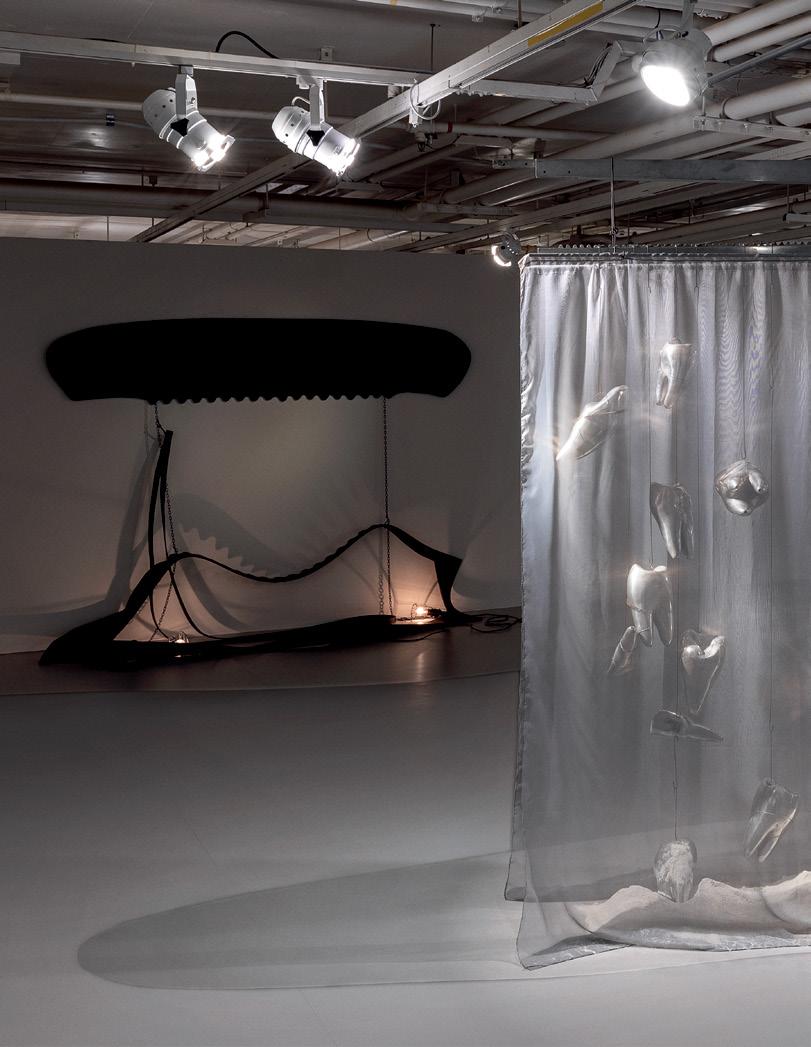
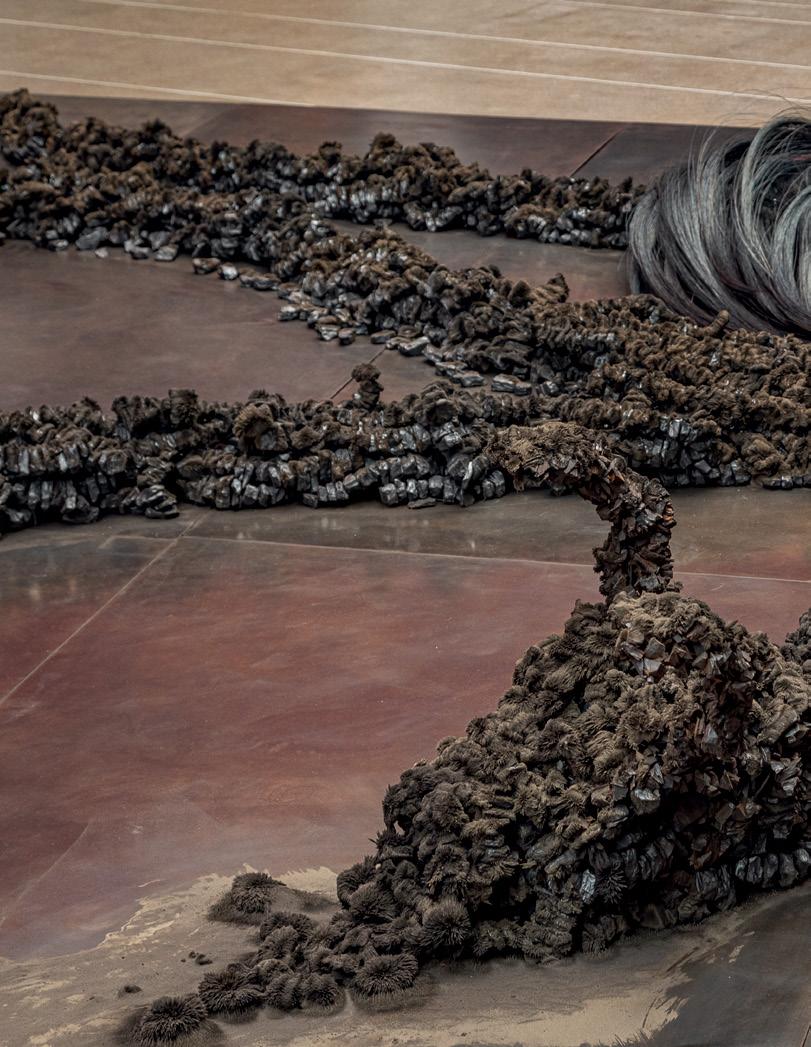
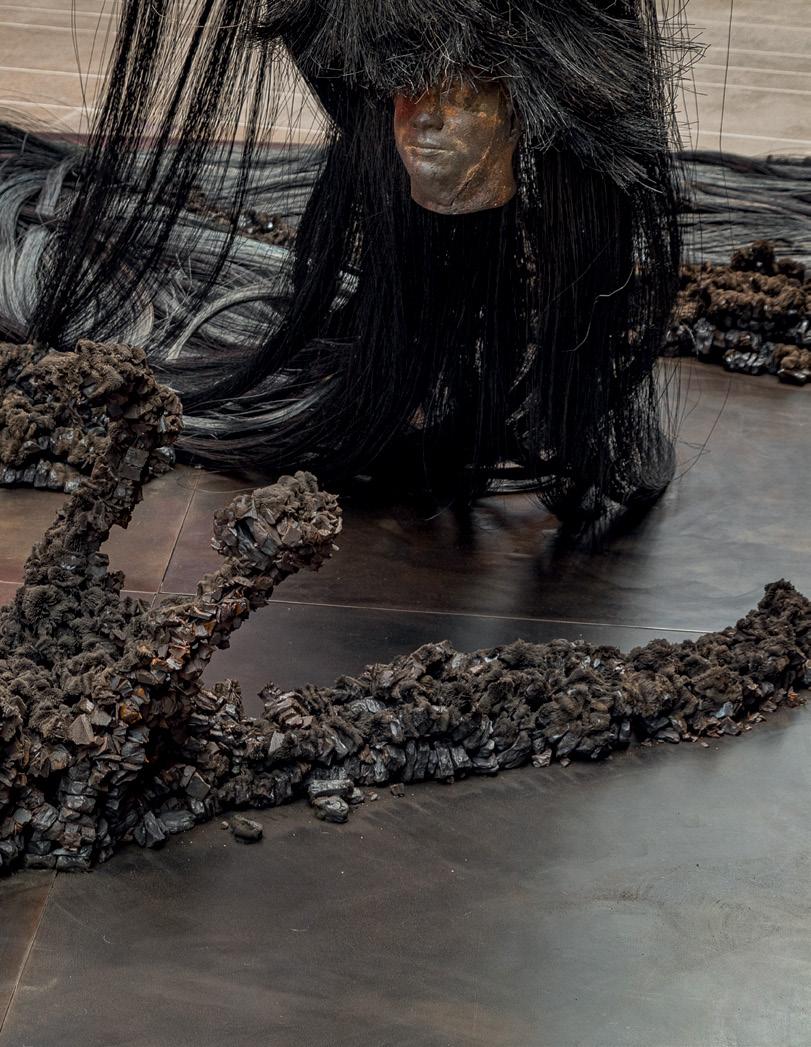
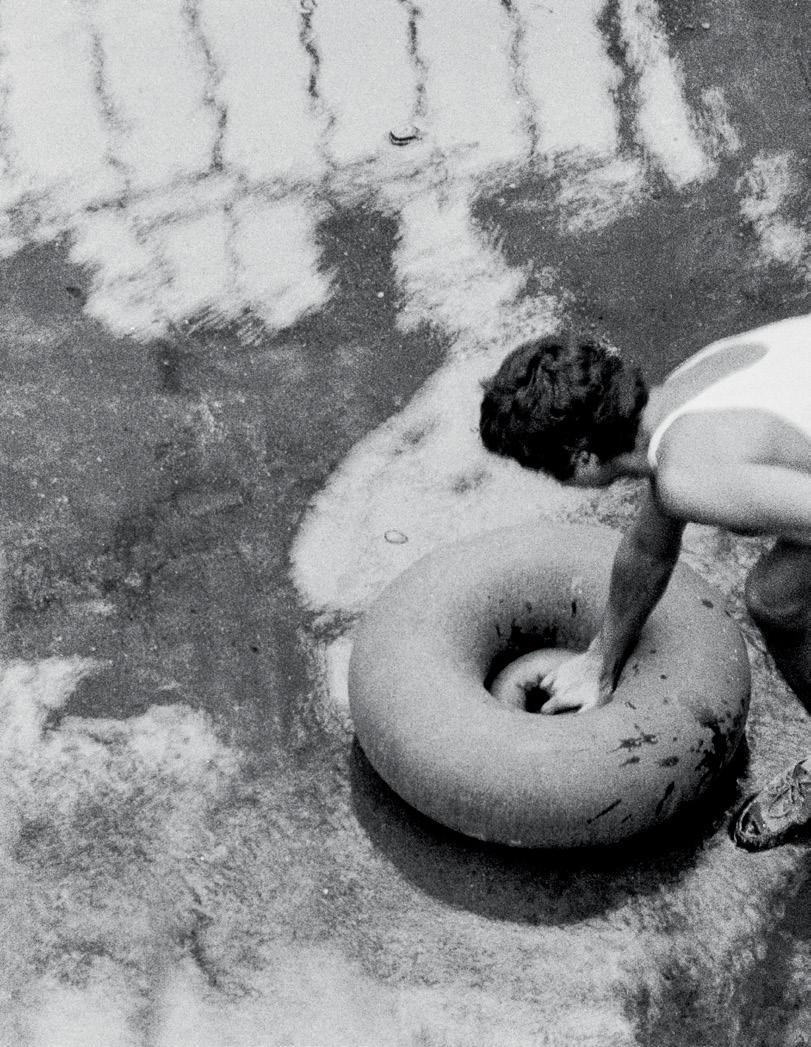
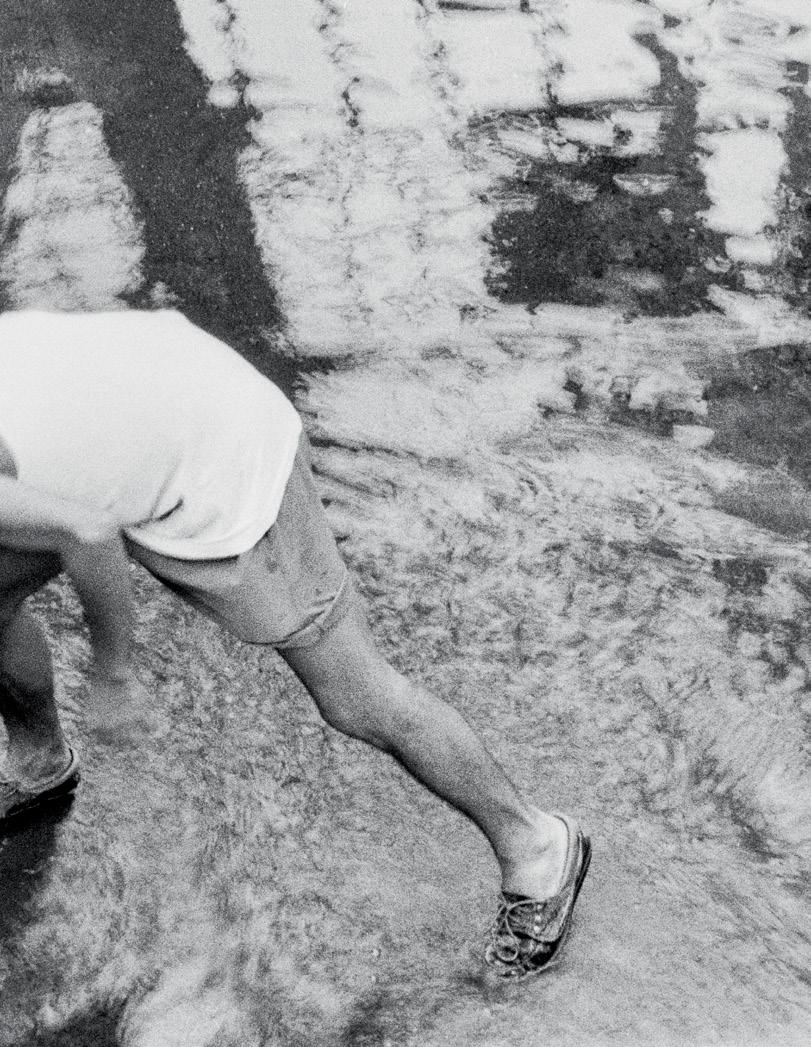
pp. 2-3 pp. 8-9 pp. 14-15 p. 16 p. 44 p. 55 p. 56 pp. 59-63
Retrato do artista | portrait of the artist. Foto | photo: Gabi Carrera
Tunga em frente à projeção de Ão | Tunga in front of a projection of Ão. Foto | photo: Daniela Paoliello
Tunga manipula o Objeto do Conhecimento Infantil | Tunga handling the Objeto do Conhecimento Infantil Foto | photo: Renato Laclette
Tunga fazendo TaCaPe | Tunga making TaCaPe Fundição Progresso, Rio de Janeiro, 1985 Foto | photo: Lucia Helena Zaremba
Escultura Trança na casa do artista, 2016 | the sculpture Trança at the artist’s house, 2016. Foto | photo: Lucia Helena Zaremba
Detalhe da obra | details of Gravitação Magnética, 1987 ferro fundido, fio de ferro, limalha de ferro sobre placas de ferro | cast iron, iron wire, iron filings on iron plates dimensões variáveis | variable dimensions (19 x 9 m) Acervo | collection Instituto Tunga Foto | photo: Renato Parada/Itaú Cultural
Tunga trabalhando na montagem da escultura da série Albinos | Tunga working on the setup of a sculpture from the Albinos series. Foto | photo: Gabi Carrera Acervo | collection Instituto Tunga
Imagens do espaço expositivo da mostra Tunga: conjunções magnéticas | Images of the exhibition space of Tunga: magnetic conjunctions Foto | photo: Renato Parada/Itaú Cultural
pp. 92-95 pp. 116-119
Imagens do espaço expositivo da mostra Tunga: conjunções magnéticas | Images of the exhibition space of Tunga: magnetic conjunctions Foto | photo: Renato Parada/Itaú Cultural
Imagens do espaço expositivo da mostra Tunga: conjunções magnéticas | Images of the exhibition space of Tunga: magnetic conjunctions Foto | photo: Renato Parada/Itaú Cultural
p. 197 pp. 198-199
pp. 140-141 p. 146 p. 168 p. 171 p. 172 pp. 200-201 pp. 209-212
Imagem do espaço expositivo da mostra Tunga: conjunções magnéticas, no Instituto Tomie Ohtake | Image of the exhibition space of Tunga: magnetic conjuctions at Instituto Tomie Ohtake Foto | photo: Renato Parada/Itaú Cultural
Tunga atrás de um dos tantos “tipitis” que usou em suas obras | Tunga behind one of the many “tipitis” he used in his works. Foto | photo: Romulo Fialdini/Tempo Composto
Retrato do artista | portrait of the artist. Foto | photo: Gabi Carrera
Imagem do espaço expositivo da mostra Tunga: conjunções magnéticas | Image of the exhibition space of Tunga: magnetic conjunctions Foto | photo: Renato Parada/Itaú Cultural
Tunga Experiência de Fina Física Sutil, retrato feito em Nova York | portrait took in New York, 1996 Foto | photo: Lucia Helena Zaremba
Imagem do espaço expositivo da mostra Tunga: conjunções magnéticas | Image of the exhibition space of Tunga: magnetic conjunctions Foto | photo: Renato Parada/Itaú Cultural
Imagem do espaço expositivo da mostra Tunga: conjunções magnéticas, no Instituto Tomie Ohtake | Image of the exhibition space of Tunga: magnetic conjunctions at Instituto Tomie Ohtake Foto | photo: Renato Parada/Itaú Cultural
Tunga e a obra Toro, 1985 | Tunga and the work Toro, 1985. Fundição Progresso, Rio de Janeiro Foto | photo: Lucia Helena Zaremba
Imagens do espaço expositivo da mostra Tunga: conjunções magnéticas | Images of the exhibition space of Tunga: magnetic conjunctions Foto | photo: Renato Parada/Itaú Cultural
capa | cover Sem título, da série | Untitled, from the series Gravitação Magnética, ca. 1980 aguada sobre papel | watered-down ink on paper 32,9 x 48,2 cm
Acervo | collection Instituto Tunga Reprodução | reproduction: Gabi Carrera
verso da capa | back cover Sem título | Untitled, 1985-1987 aguada e monotipia sobre papel | watered-down ink and monotype on paper 95 x 68 cm
Acervo | collection Instituto Tunga Reprodução | reproduction: Gabi Carrera
Renato Parada/Itaú Cultural: 22-79 e | and 81-136
Gabi Carrera: 80
| PUBLISHING STAFF
COORDENAÇÃO EDITORIAL | EDITORIAL COORDINATION
Carlos Costa
CONSELHO EDITORIAL | EDITORIAL BOARD
Juliano Ferreira, Luciana Rocha, Nicole Plascak, Paulo Venancio Filho e | and Sofia Fan
PRODUÇÃO EDITORIAL | EDITORIAL PRODUCTION
Lívia G. Hazarabedian (terceirizada | outsourced)
PESQUISA DE IMAGEM | IMAGE RESEARCH
Luciana Rocha e | and Nicole Plascak
EDIÇÃO DE TEXTO | TEXT EDITING
Maria Clara Matos (terceirizada | outsourced)
SUPERVISÃO DE REVISÃO | PROOFREADING SUPERVISION
Polyana Lima
REVISÃO | PROOFREADING
Raquel Reis (português | Portuguese) e | and Regina Stocklen (português e inglês | Portuguese and English) (terceirizadas | both outsourced)
TRADUÇÃO | TRANSLATION
John Norman (terceirizado | outsourced)
PROJETO GRÁFICO E DIAGRAMAÇÃO | BOOK DESIGN AND LAYOUT
Mily Mabe
ASSISTENTE DE DIAGRAMAÇÃO | DESIGN ASSISTANT
Liane Iwahashi (terceirizada | outsourced)
TRATAMENTO DE IMAGENS | IMAGE TREATMENT
André Seiti, Matheus Castro (estagiário | intern) e | and Humberto Pimentel (terceirizado | outsourced)
PRODUÇÃO GRÁFICA | GRAPHIC PRODUCTION
Lilia Góes (terceirizada | outsourced)
TUNGA: CONJUNÇÕES MAGNÉTICAS
CONCEPÇÃO E REALIZAÇÃO | CONCEPTION AND REALIZATION
Itaú Cultural e | and Instituto Tunga
PARCERIA | PARTNERSHIP Instituto Tomie Ohtake
CURADORIA | CURATORSHIP Paulo Venancio Filho
PESQUISADORA ASSISTENTE | ASSISTANT RESEARCHER Julia Cavalcante
PROJETO EXPOGRÁFICO | EXHIBITION DESIGN Isa Gebara
PROJETO DE ACESSIBILIDADE | ACCESSIBILITY DESIGN Itaú Cultural
ITAÚ CULTURAL
PRESIDENTE | PRESIDENT
Alfredo Setubal
DIRETOR | DIRECTOR
Eduardo Saron
NÚCLEO DE ARTES VISUAIS | DEPARTMENT OF VISUAL ARTS
GERÊNCIA | MANAGER
Sofia Fan
COORDENAÇÃO | COORDINATOR
Juliano Ferreira
PRODUÇÃO EXECUTIVA | EXECUTIVE PRODUCTION
Luciana Rocha e | and Nicole Plascak
NÚCLEO DE AUDIOVISUAL E LITERATURA | DEPARTMENT OF AUDIOVISUAL SERVICES AND LITERATURE
GERÊNCIA | MANAGER
Claudiney Ferreira
COORDENAÇÃO | COORDINATOR
Kety Fernandes Nassar
PRODUÇÃO EXECUTIVA | EXECUTIVE PRODUCTION
Paula Bertola
PRODUÇÃO AUDIOVISUAL | AUDIOVISUAL PRODUCTION
Ana Paula Fiotto
CAPTAÇÃO E EDIÇÃO | FILMING AND EDITING
Richner Allan
CAPTAÇÃO REMOTA | REMOTE CAPTURE
VOCS.TV (terceirizada | outsourced)
CAPTAÇÃO E EDIÇÃO DE IMAGENS ADICIONAIS
CAPTURE AND EDITING OF ADDITIONAL IMAGES
Olhar Periférico Filmes (terceirizada | outsourced)
ANIMAÇÃO | MOTION DESIGN
João Zanetti (terceirizado outsourced)
TRILHAS MUSICAIS | MUSIC TRACKS
Chaos de Ruiqi Zhao e and New World de Ian Post (Artlist) (terceirizados | both outsorced)
TRANSCRIÇÃO | TRANSCRIPTION
Nelson Visconti (terceirizado | outsourced)
TRADUÇÃO | TRANSLATION
John Norman (terceirizado | outsourced)
INTERPRETAÇÃO EM LIBRAS | BRAZILIAN SIGN
LANGUAGE INTERPRETATION
FFomin Acessibilidade e Libras (terceirizada outsourced)
LOCUÇÃO | VOICEOVER
Casa das Vozes (terceirizada | outsourced)
NÚCLEO DE EDUCAÇÃO E RELACIONAMENTO |
DEPARTMENT OF EDUCATION AND RELATIONSHIP
GERÊNCIA | MANAGER
Valéria Toloi
COORDENAÇÃO DE ATENDIMENTO AO PÚBLICO |
PUBLIC SERVICE COORDINATOR
Tayná Menezes
EQUIPE | TEAM
Amanda Freitas, Caroline Faro, Matheus Paz, Natasha Marcondes,
Victor Soriano e | and Vinícius Magnun
COORDENAÇÃO DE FORMAÇÃO | COORDINATOR OF EDUCATION SERVICES
Samara Ferreira
EQUIPE | TEAM
Alessandra Constantini (estagiária | intern), Edinho dos Santos,Edson
Bismark, Elissa Sanitá, Joelson Oliveira, Lucas Batista, Mayra Reis
Rocha, Mônica Abreu Silva, Silas Barbosa (estagiário | intern), Tonne de Andrade, Victória de Oliveira, Vítor Luz e | and Vitor Narumi
NÚCLEO DE INFRAESTRUTURA E PRODUÇÃO |
DEPARTMENT OF PRODUCTION AND INFRASTRUCTURE
GERÊNCIA | MANAGER
Gilberto Labor
COORDENAÇÃO DE EXPOSIÇÕES | EXHIBITIONS COORDENATOR
Vinícius Ramos
PRODUÇÃO | PRODUCTION
Carmen Fajardo, Fábio Marotta, Priscila Tavares, Tailane Felix dos
Santos Matos (estagiária | intern) e | and Wanderley Bispo
NÚCLEO DE COMUNICAÇÃO E RELACIONAMENTO |
DEPARTMENT OF COMUNICATION AND RELATIONSHIP
GERÊNCIA | MANAGER
Ana de Fátima Sousa
COORDENAÇÃO | COORDINATOR
Carlos Costa
PRODUÇÃO EDITORIAL | EDITORIAL PRODUCTION
Pamela Rocha Camargo
PRODUÇÃO E EDIÇÃO DE CONTEÚDO |
CONTENT EDITING AND PRODUCTION
Amanda Rigamonti e | and Isabella Candido da Silva (estagiária | intern)
SUPERVISÃO DE REVISÃO | PROOFREADING SUPERVISION
Polyana Lima
REVISÃO | PROOFREADING
Karina Hambra e | and Rachel Reis (terceirizadas | both outsourced)
TRADUÇÃO | TRANSLATION
John Norman (terceirizado | outsourced)
PROJETO GRÁFICO E COMUNICAÇÃO VISUAL |
GRAPHIC DESIGN AND VISUAL COMMUNICATION
Mily Mabe
REDES SOCIAIS | SOCIAL MEDIA
Jullyanna Salles e | and Renato Corch
NÚCLEO DE ACERVO | DEPARTMENT OF COLLECTION
GERÊNCIA | MANAGER
Fúlvia Sannuto
COORDENAÇÃO | COORDINATOR
Edson Martins Cruz
PRODUÇÃO | PRODUCTION
Angélica Pompílio, Bruno Struzani, Fernanda Simony, Emmanuelly de Jesus, Naiade Margonar e | and Vânia Mamede
JURÍDICO | LEGAL
GERÊNCIA | MANAGER
Anna Paula Montini
COORDENAÇÃO | COORDINATOR
Daniel Lourenço
EQUIPE | TEAM
Ana Carolina Marossi e | and Matheus Matos
INSTITUTO TUNGA
DIRETOR EXECUTIVO | EXECUTIVE DIRECTOR
Antônio Mourão
GESTORA DO ACERVO | COLLECTION MANAGER
Clara Gerchman
DIRETOR DE PRODUÇÃO | PRODUCTION DIRECTOR
Fernando C. Sant’anna
GERENTE DE PRODUÇÃO | PRODUCTION MANAGER
Leonardo Guimarães
MUSEÓLOGAS | MUSEOLOGISTS
Fabiana Motta e | and Ingrid Illner
PESQUISA | RESEARCH
Beatriz Coslovsky
ASSISTENTE ADMINISTRATIVA | ADMINISTRATIVE ASSISTANT
Renata Moledo
AUXILIAR DE SERVIÇOS GERAIS | GENERAL SERVICES ASSISTANT
Marilene Silva
ASSISTENTE DE PRODUÇÃO | PRODUCTION ASSISTANT
Cosmo Tomé da Silva
AUXILIARES DE PRODUÇÃO | PRODUCTION HELPERS
Alex Medeiros e | and Denilo Rodrigues
INSTITUTO TOMIE OHTAKE
PRESIDENTE ESTATUTÁRIO | STATUTORY PRESIDENT
Ricardo Ohtake
NÚCLEO DE PESQUISA E CURADORIA | RESEARCH AND CURATORSHIP
CURADOR-CHEFE | CHIEF CURATOR
Paulo Miyada
EQUIPE | TEAM
Ana Paula Lopes e | and Priscyla Gomes
NÚCLEO DE PRODUÇÃO DE EXPOSIÇÕES E PROJETOS | EXHIBITION AND PROJECT PRODUCTION
DIRETORA | DIRECTOR
Vitoria Arruda
EQUIPE | TEAM
André Luiz Bella, Camila Silva, Carolina Pasinato, Karina Mignoni, Ligia Pedra, Lucas Fabrizzio e | and Rodolfo Borbel Pitarello
NÚCLEO DE CULTURA E PARTICIPAÇÃO | CULTURE AND PARTICIPATION
DIRETOR | DIRECTOR
Claudio Bueno
EQUIPE | TEAM
Agata Takiya, Bruno Ferrari, Claudio Rubino, Dara Roberto, Fernanda Beraldi, Isadora Mellado, Jane Santos, Jordana Braz, Luara Alves, Natália Vinhal, Natame Diniz, Pedro Costa, Renata Araújo, Vera Nunes e | and Victor Constantino
ADMINISTRAÇÃO E DESENVOLVIMENTO INSTITUCIONAL | ADMINISTRATION AND INSTITUTIONAL DEVELOPMENT
DIRETOR | DIRECTOR
Victor Ladeira
Bruno Damaceno, Carlito Oliveira Junior, Tatiane Romani, Willian dos Santos e | and Yago Morai
Flávio Silva, Marcy Junqueira, Martim Pelisson, Ricardo Miyada e | and Vaneska Rezende
ASSESSORIA DE IMPRENSA | PRESS RELATIONS
Pool de Comunicação
Museu de Arte Moderna de São Paulo, Museu de Arte do Rio, Álea Santos, Alex Medeiros, Alice Tischer, Antônio Mourão, Beatriz Coslovsky, Christina Penna, Clara Gerchman, Cosmo Tomé da Silva, Daniele Santos, Denilo Rodrigues, Di Grecco Indústria Têxtil Ltda., Fabiana Motta, Fernando Sant´Anna, Gonçalo Mello Mourão, Humberto Farias, Ingrid Ilner, João Marcelo Struchi, Juliana Amorim, Leonardo Guimarães, Lia Rodrigues, Lino Pedro Garcia Morales, Luzia Ribeiro da Costa, Marilene Silva, Maurício Pereira, Patrícia Salles, Paulo Sergio Duarte, Renata Moledo, Samia Jraige, Tanja Baudoin, Vanda Klabin, Waltercio Caldas e todos os colecionadores, as instituições, fotógrafos e cineastas que cederam suas obras para a exposição | and all the collectors, institutions, photographers, filmmakers who lent their works to the exhibition.
O Itaú Cultural (IC) e a curadoria agradecem a todos os fotógrafos que cederam imagens e a todos os artistas, sucessores e colecionadores que autorizaram a exibição e emprestaram suas obras para a exposição. | Itaú Cultural and the curatorship are grateful to all the pho tographers who granted images and to all the artists, successors, and collectors who authorized the exhibition and loaned their works to the exhibition.
O Instituto realizou todos os esforços para encontrar os detentores dos direitos autorais incidentes sobre as imagens/obras aqui expostas e publicadas, além das pessoas fotografadas. Caso alguém se reconheça ou identifique algum registro de sua autoria, solicitamos o contato pelo e-mail atendimento@itaucultural.org.br. |
The institute made every effort to find the holders of copyrights on the photographed images/artworks published here, in addition to the people photographed. If someone recognizes him or herself or identifies some work of his or her authorship, please contact us by e-mail: atendimento@itaucultural.org.br.
O Itaú Cultural, em 2019, passou a integrar a Fundação Itaú para Educação e Cultura, com o objetivo de garan tir ainda mais perenidade às suas ações e o seu legado no mundo da cultura, ampliando e fortalecendo o seu propósito de inspirar o poder criativo para a transfor mação das pessoas. | Since 2019, Itaú Cultural has been integrated into the Itaú Foundation for Education and Culture. Their objective is to ensure the continuity and legacy of culture and to inspire and transform people through creativity.
A exposição Tunga: conjunções magnéticas foi contemplada com o Prêmio Melhores do Ano nas Artes de 2021, da Associação Paulista de Críticos de Arte (APCA), na Categoria Exposição Nacional | The exhibition Tunga: magnetic conjunctions has been awarded the Best of the Year in the Arts Prize of 2021, conferred by the Associação Paulista de Críticos de Arte (APCA), in the National Exhibition Category.
Esta publicação foi composta pelas famílias tipográficas Agrandir e Freight Text. O miolo foi impresso no papel Munken Lynx rough 120g/m2 e Couchê brilho 150g/m2, a capa em Masterblank linho LD 135g/m2 e a sobrecapa em papel vegetal 180g/m2. Mil unidades foram impressas pela Ipsis Gráfica e Editora em maio de 2022.
Itaú Cultural
Tunga: conjunções magnéticas / organização Itaú Cultural, Instituto Tunga, Instituto Tomie Ohtake. - São Paulo : Itaú Cultural ; 2022. 208 p. : il. ; 20,5 x 26,5 cm
ISBN:
1.Tunga. 2.Escultura. 3.Coleção. 4.Museu. I. Instituto Itaú Cultural. III. Título. CDD 069.5
Bibliotecária Geovanna de Barros Kustovich CRB-8/10630

